West End, North Carolina, United States
Bill Coore & Ben Crenshaw (2010)
Par 71, 6,988 Yards
Rating/Slope: 73.4/136
My Quick Review: Easily the Second Best Golf Course in the Pinehurst Area
Club Information (taken from http://dormieclub.net/the-club/):
Bill Coore and Ben Crenshaw’s first original layout in the Tar Heel State is just a short drive north of the Village of Pinehurst where they recently completed the restoration of the Pinehurst Resort’s storied No. 2 course. In 2014, No. 2 will make history as the first ever site to host the Men’s and Women’s United States Open Championships in back-to-back weeks.
The renowned architectural team of Bill Coore and Ben Crenshaw selected 309 of the site’s 1,030 acres to route 18 magical holes. There will be no housing or artificial roadways within the golf course perimeter.
The par 71 course can play 6,984 yards, but has only 68 acres of managed grass. The balance of the site is maintained in natural sand “floors”, wire grasses, pine trees and vegetation native to the Sandhills region.
Scorecard Information

Hole 1: Par 4, 433 Yards
The 1st hole is no easy start. The opening tee shot is one of the most demanding on the course - playing downhill and into the prevailing wind, there is plenty that can go wrong.
The ideal tee shot will be played up the left side of the fairway, which will leave a clearer look at the green. The ideal line is guarded by fairway bunkers and there is a fair bit of room to bailout right. The centreline bunkers are about 320 yards from the tee -- not in play for all but a select few.

The approach is played over a pair of diagonal centreline bunkers whose purpose (I think) are more about visual intimidation and confusion, than penalizing errant shots. Approaches from the left side of the fairway have a preferred view of the green, though perhaps the more difficult angle, depending on pin position.
Approach from right side of fairway.
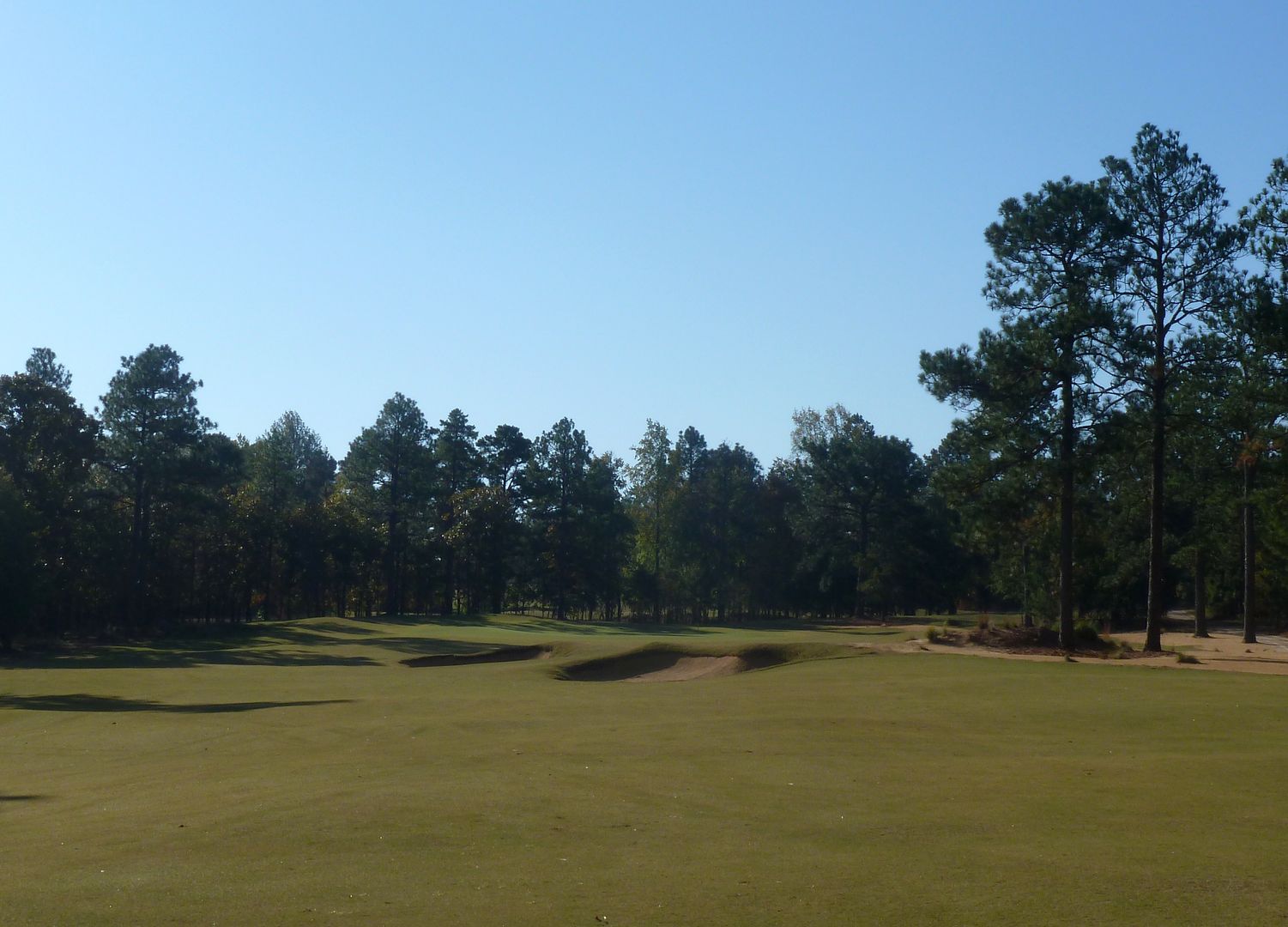
Approach from left side of fairway.
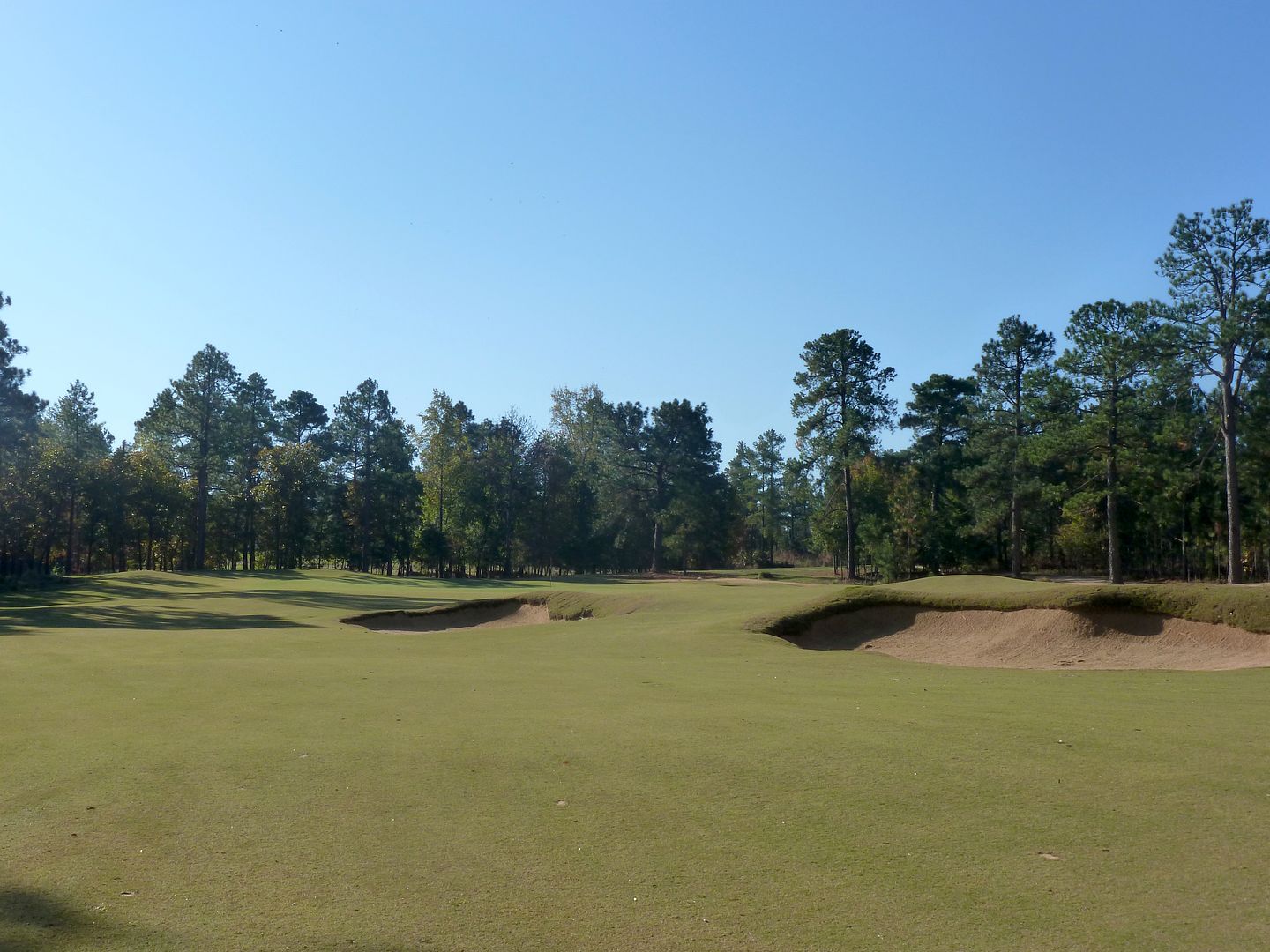
The green is open in front allowing shots to run onto the green. It is difficult to see but there is a very large ridge running through the left side of the green that feeds shots towards the centre. The right portion of the green is flat and welcoming.
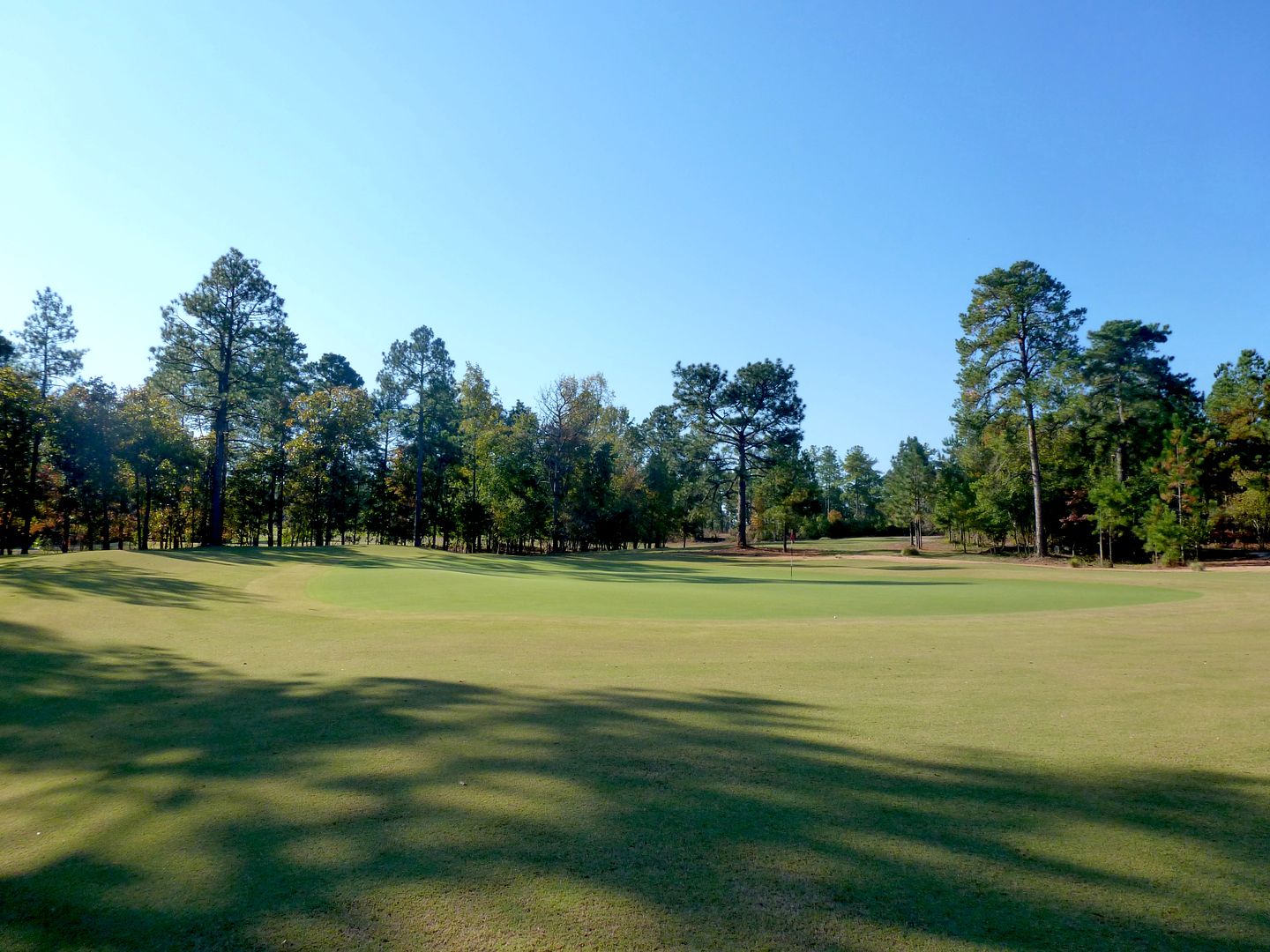
Looking back down the fairway.
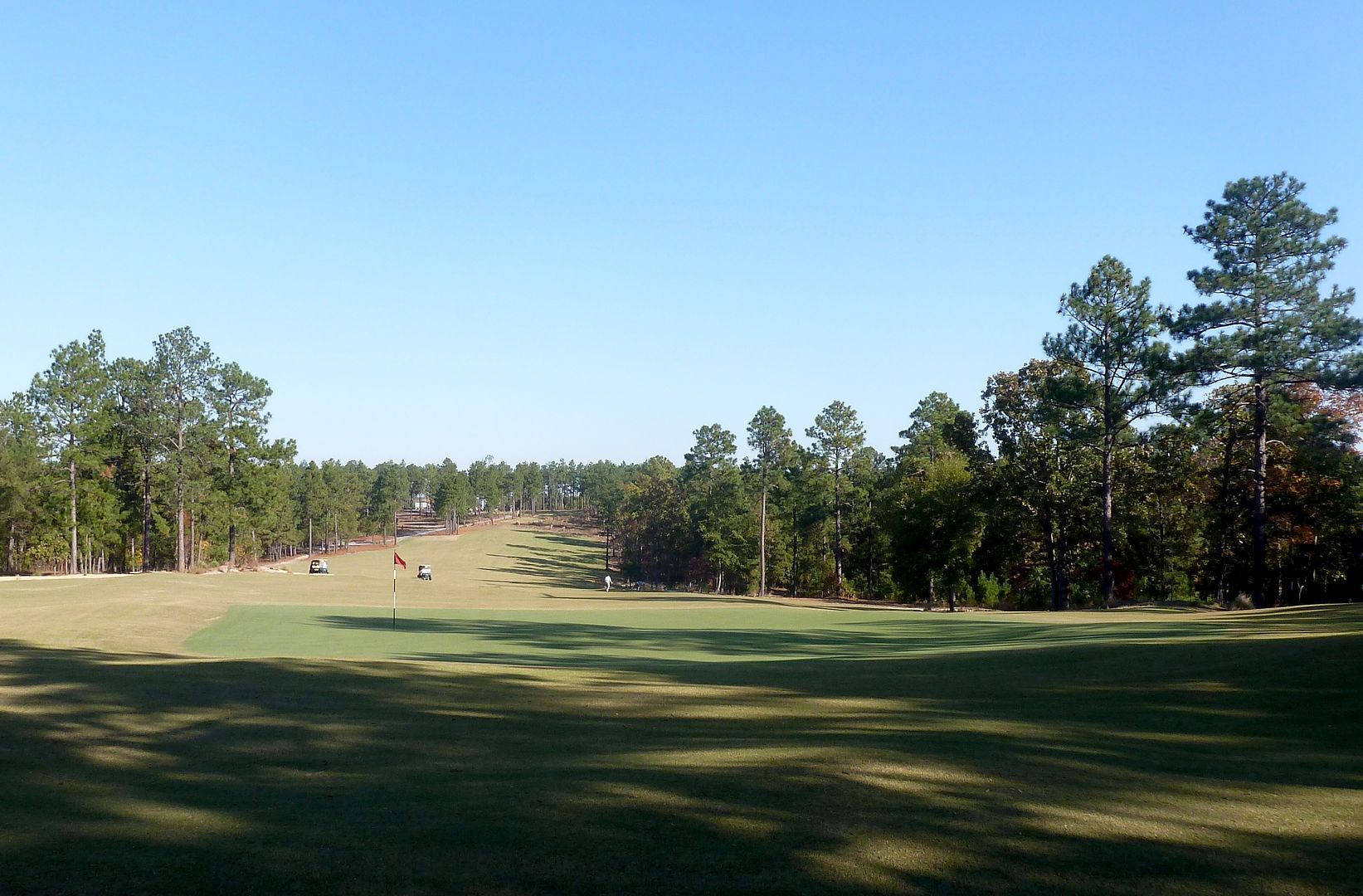
Hole 2: Par 4, 402 Yards
The first of many holes that move left at Dormie. Longer hitters will be able to carry the majority of the bunker on the inside of the dogleg (about 250 yards carry) and will be rewarded with both a shorter approach and a better angle. Shorter hitters can try to hit a draw and take advantage of the significant leftward slope of the fairway.
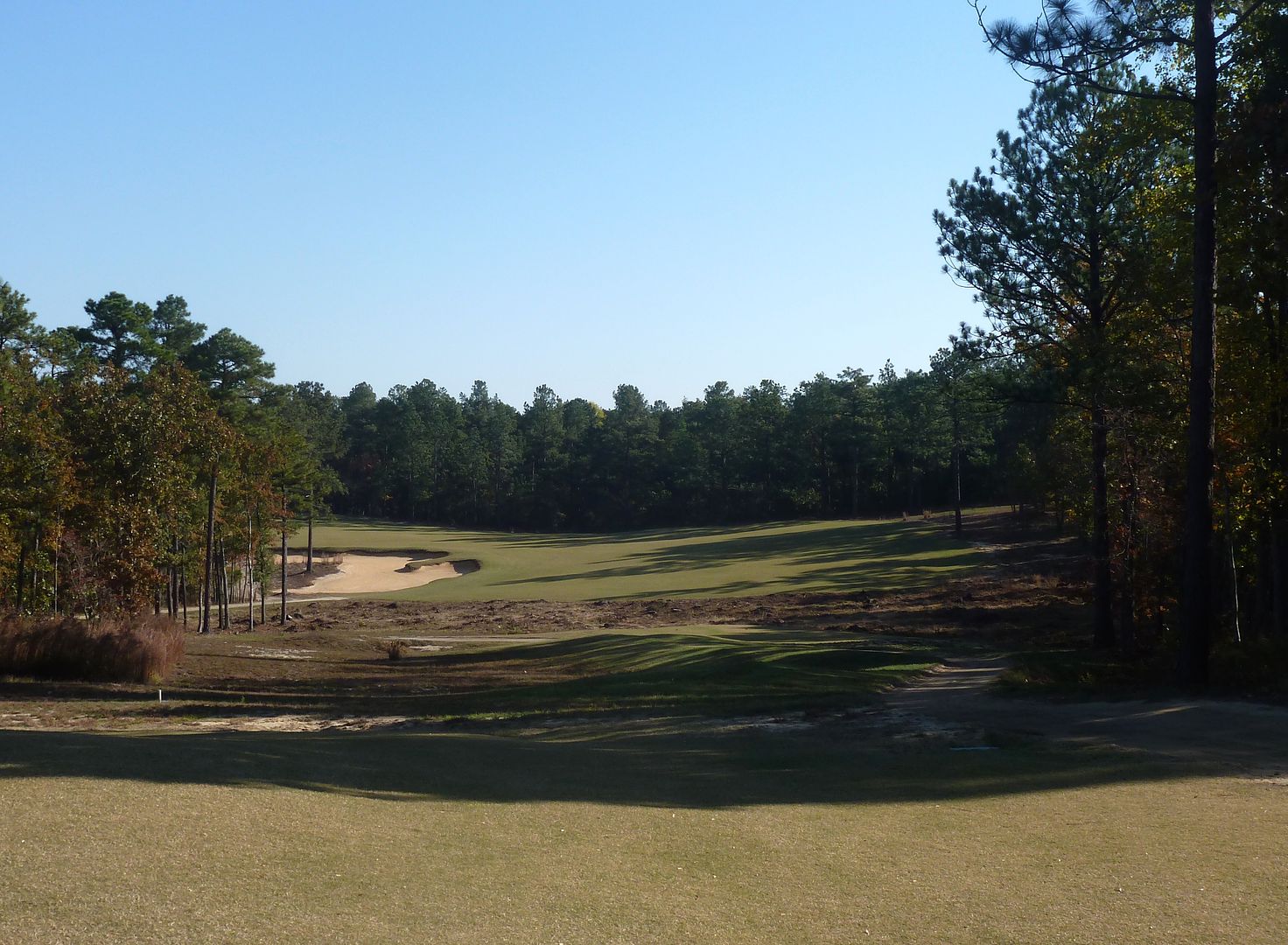

The approach is played slightly uphill to a green that falls-off on the left. A single greenside bunker highlights the importance of the angle into the green. Tee shots that challenge the inside of the dogleg need not carry the bunker on the approach and can be run onto the green. But, approaches from the right must carry the bunker and also run a greater risk of finding the fall-off on the left.
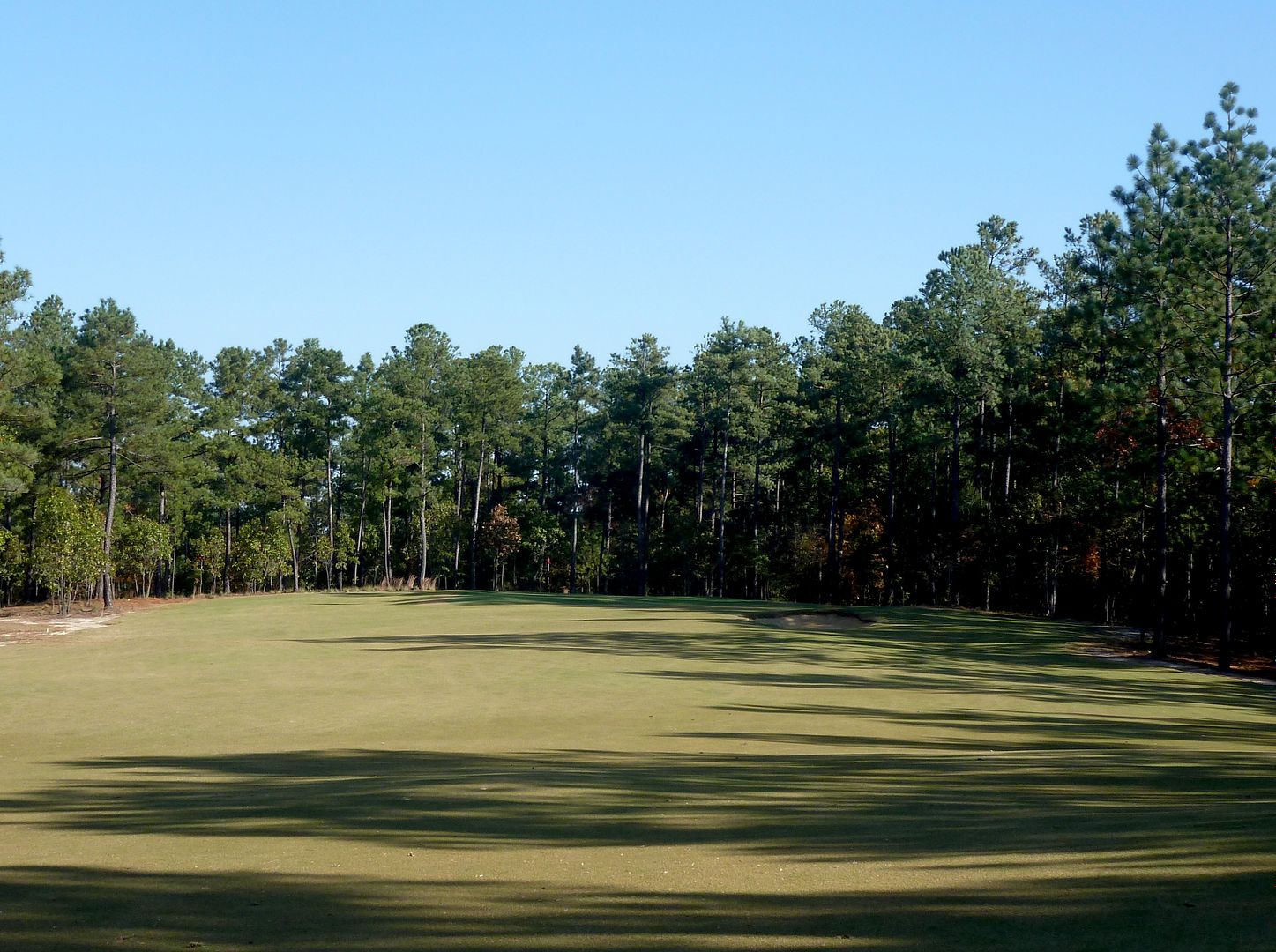
The fall-off to the left of the green.
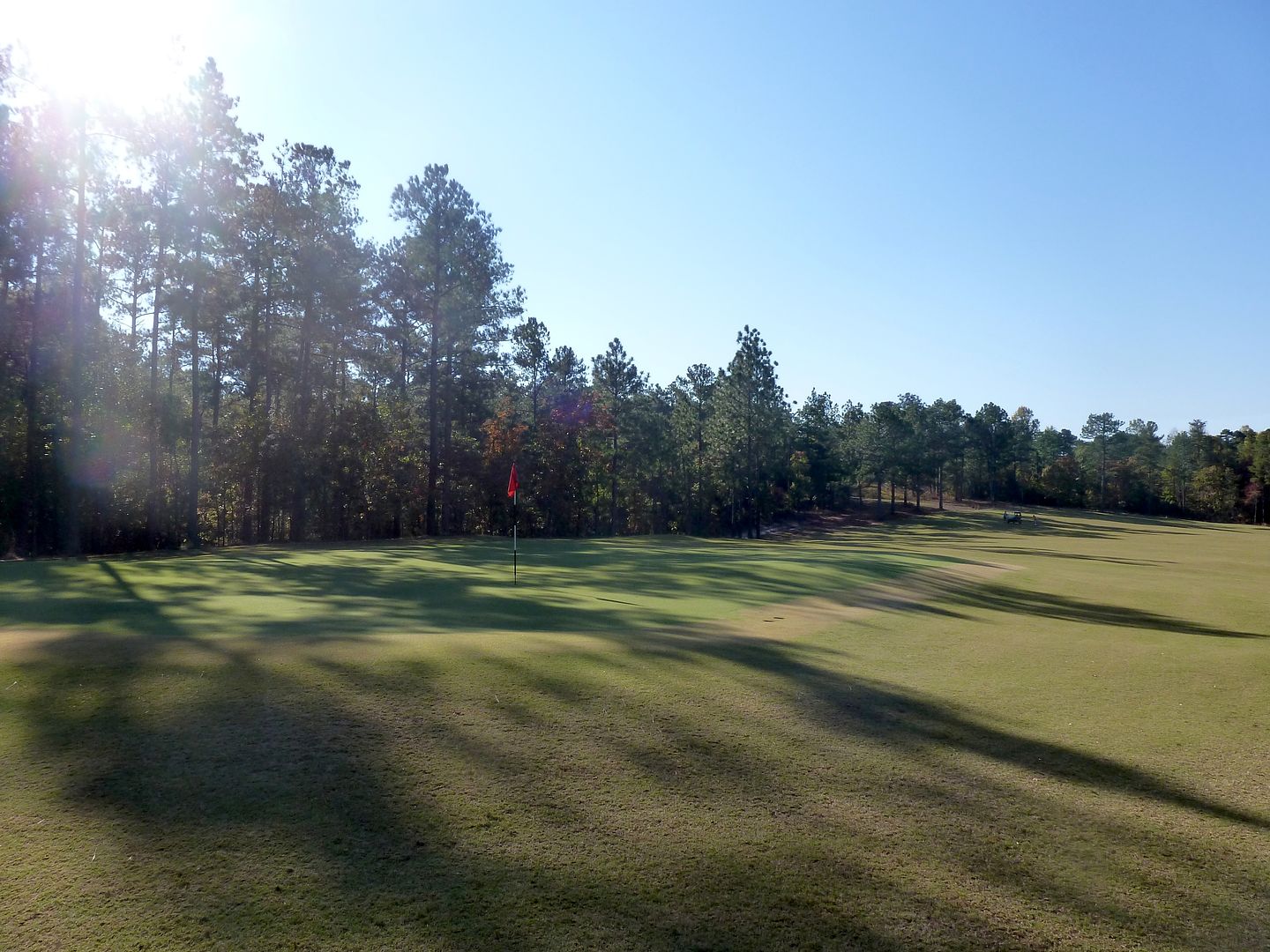
Hole 3: Par 4, 316 Yards
A very good hole. There is LOTS of room to lay-up a tee shot short of the bunker on the right. It is about 210 yards to reach that bunker. Players wanting to be more aggressive may challenge the left side of the fairway, leaving just a pitch into the green.
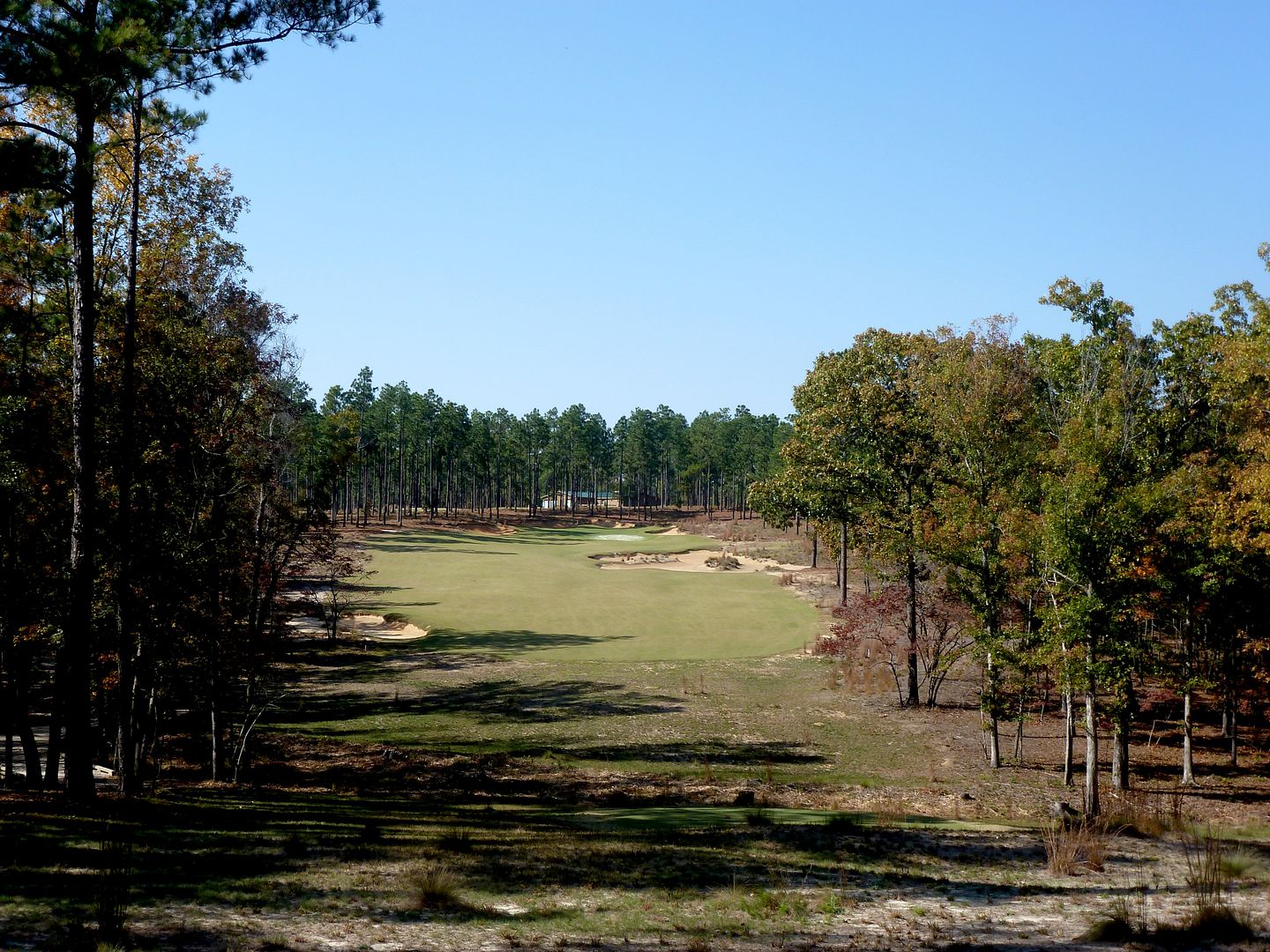
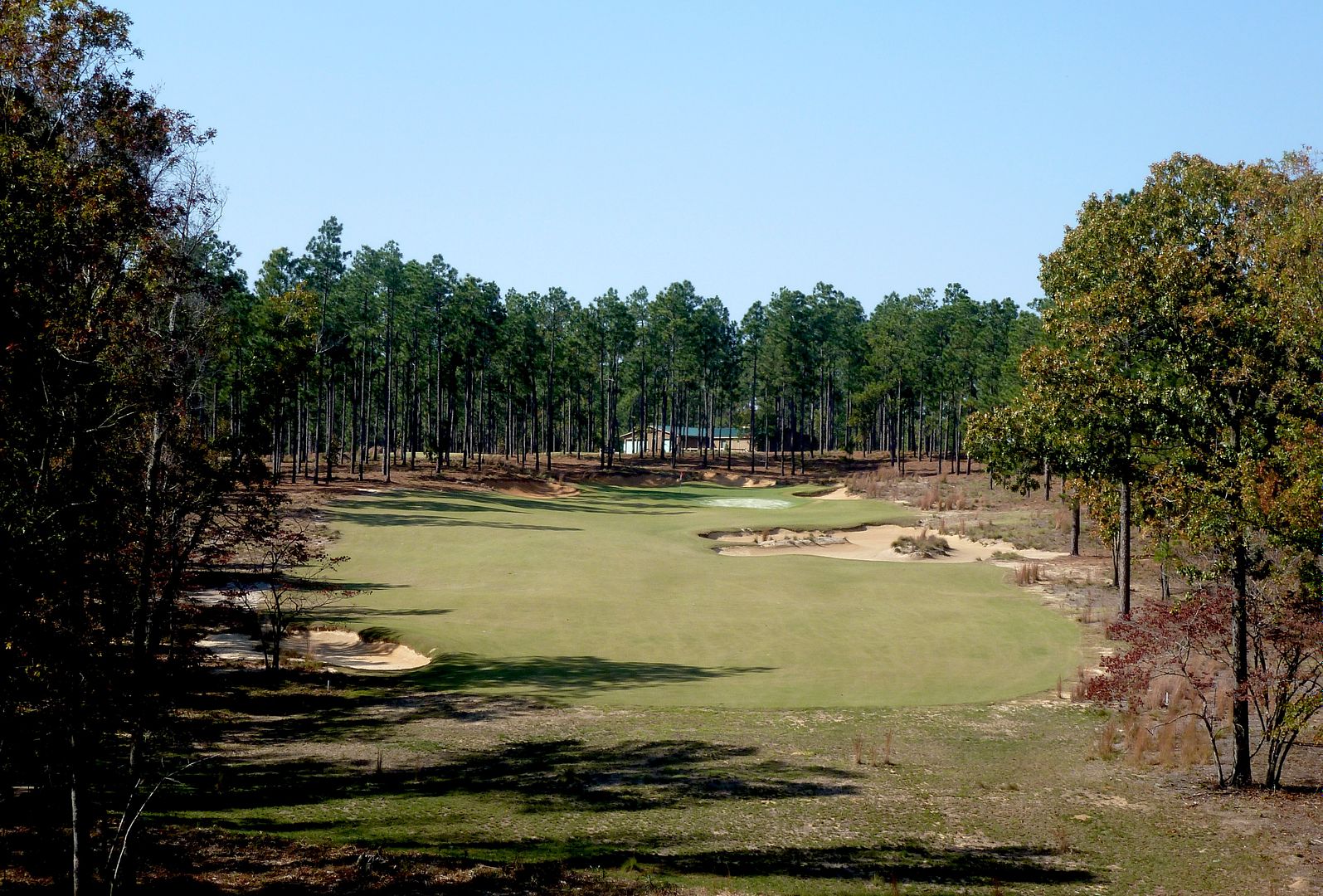
Approach from a lay-up.
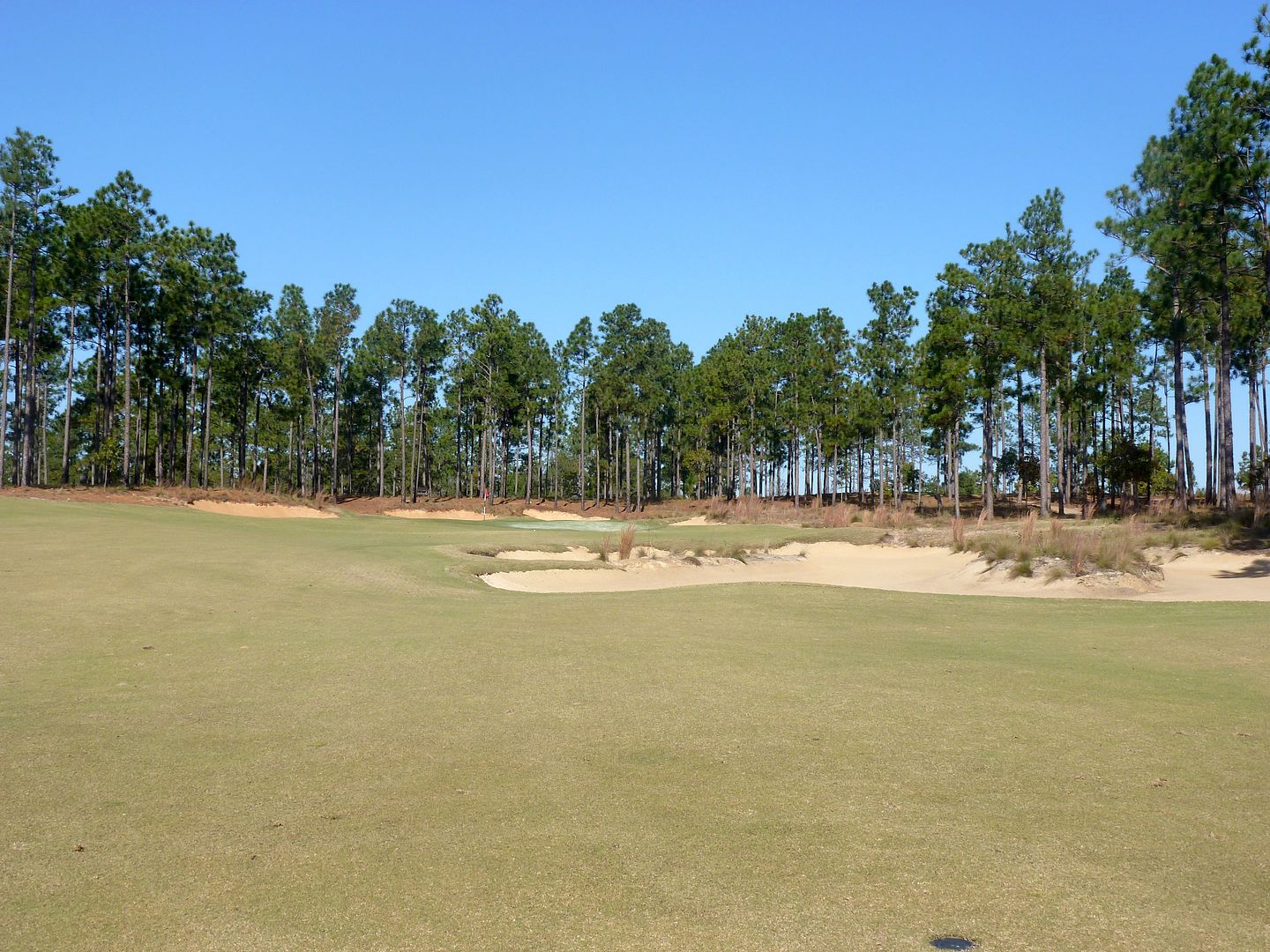
Approach from in the right bunker.

Approach from left.
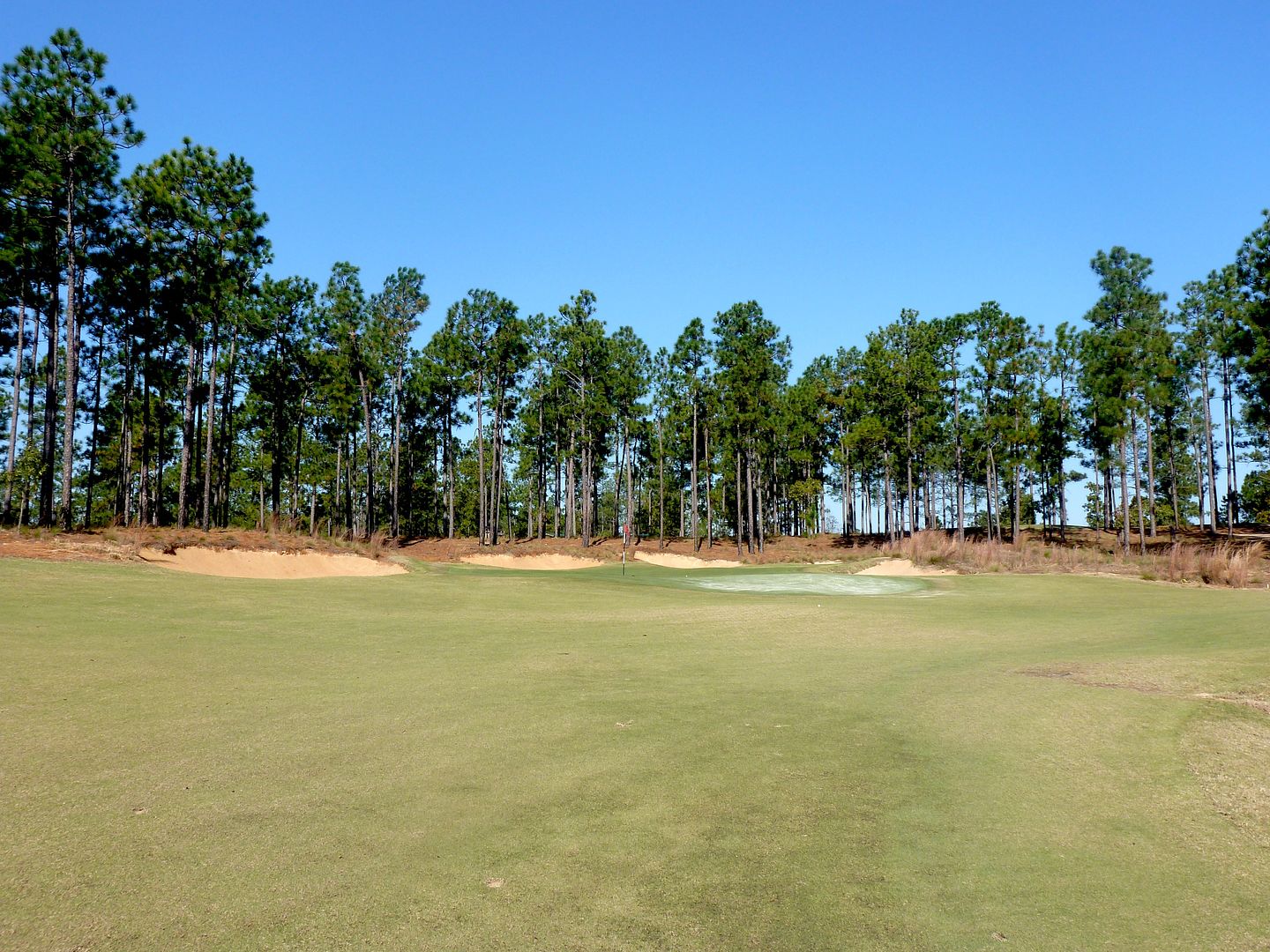
All decisions on this hole, and much of what makes the hole so interesting, is the wildness of the green. Even with the flattening effect of the camera, the slopes look significant. Local knowledge is very important here as there are putts that are impossible. Anything over the ridge to the pin in the picture could not possibly get closer than 15 feet. Fine with me -- other less GCA-inclined members of my group didn't like that.
Green from right.

Green from back-right.

Green from back-right with increased contrast.
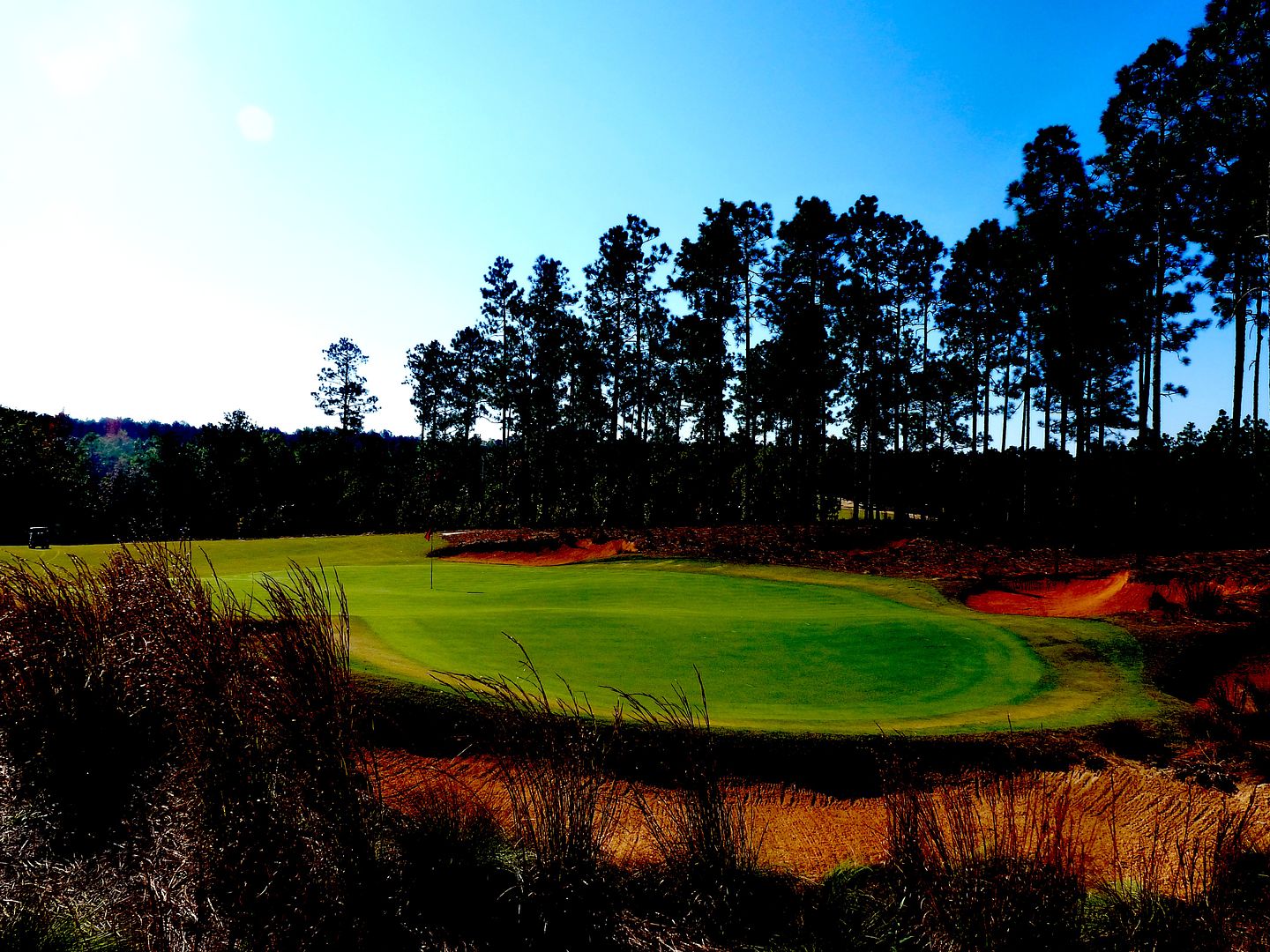
Short of green with increased contrast.
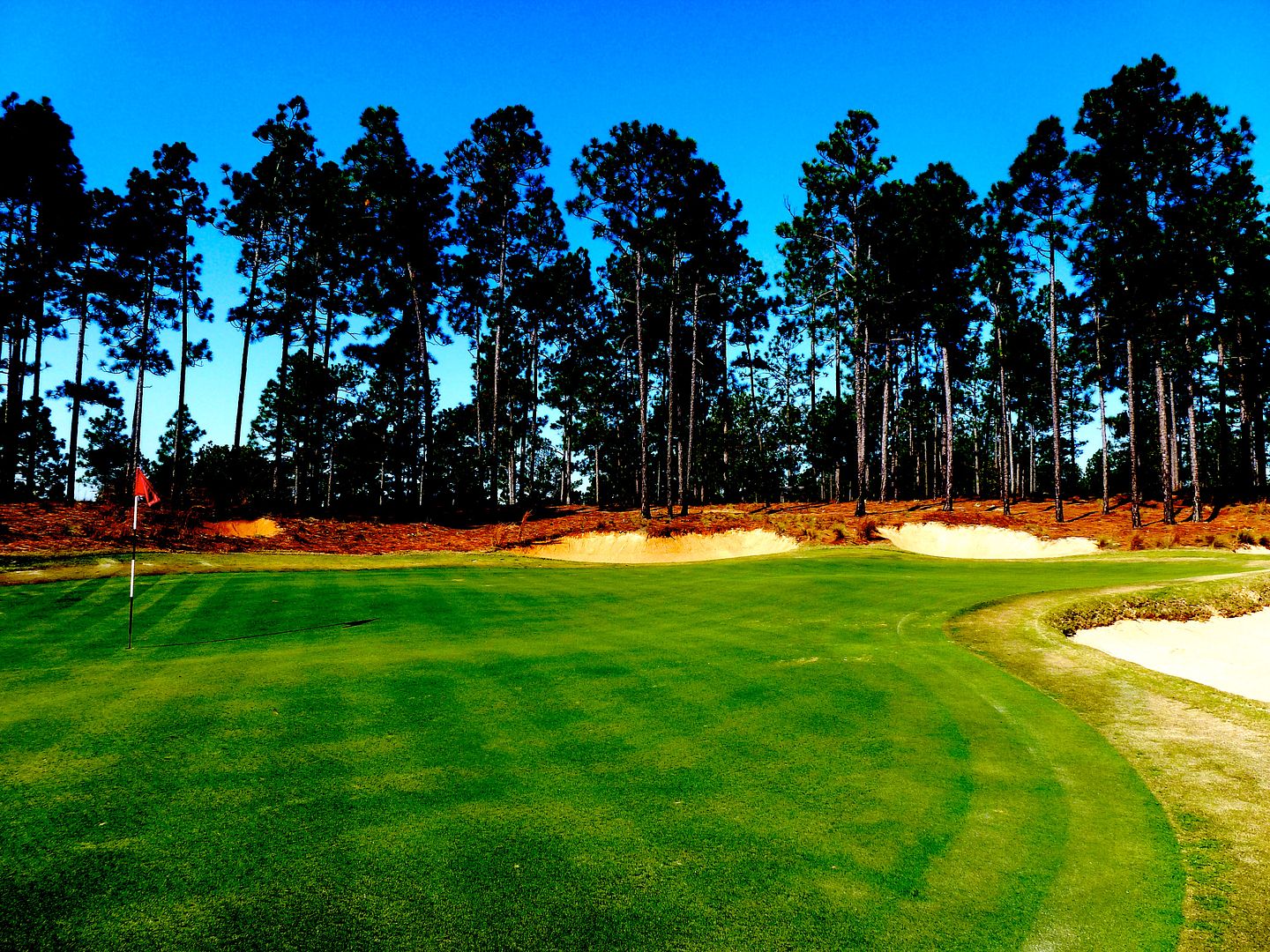
Hole 4: Par 4, 440 Yards
This might be my favorite hole on the course. The hole sweeps significantly from right to left (no surprise there). The hole feels very natural on the land as the favorite dips and rises and slopes significantly to the left. Anything bailed-out too far to the right (it's a pretty long way right) will find some of the scrub/sand. In my limited experience you can be farther right than you think because of the slope of the fairway. Players that are too aggressive off the tee can find a hidden bunker guarding the inside corner of the dogleg.
The view from the back tee just hints at the shape of the hole, but it is a largely blind tee shot.
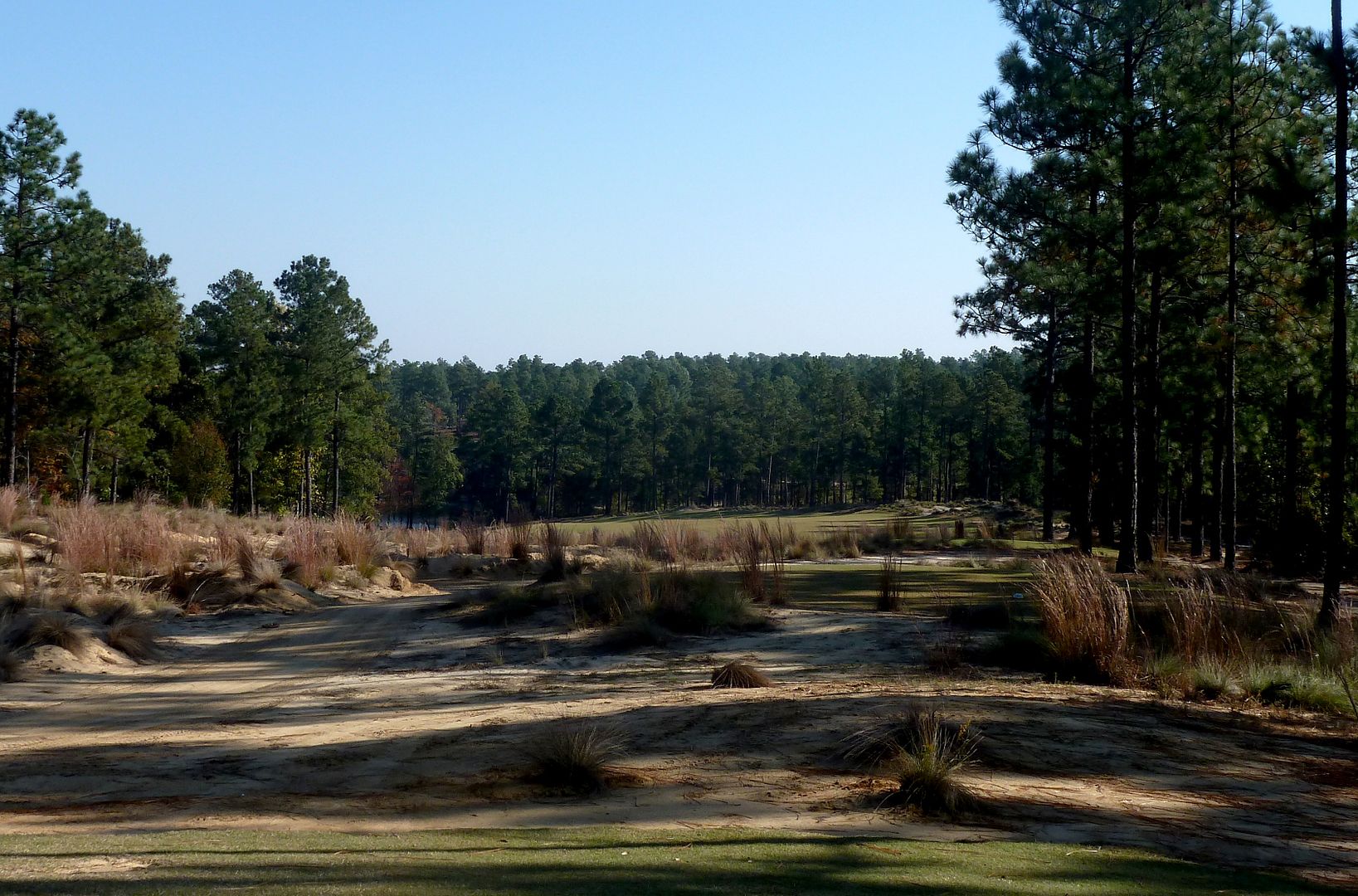
From the white tees one gets a clear look at the entirety of the hole, and a very nice vista of the green and water beyond.
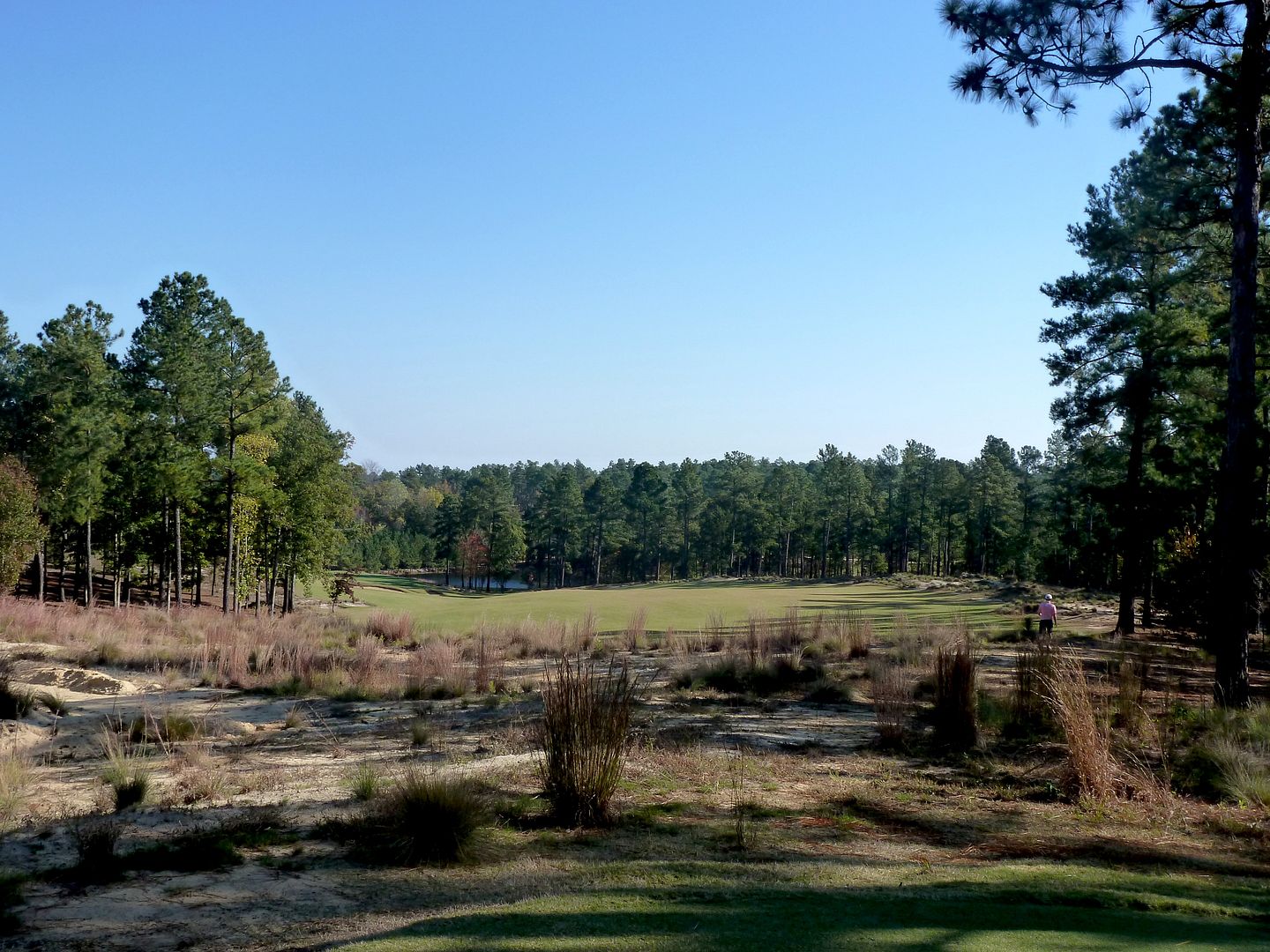
The approach should be nothing more than a short-iron or pitch, despite the length of the hole. After a draw was called-for off the tee, the second is best played with a little fade. Though there is no option to run the ball onto the green as a bunker and false-front protect the front of the green, shots can be played using the slope to the left of the green.
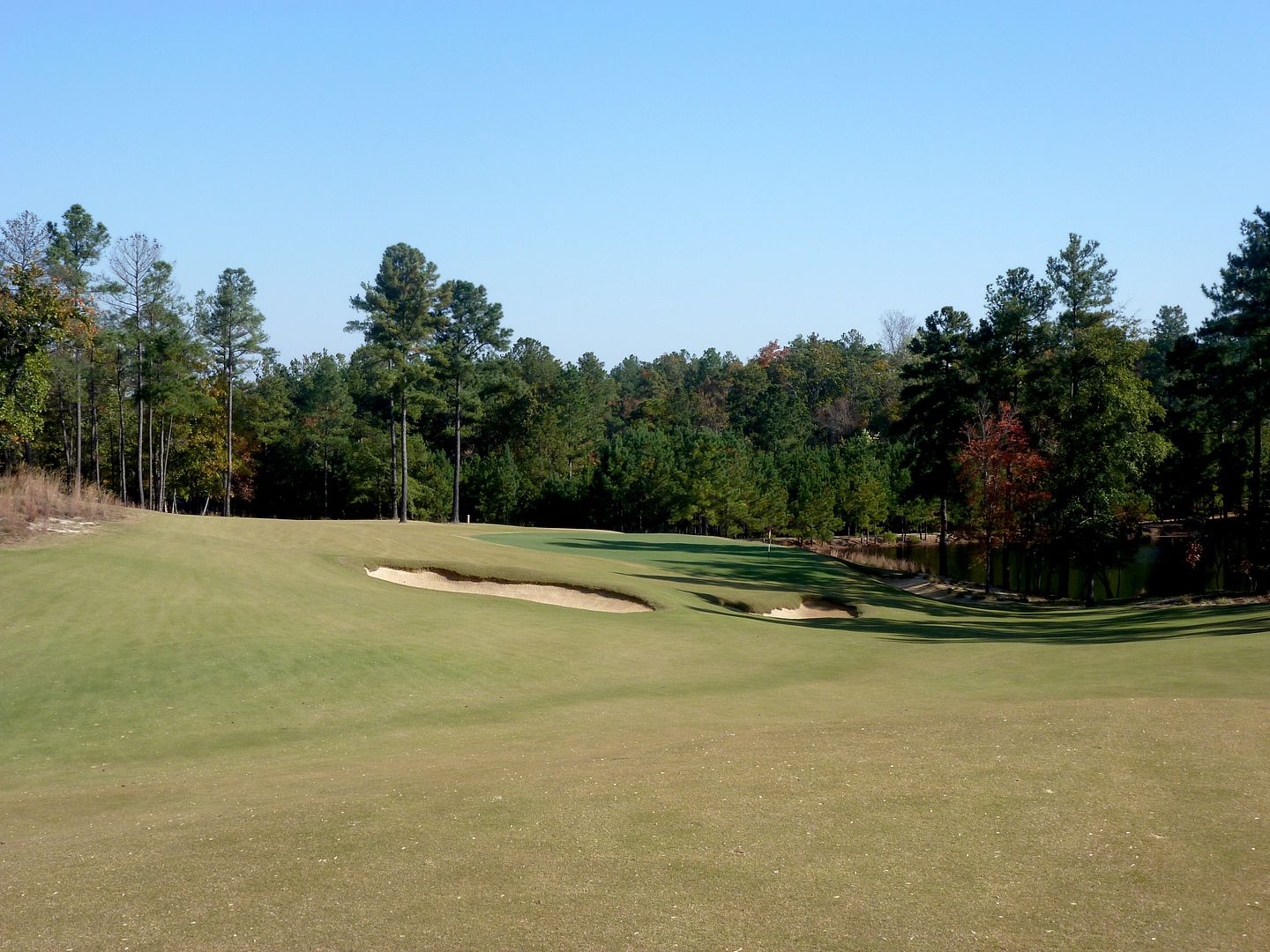
The green slopes very significantly from left to right. The location of the short greenside bunker is nasty -- one shouldn't find the bunker this far short of the green, but if they do they are faced with a bunker shot that requires a long carry to reach the green and a false-front that will funnel bulls off the green.
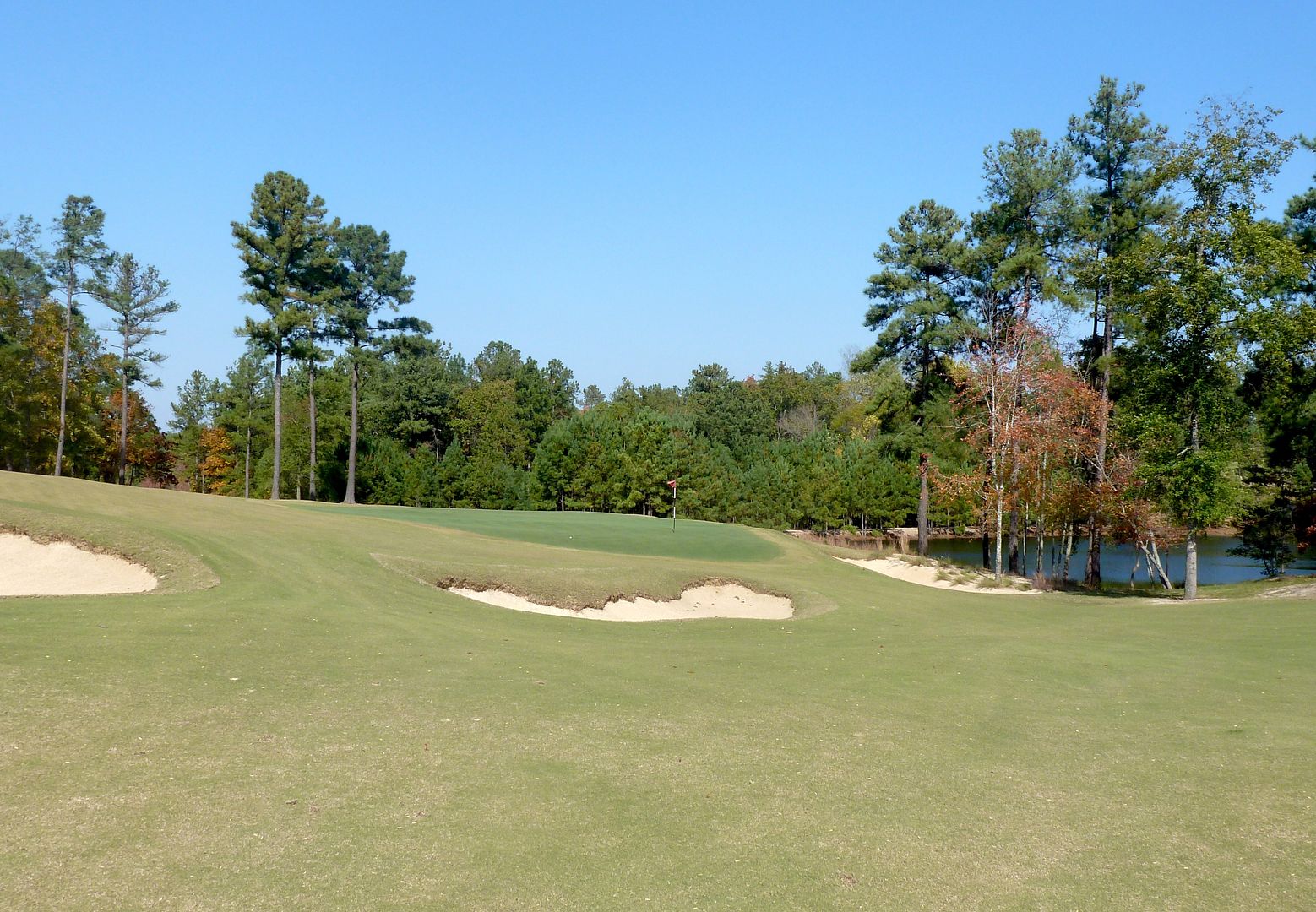
There is not a lot of internal contour on the 4th green, but more importantly there is some counterslope on the right side of the green that will protect balls using the slope to the left from running off the green.
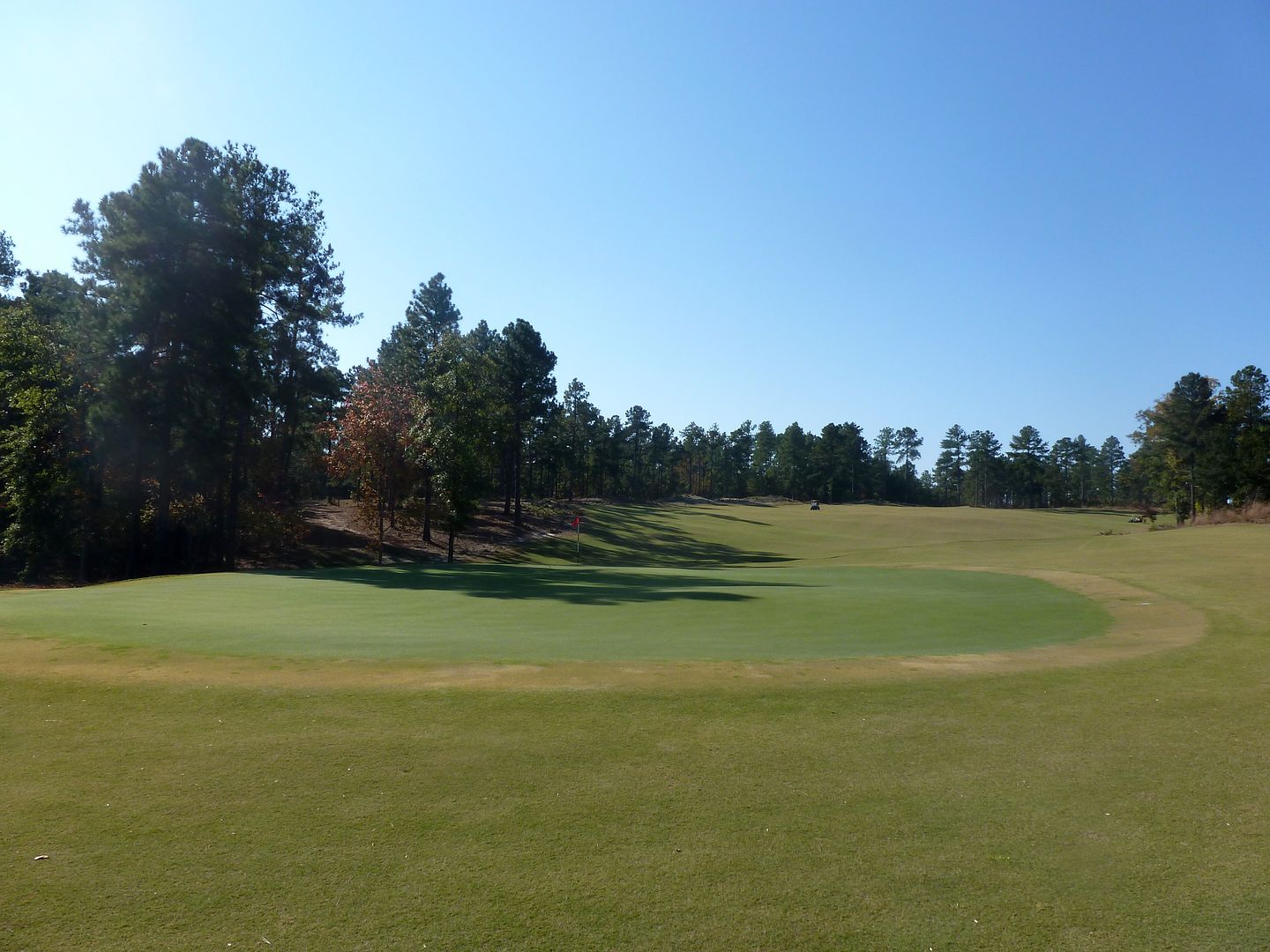
Hole 5: Par 4, 435 Yards
The tee shot is more visually intimidating than difficult. It is only about 200 yards to carry the water on the longest line. Still, I'm told, the middle tees are often moved to the other side of the hazard making this play as a sub 300-yard par 4. Ideally tee shots will be played up the left side of the fairway, though there is no large advantage.
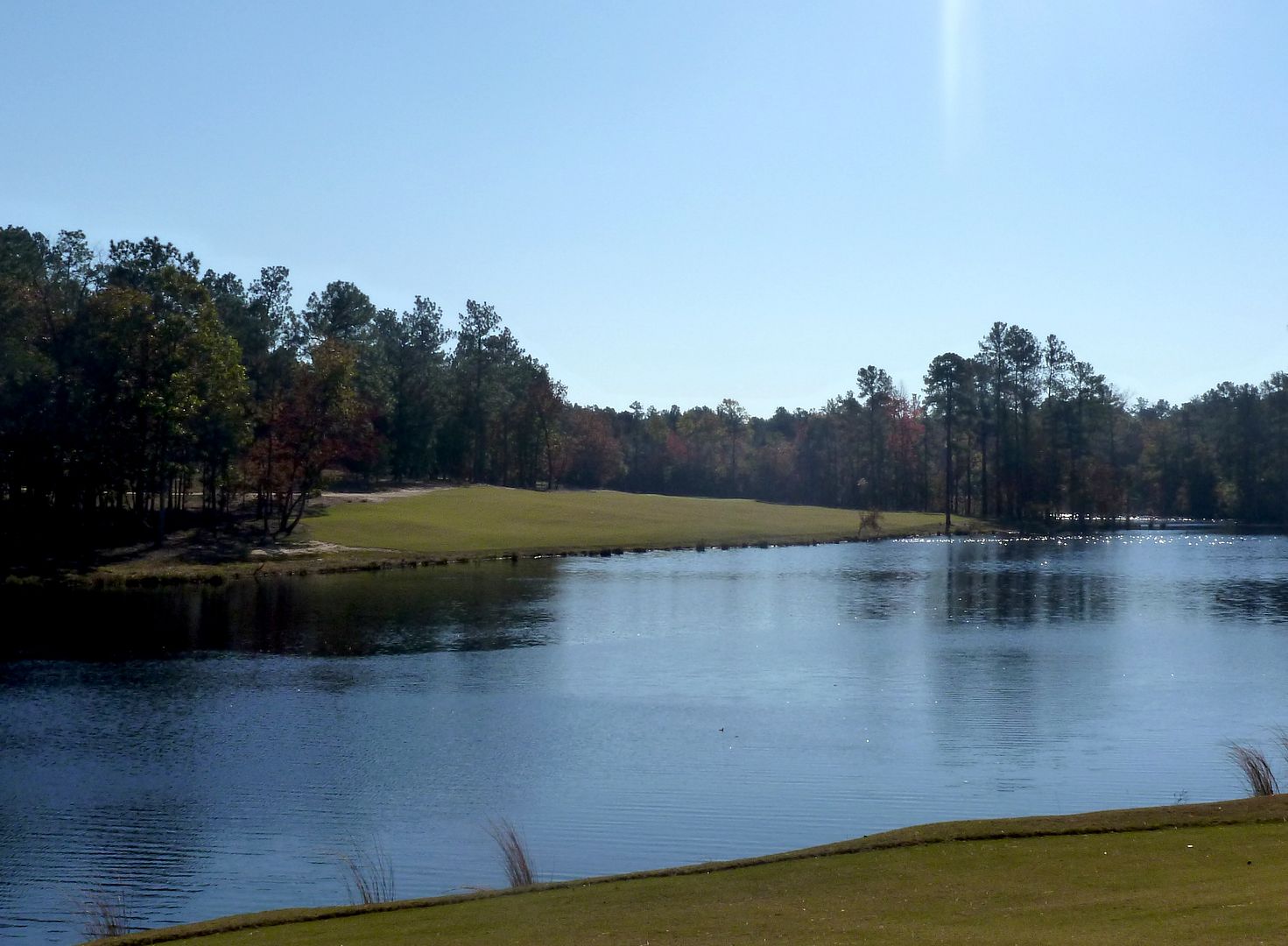
The approach is fairly straightforward. The green is open in front and guarded only by a couple of bunkers to the right. The green slopes generally from front-left to back-right and calls for a shot to be landed short of the green. As I recall there is a significant ridge bisecting the green into front and back sections and a large hump on the right side of the green complicating putts that are played from the wrong side of the ridge.
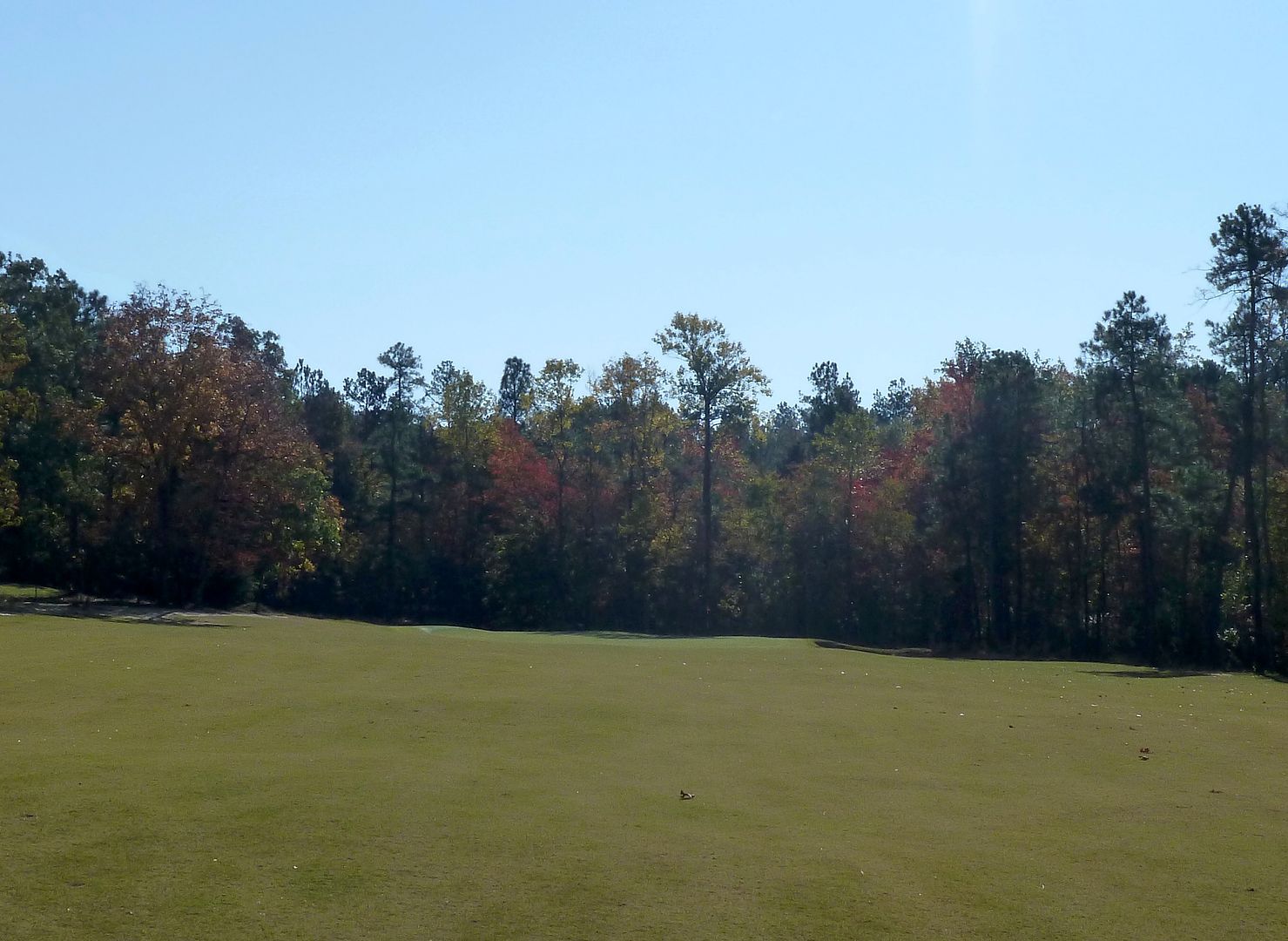
Hole 6: Par 5, 532 Yards
Width! This fairway must be 100 yards wide. Though it isn't obvious, the ideal line is just inside the right edge of the bunker (about a 230 yard carry). Players not willing the challenge the bunker have the option of playing up the left. The hole feels like it should play very long, once the player crests the hill it is downhill all the way and will be within reach in two for many players.
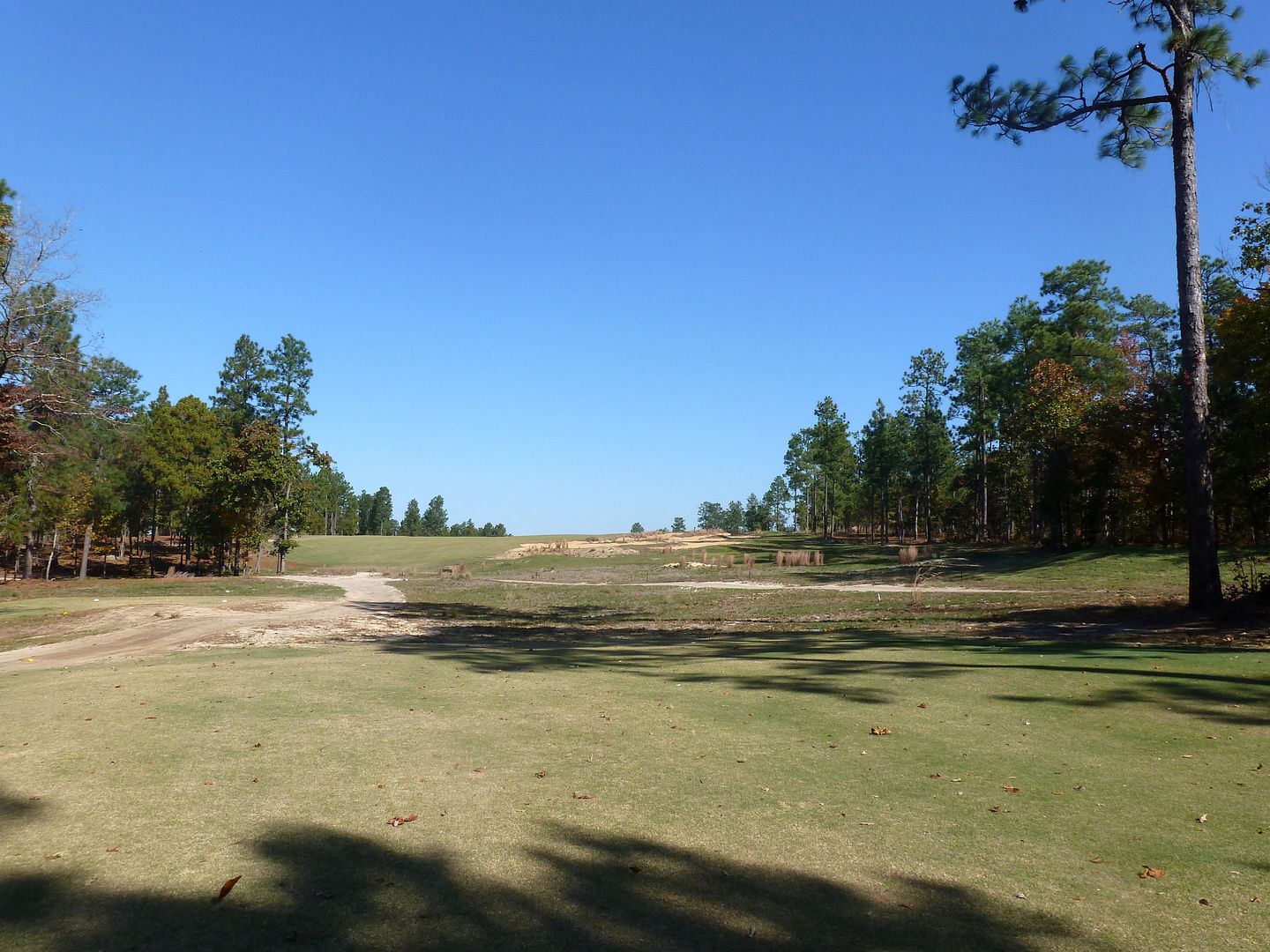
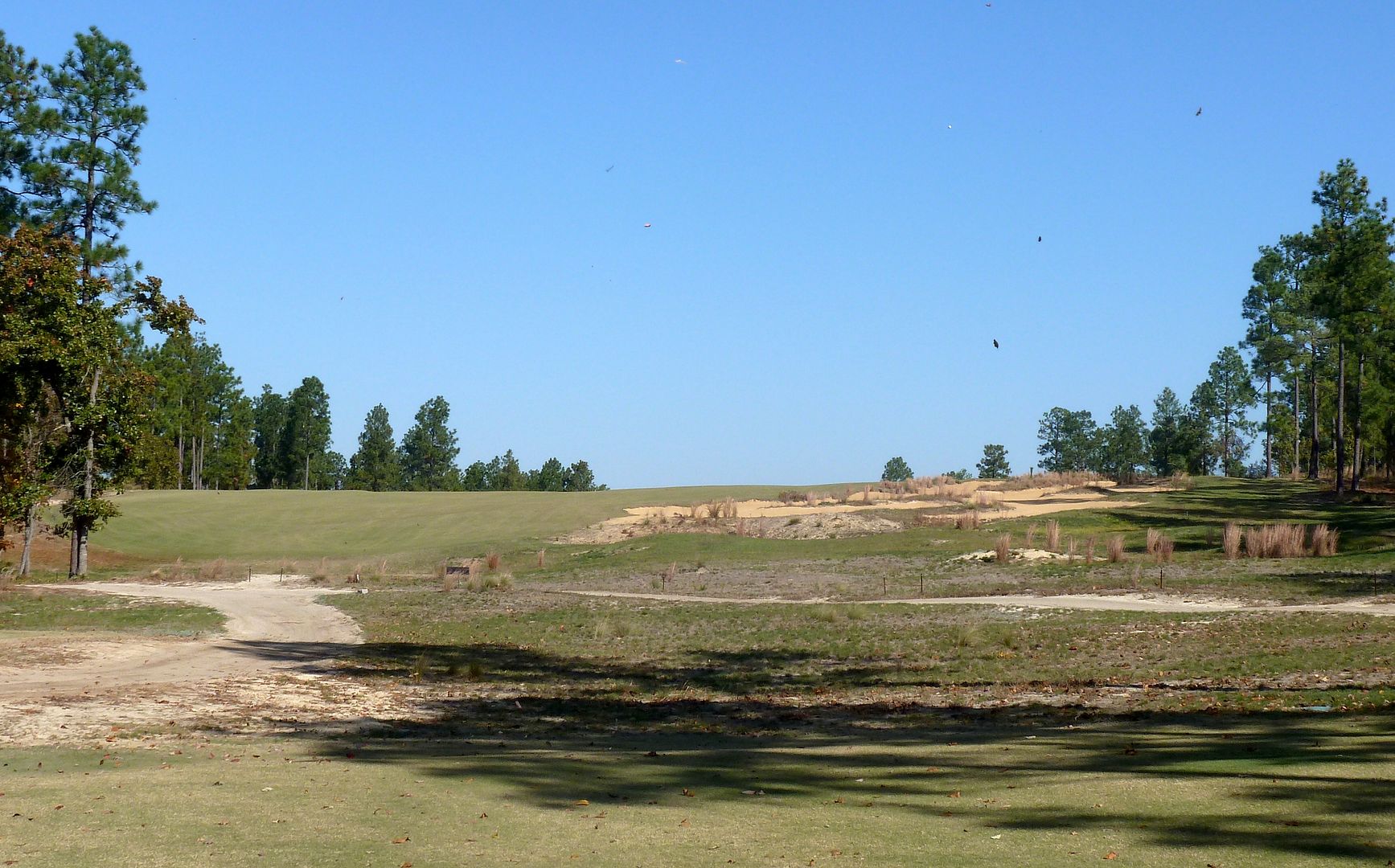
Tee shots played up the right side of the fairway will not have to deal with a pesky (cleverly-placed) bunker 50 yards short of the green.
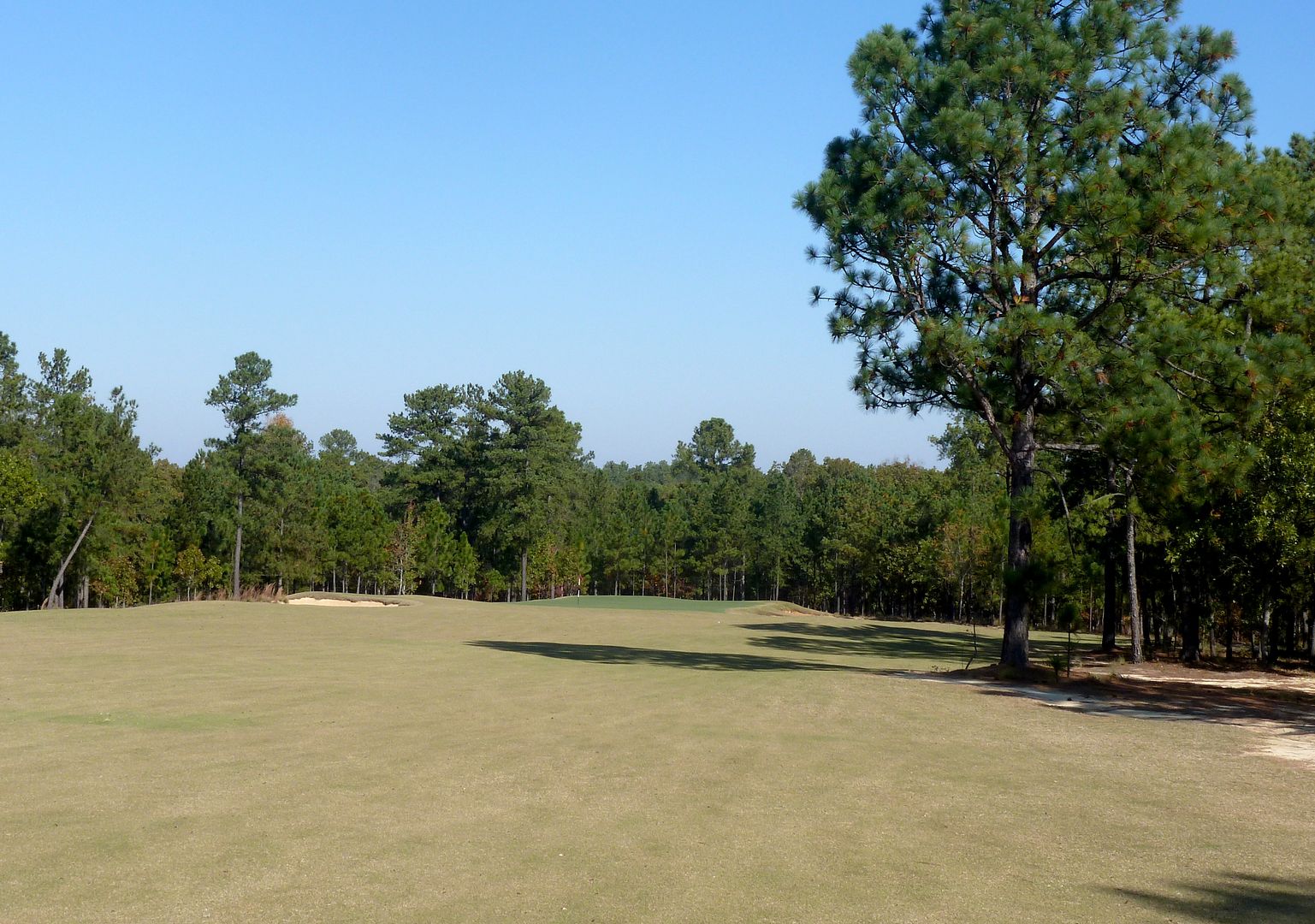
Now this is a green that begs for the ground game. It is wide open in front and slopes significantly from front-to-back. Playing from 250 yards out, my caddie said I should play a 210 yard shot and let the ball trundle down to the green -- once the ball gets on the green it's amazing how fast it is. The front pin pictured looks easy, but in fact may be the most difficult.
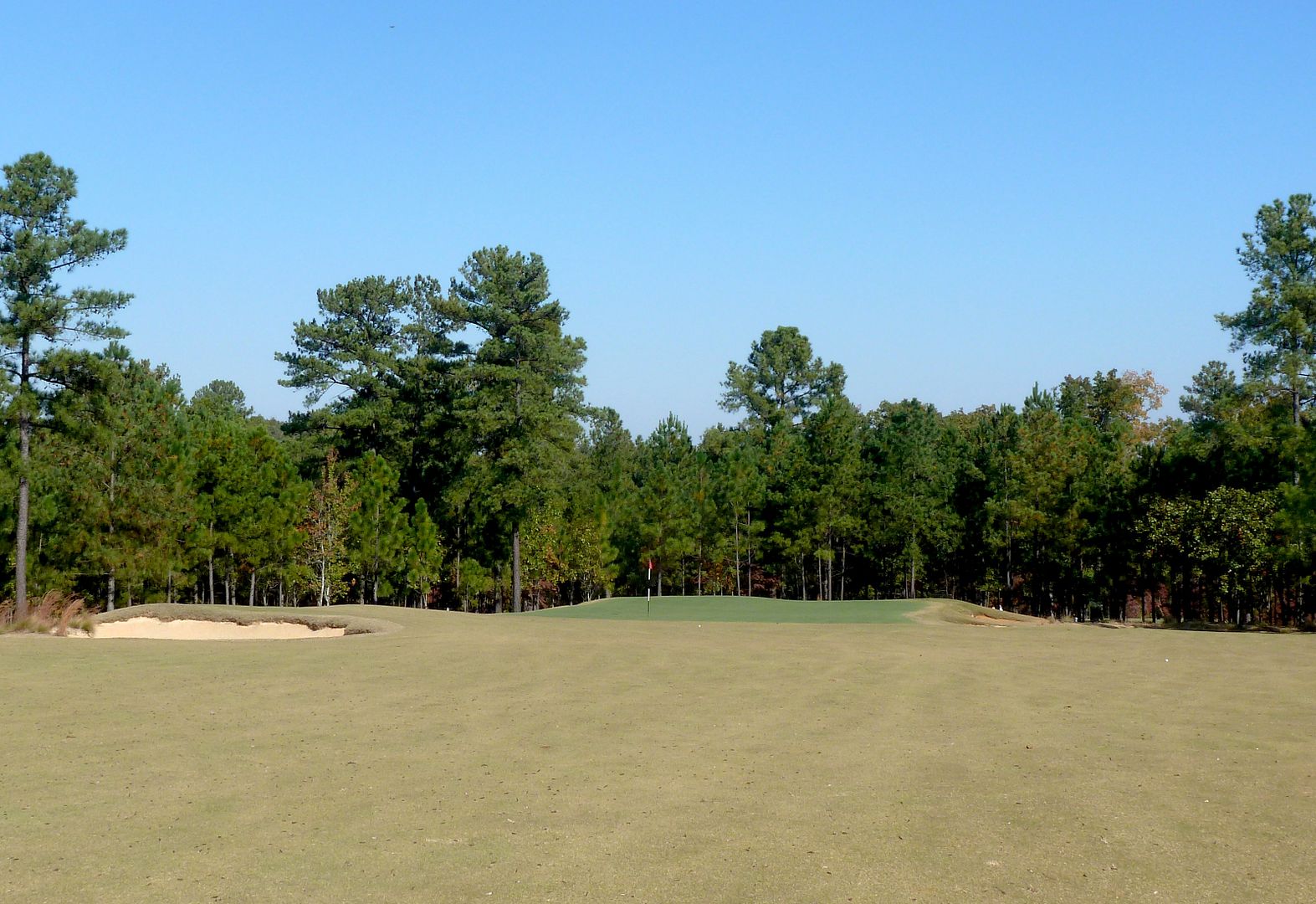
Interesting and nasty scar bunkers left and long of the green.
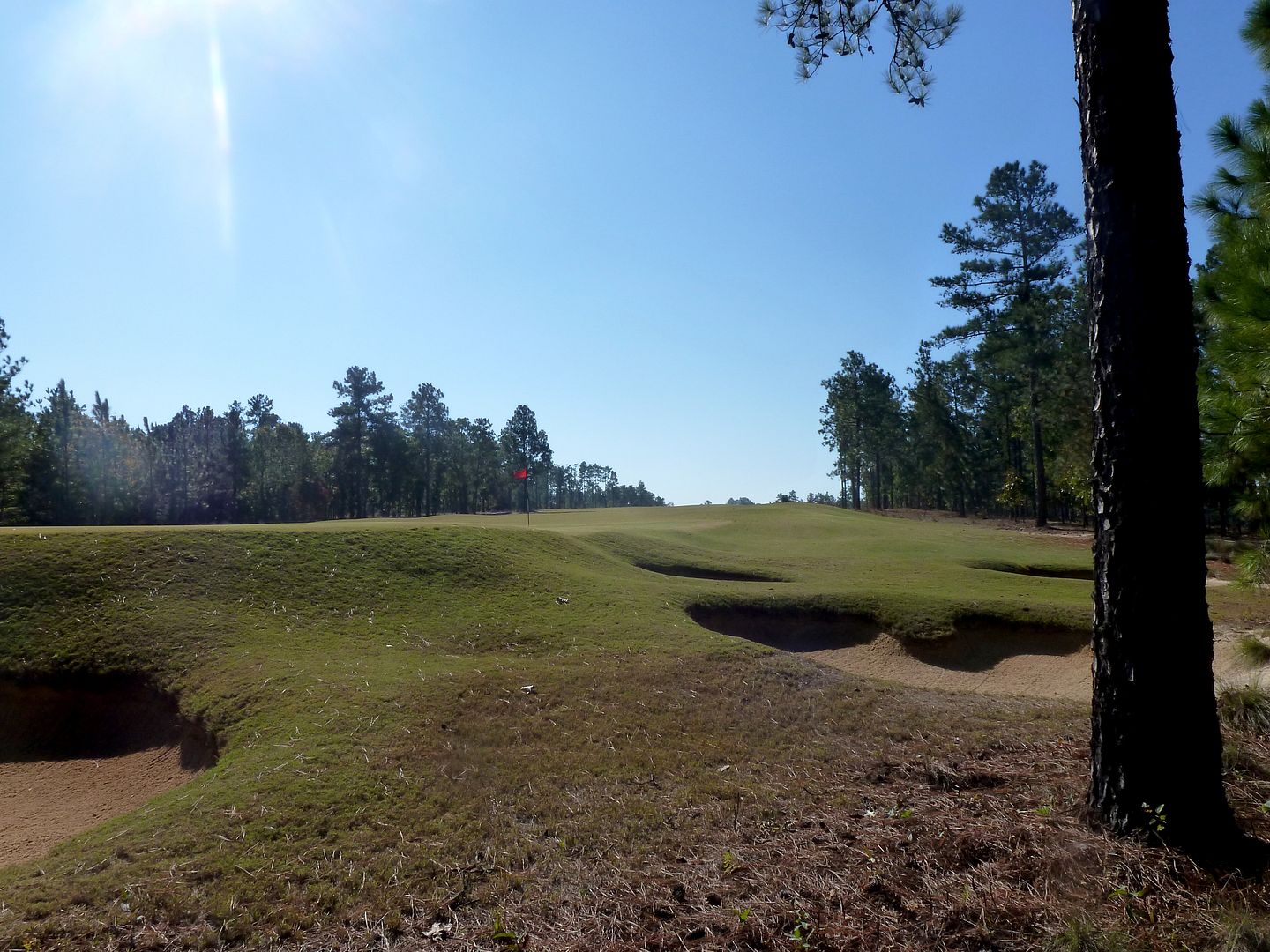
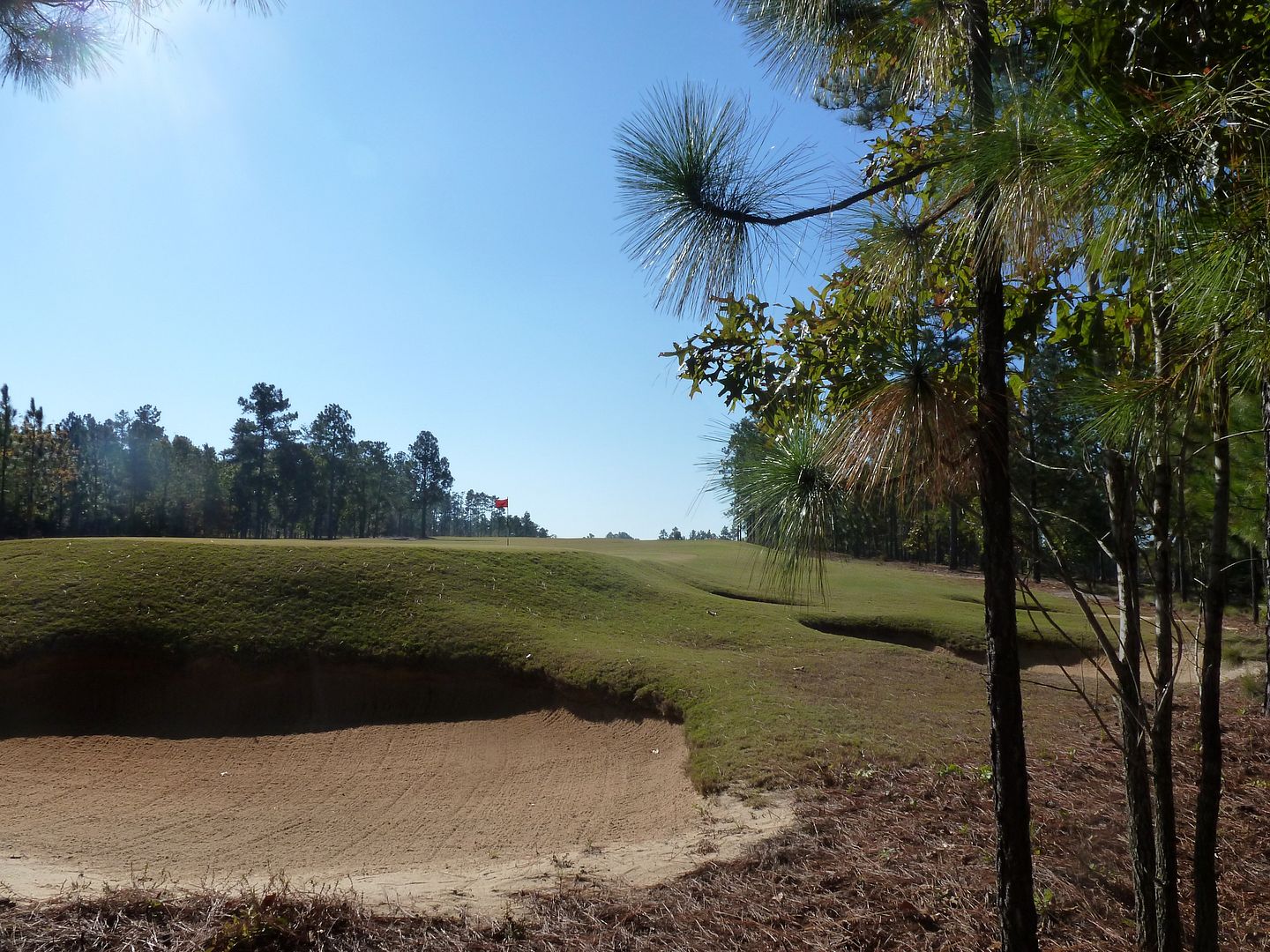
Hole 7: Par 3, 243 Yards
After making the confusing walk from the 6th green to the 7th tee, you are faced with the most difficult shot of the day (thus far). The hole plays in the same direction as the 6th, meaning it should be downwind, but at over 240 yards (still over 200 yards from the middle tee), this hole is far from a gimme.
This hole really looks like a reverse-redan. Significant bunkering guarding short and right of the green, combined with the rightward tilt of the land to the left of the green, encourage the use of a fade off the left-side slopes.
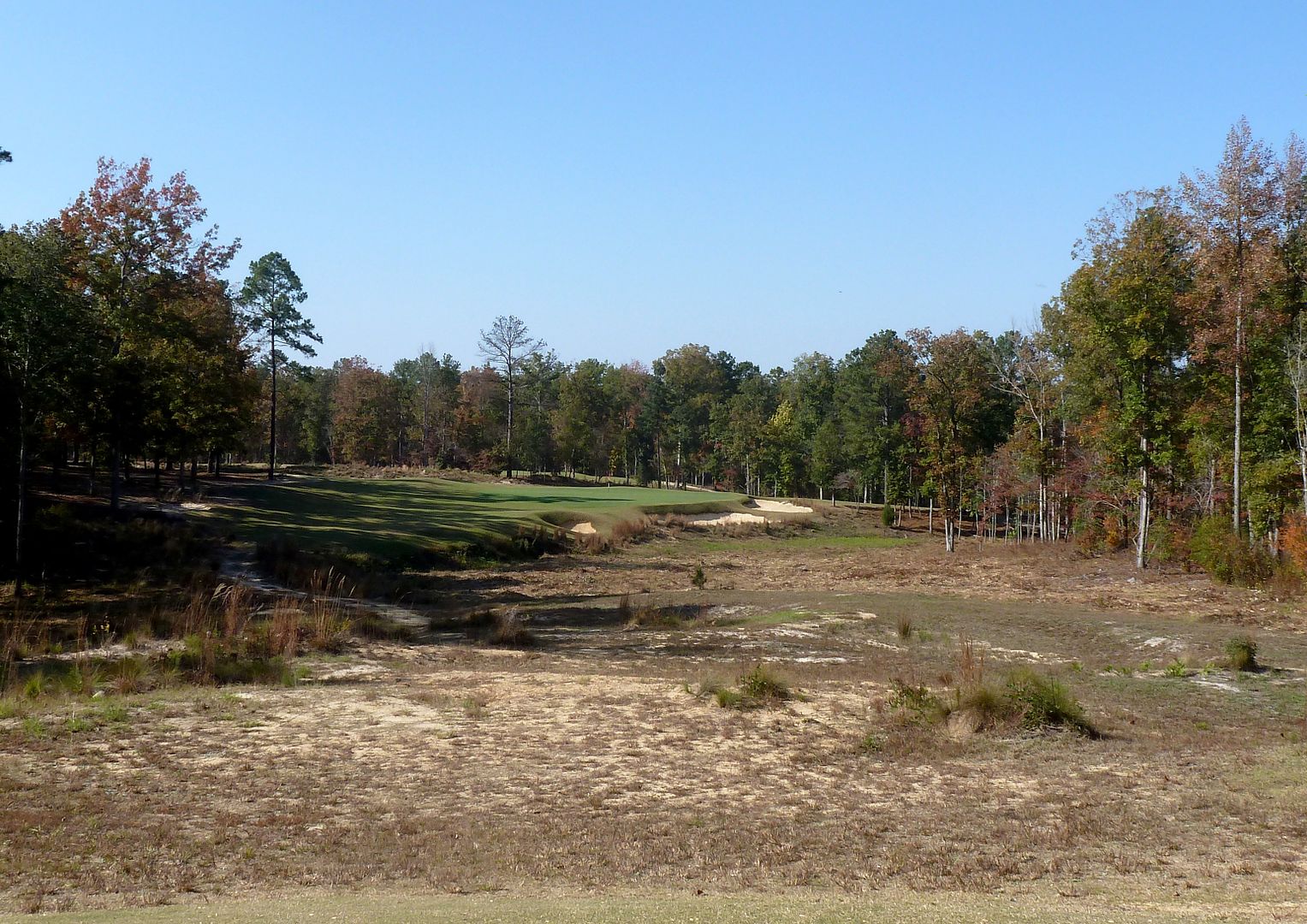
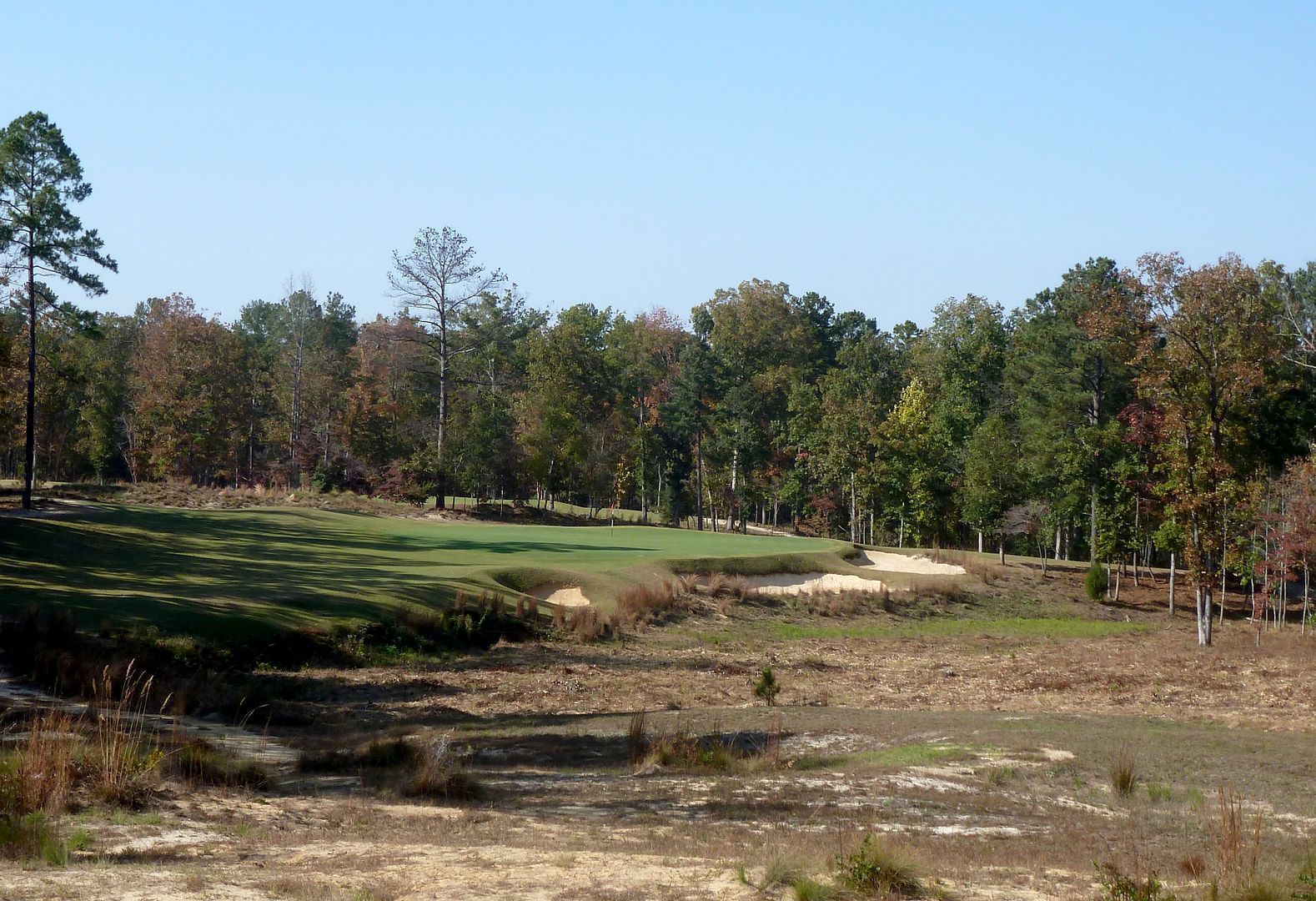
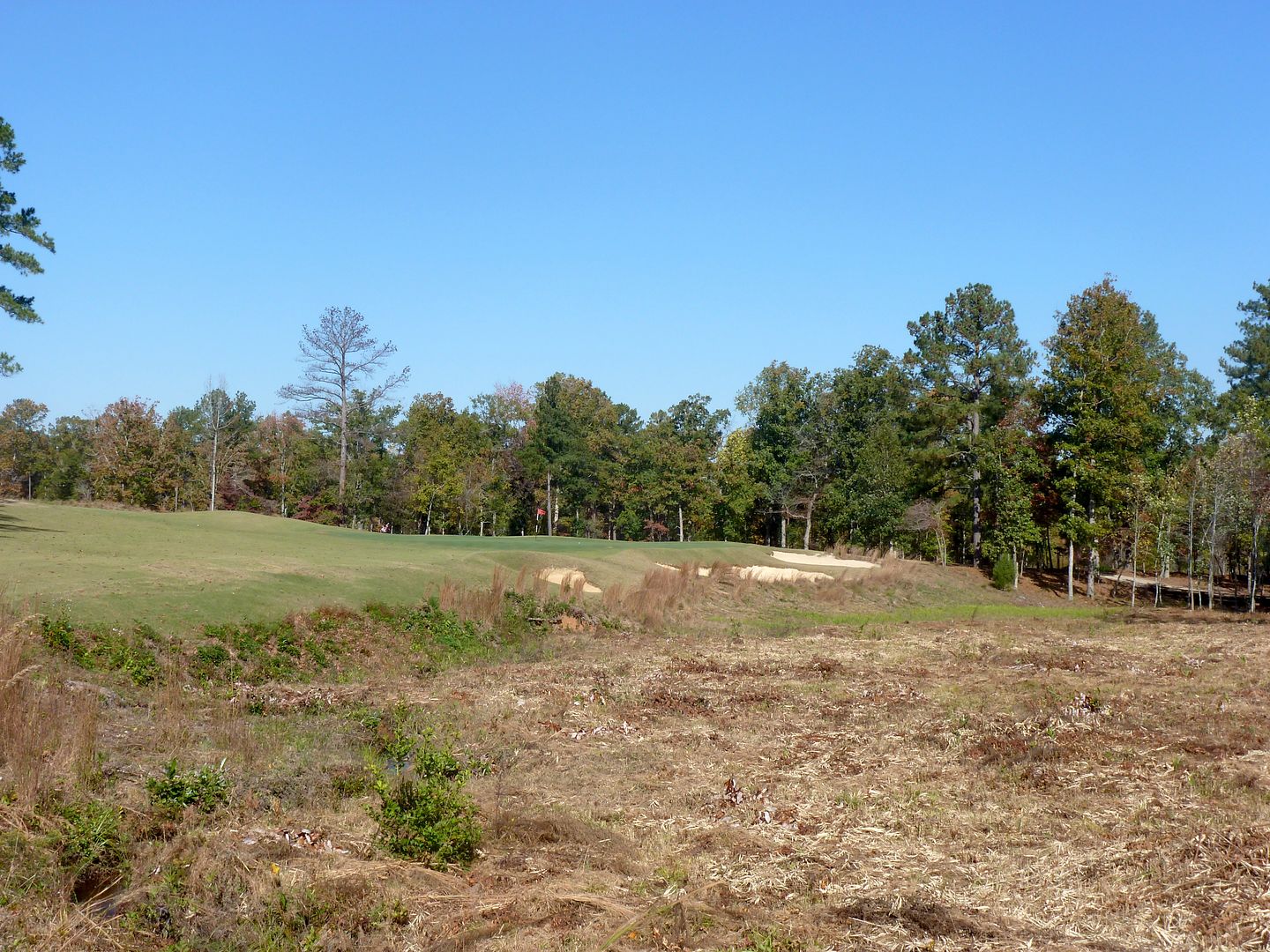
The bunkers short and right of the green are very deep and are not a very good spot to miss. Still, it may be better to miss here than left as you are blasting into the slope of the green. Also notice the bit of counterslope on the leftmost part of the green.
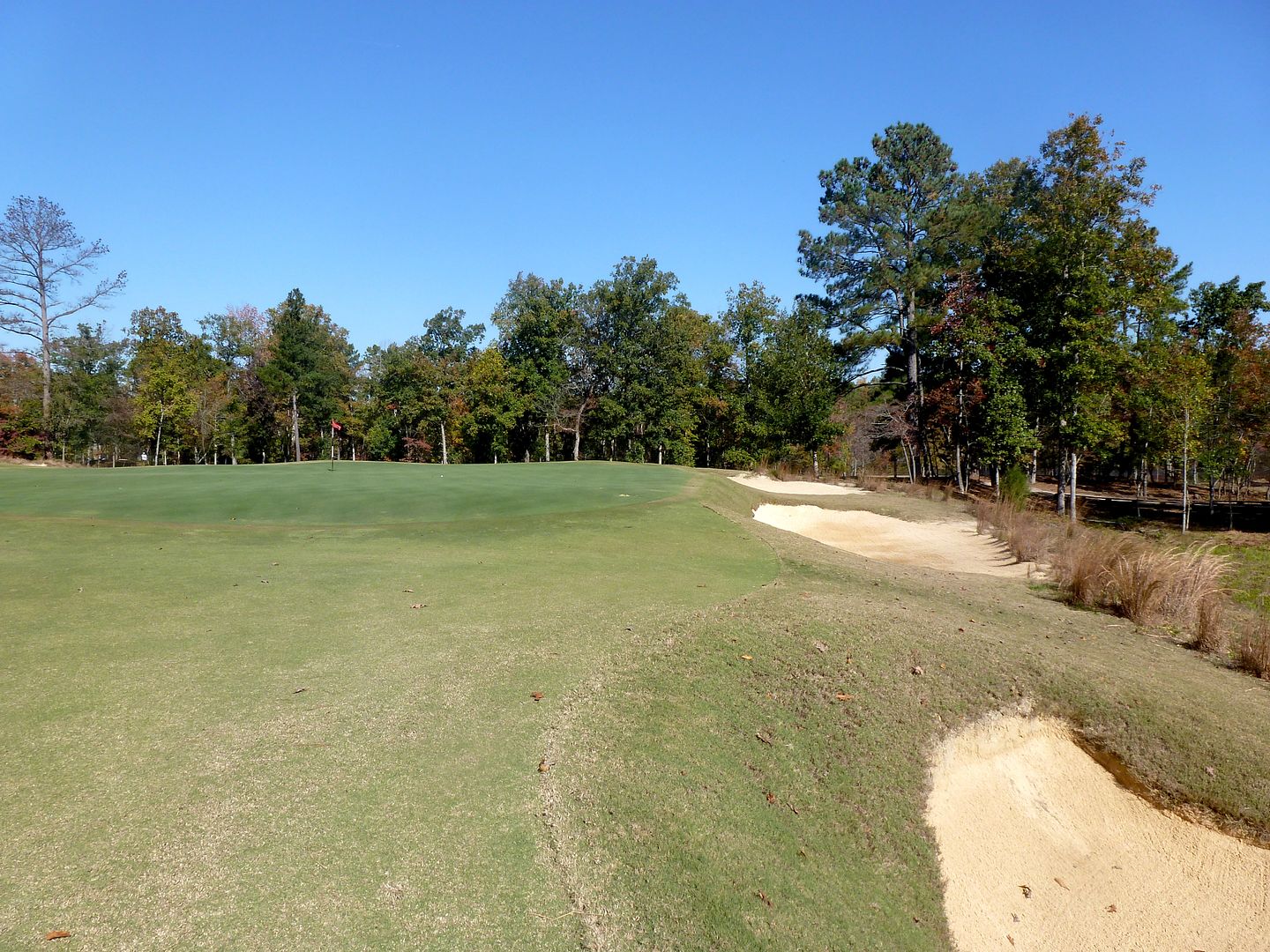
A view from the slope on the left. OK, so here's my issue, the slope flattens out (and even counterslopes) right by the green. This means that shots played to the left will trundle to the green's edge, but will not go much farther. I don't know if this was by intent or was a mistake, but I would prefer to see shots that use the slope on the left have the opportunity to get all the way to the centre of the green.
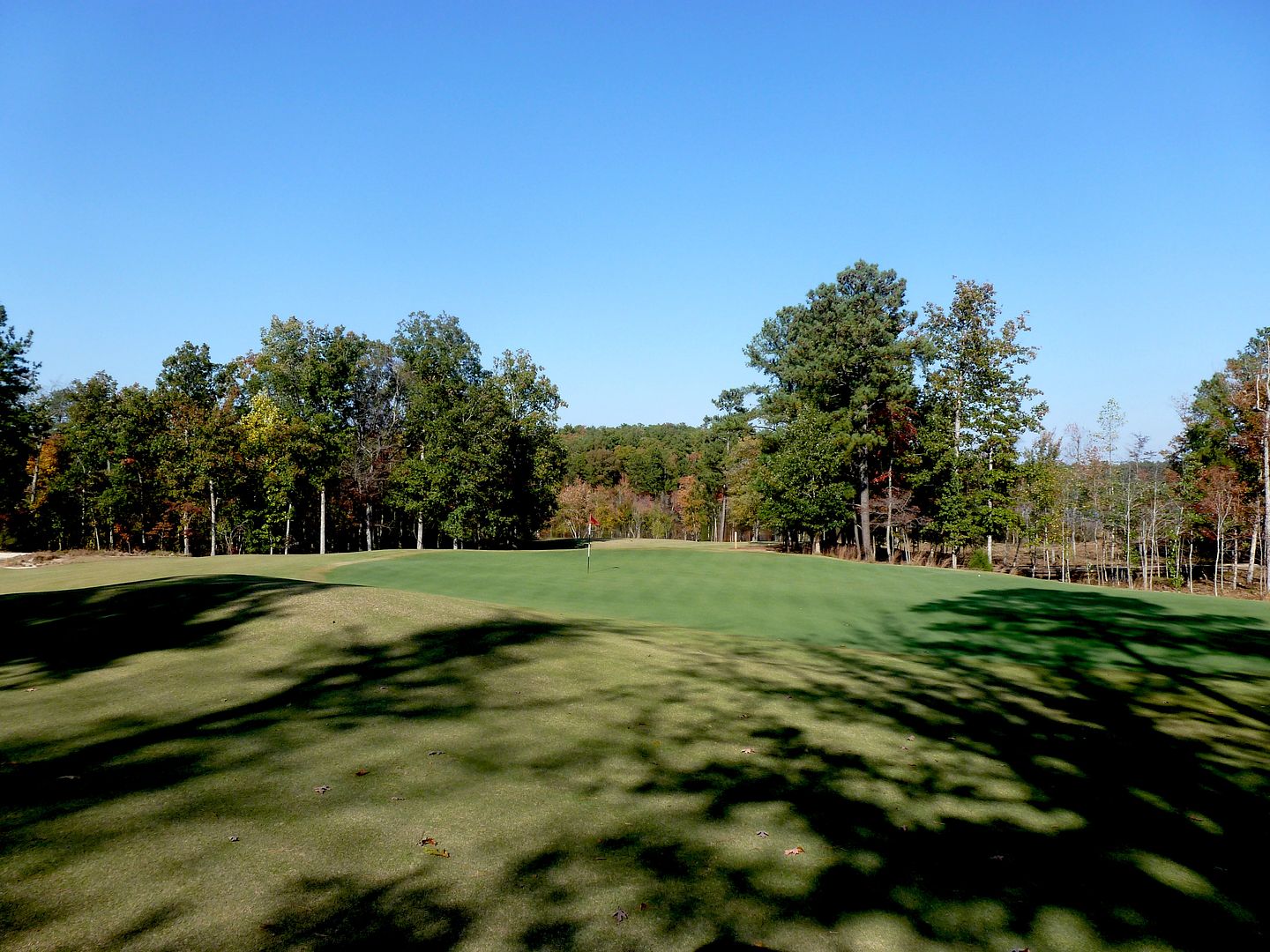
Internal contouring on the 7th green is fairly tame.
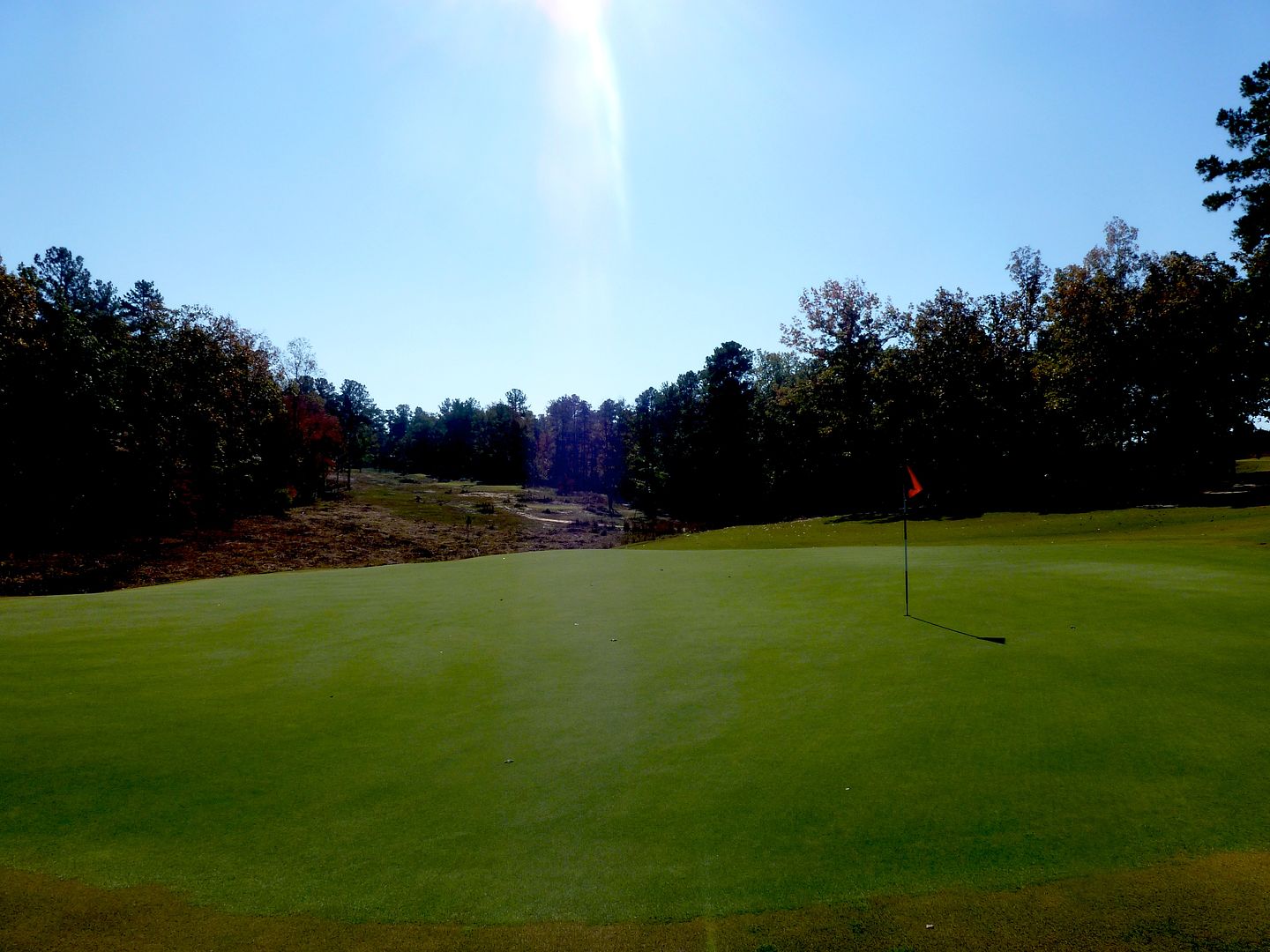
Hole 8: Par 4, 477 Yards
Another hole that moves left, but this one really moves left. A tee shot hit with a draw that moves left with the contour of the ground will leave an approach that can only find the green if hit with a draw. I pity anyone that plays a cut that plays this hole.
An aerial shot only gives some idea of how much this hole moves left.
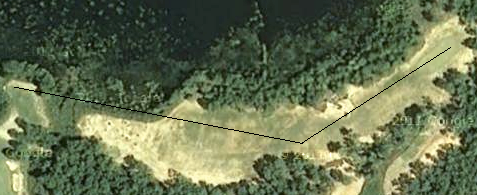
From the tee it is obvious how significantly the land tilts to the left, assisting the player to get into position to reach the green on the second shot. There is a 'speed-slot' that will allow the player who hits a draw to have less than 200 yards into the green.
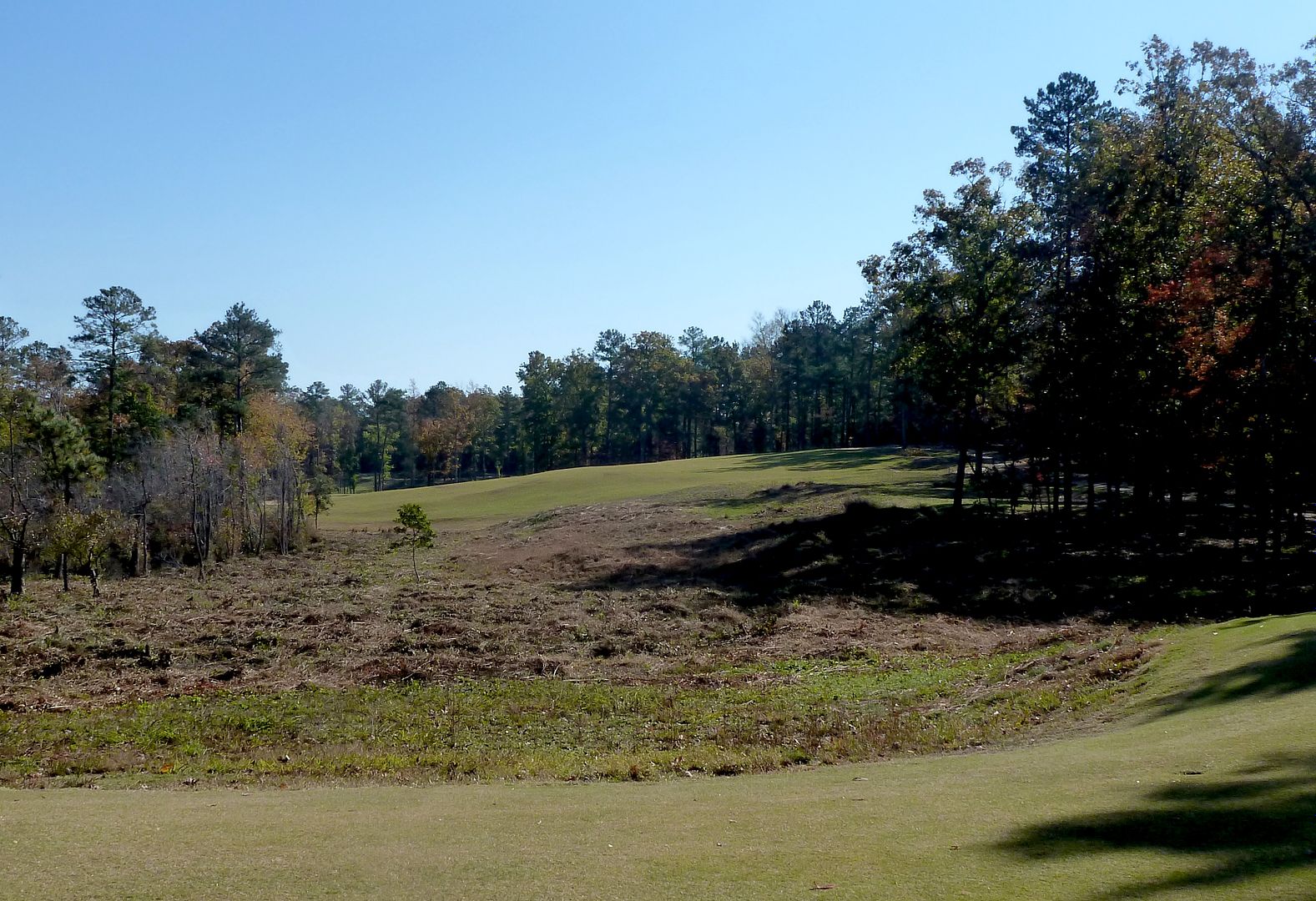
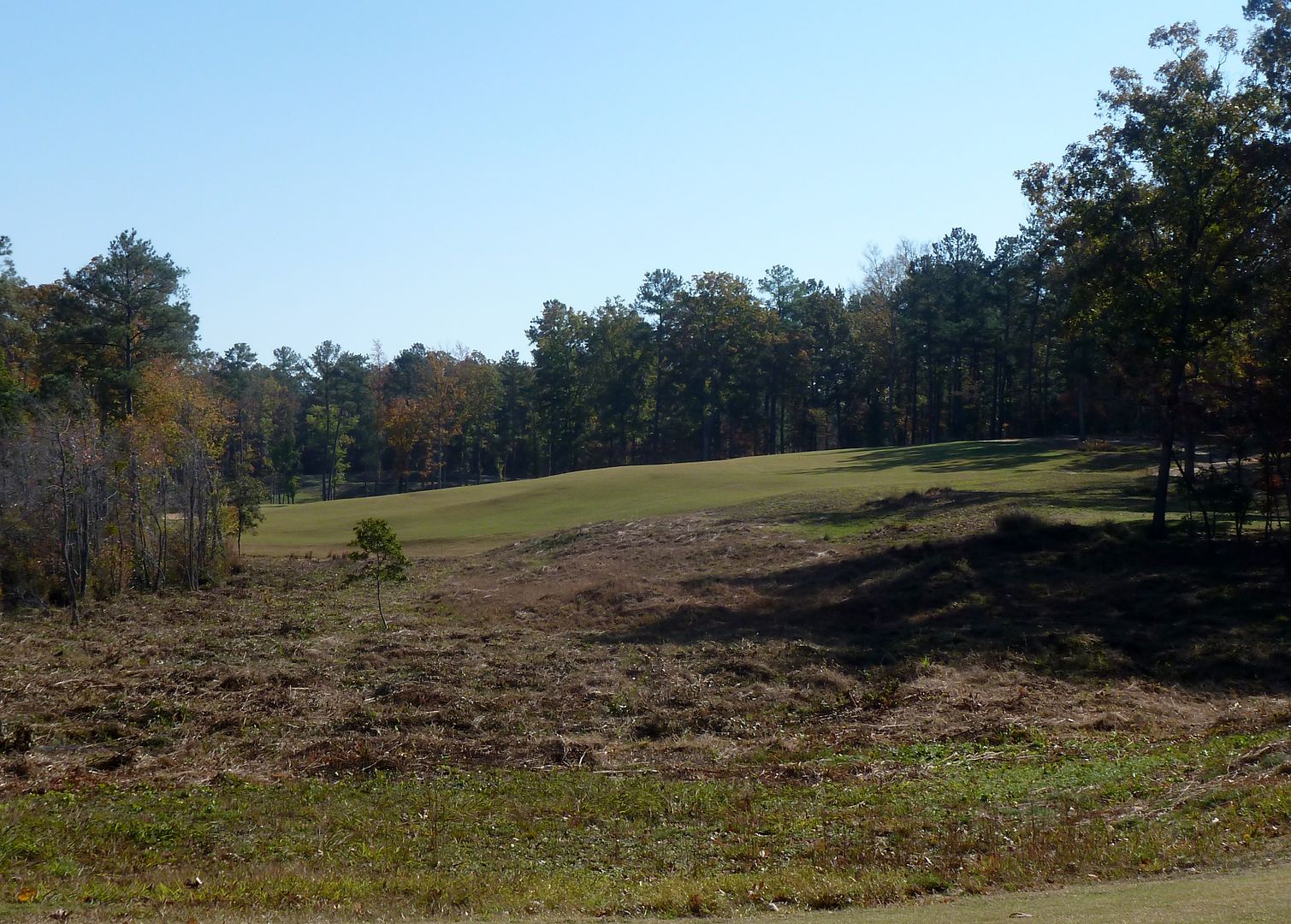
Players missing the speed-slot will be faced with this approach from over 200 yards.
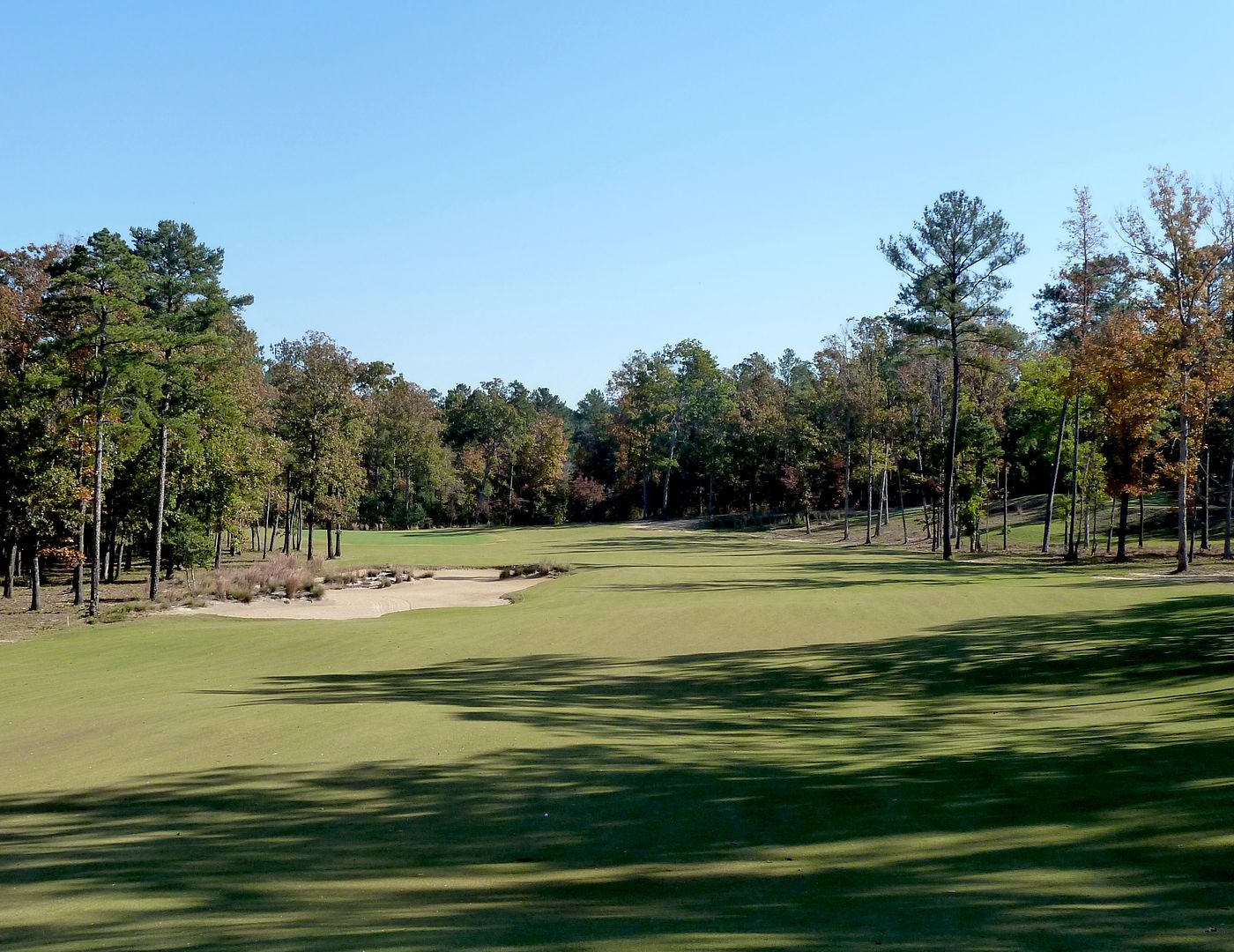
From the bottom of the hill, about 180 yards from the green. This is from the centre of the fairway and still there is no clear view of the green -- perhaps an unnecessary penalty for a perfect tee shot. Fortunately, the ground short and right of the green slopes to the left assisting the player who has difficulty hitting a draw to find the green.
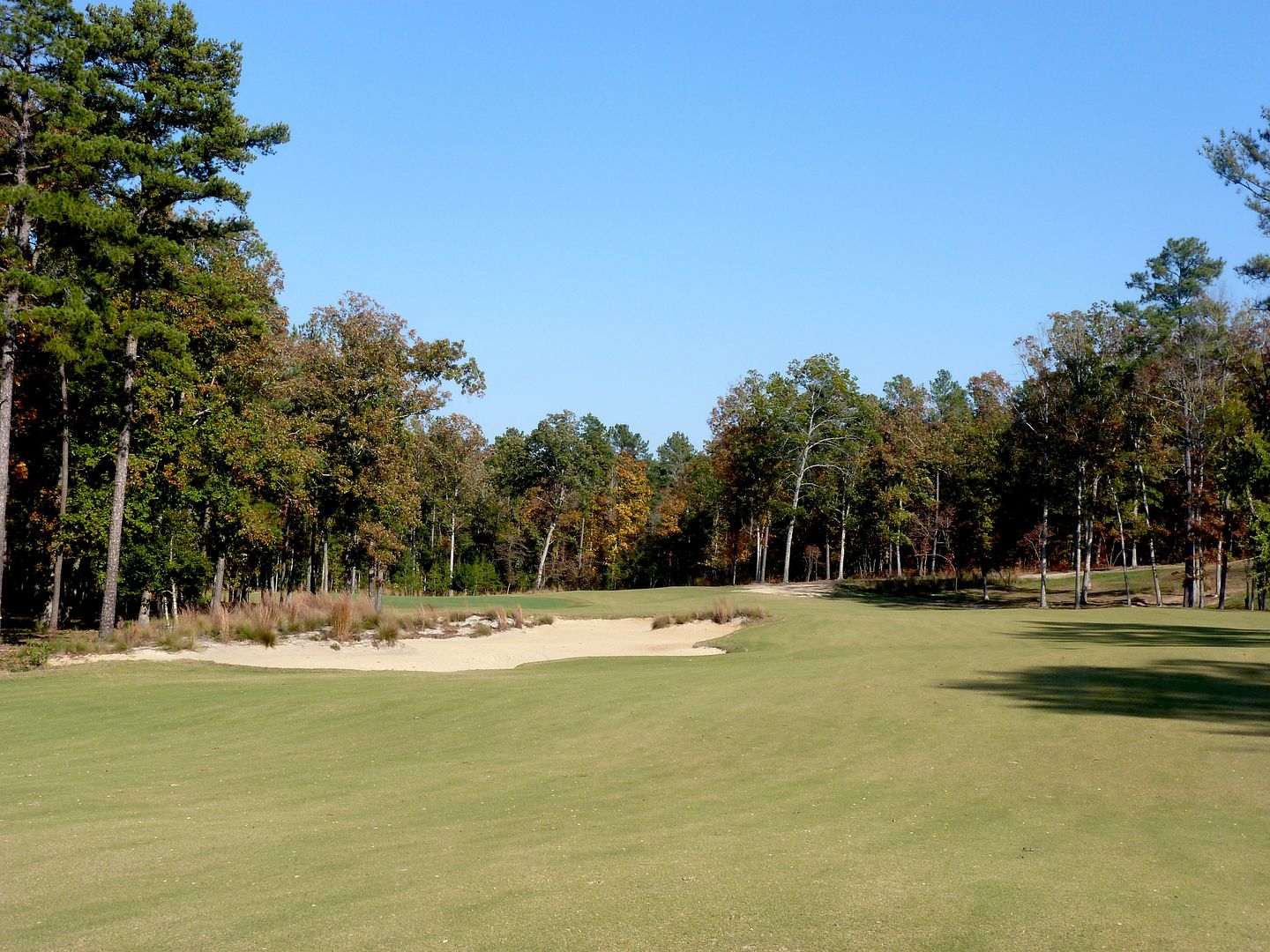
From right of the green, a position I suspect is very often found by golfers. From here it is significantly downhill to the green and simply finding the putting surface is no easy task. Note the very narrow green -- not easy to find from 200+ yards out.

The 8th green as seen from the 9th tee.
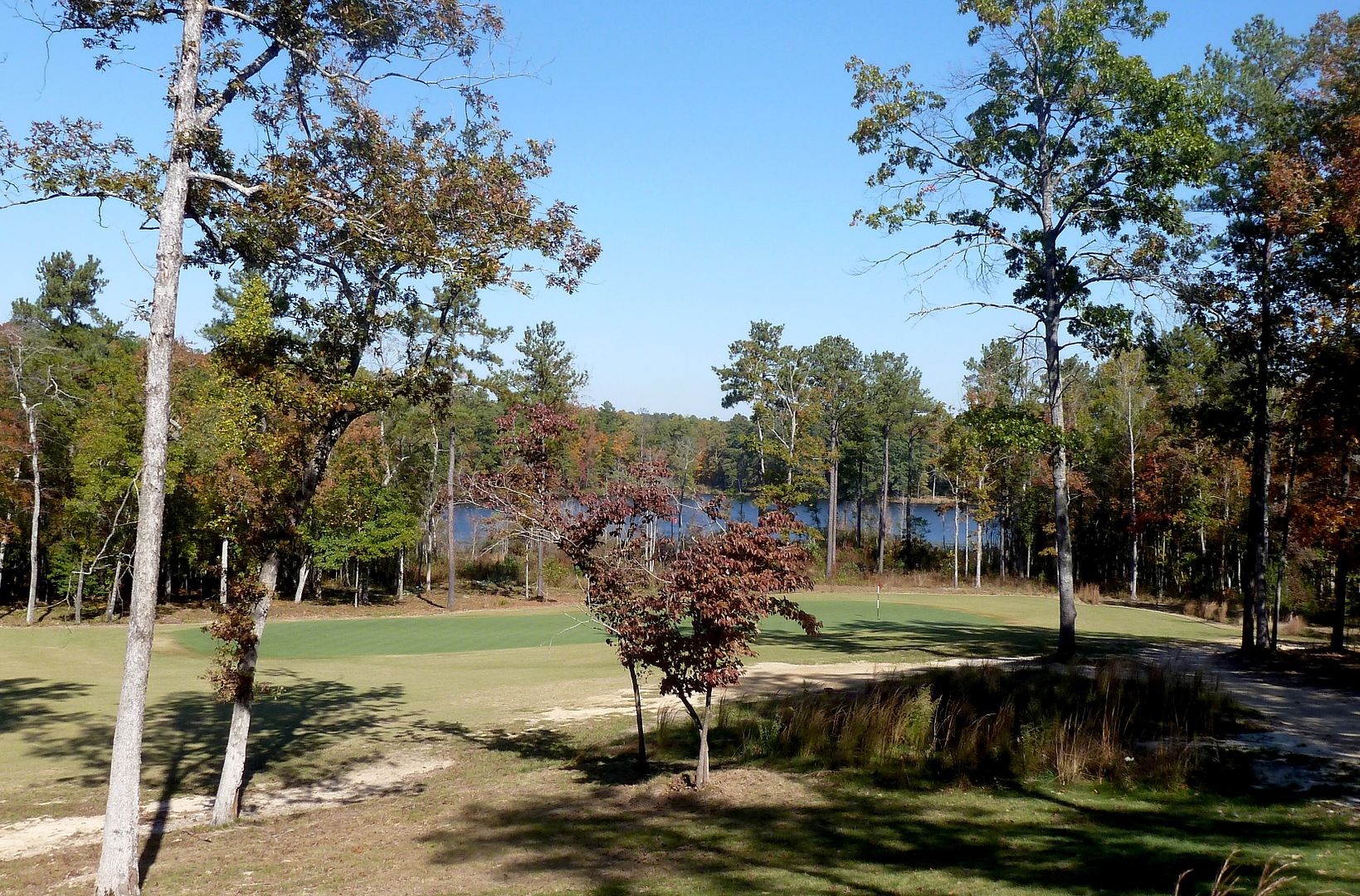
Hole 9: Par 3, 173 Yards
This is a very tough hole. Playing uphill and into the prevailing wind, it may say 173 on the scorecard, but it can easily play in the 200 yard range. For a shot of that length, the green is quite small, especially given that it is significantly tiered, protected by deep bunkers, has a false-front, and anything long will have trouble even finding the green on the next shot.
I wonder, is this hole a bit too long?
The back tee.
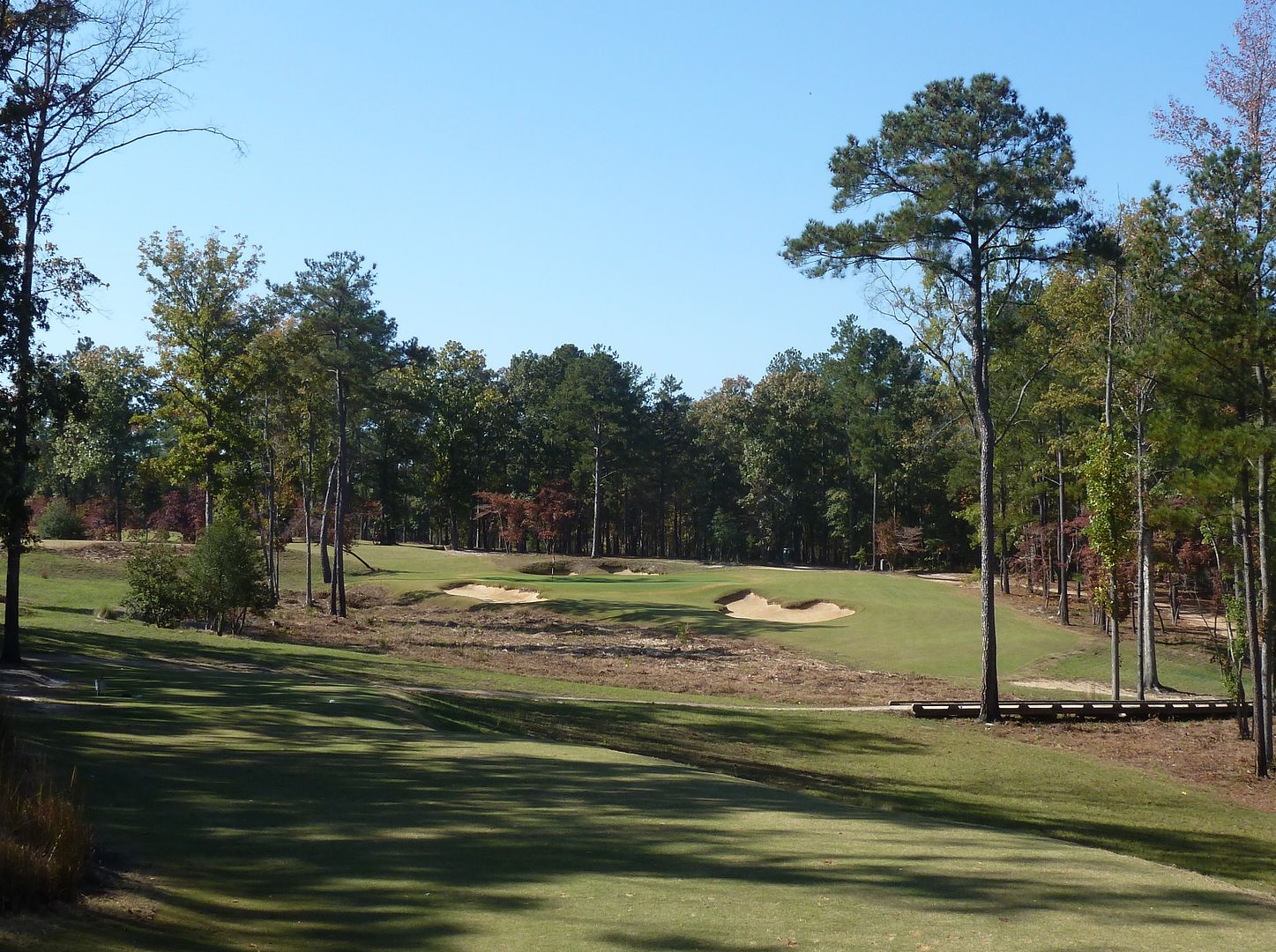
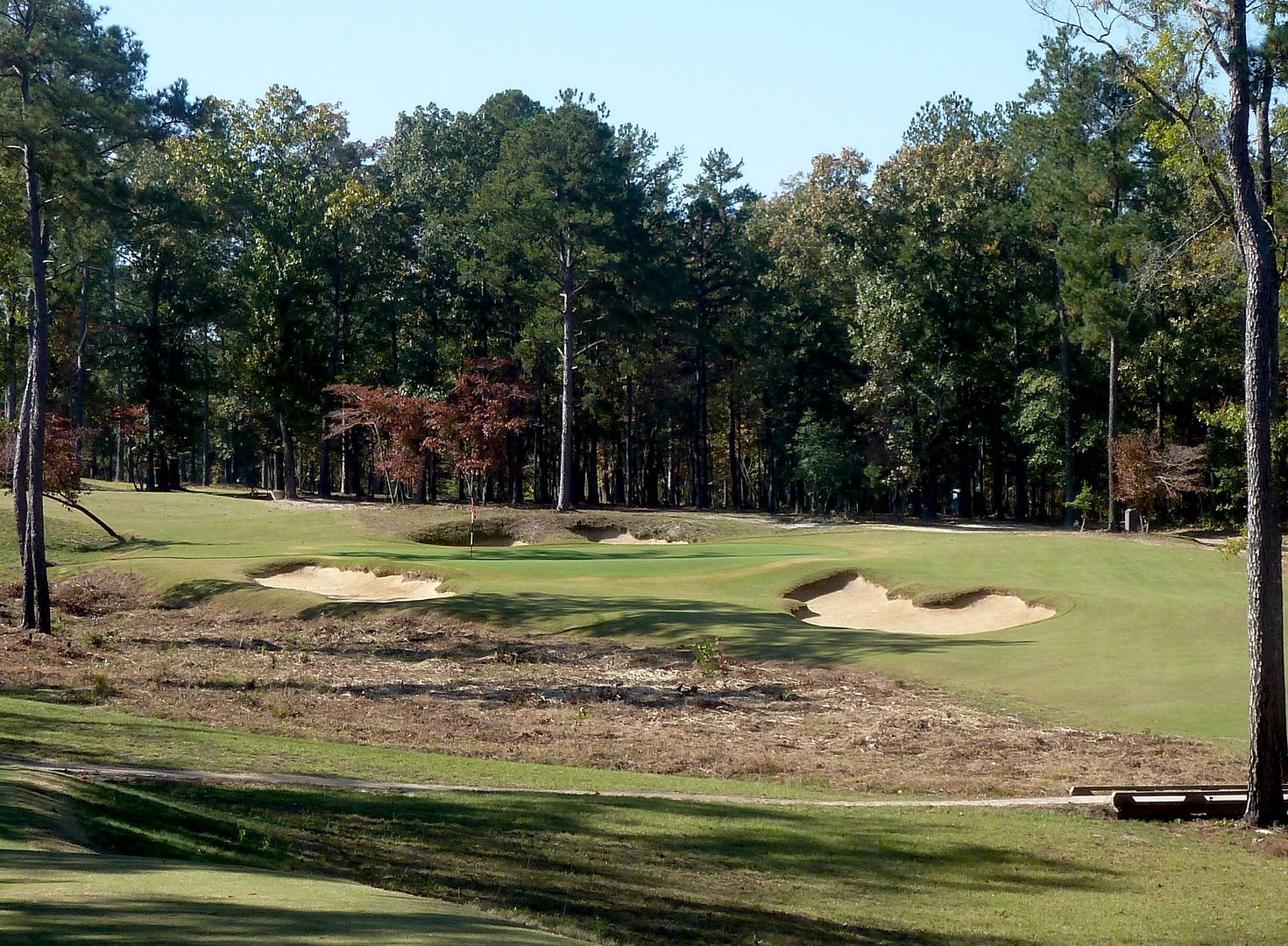
The whit tee -- certainly a more difficult angle of approach.
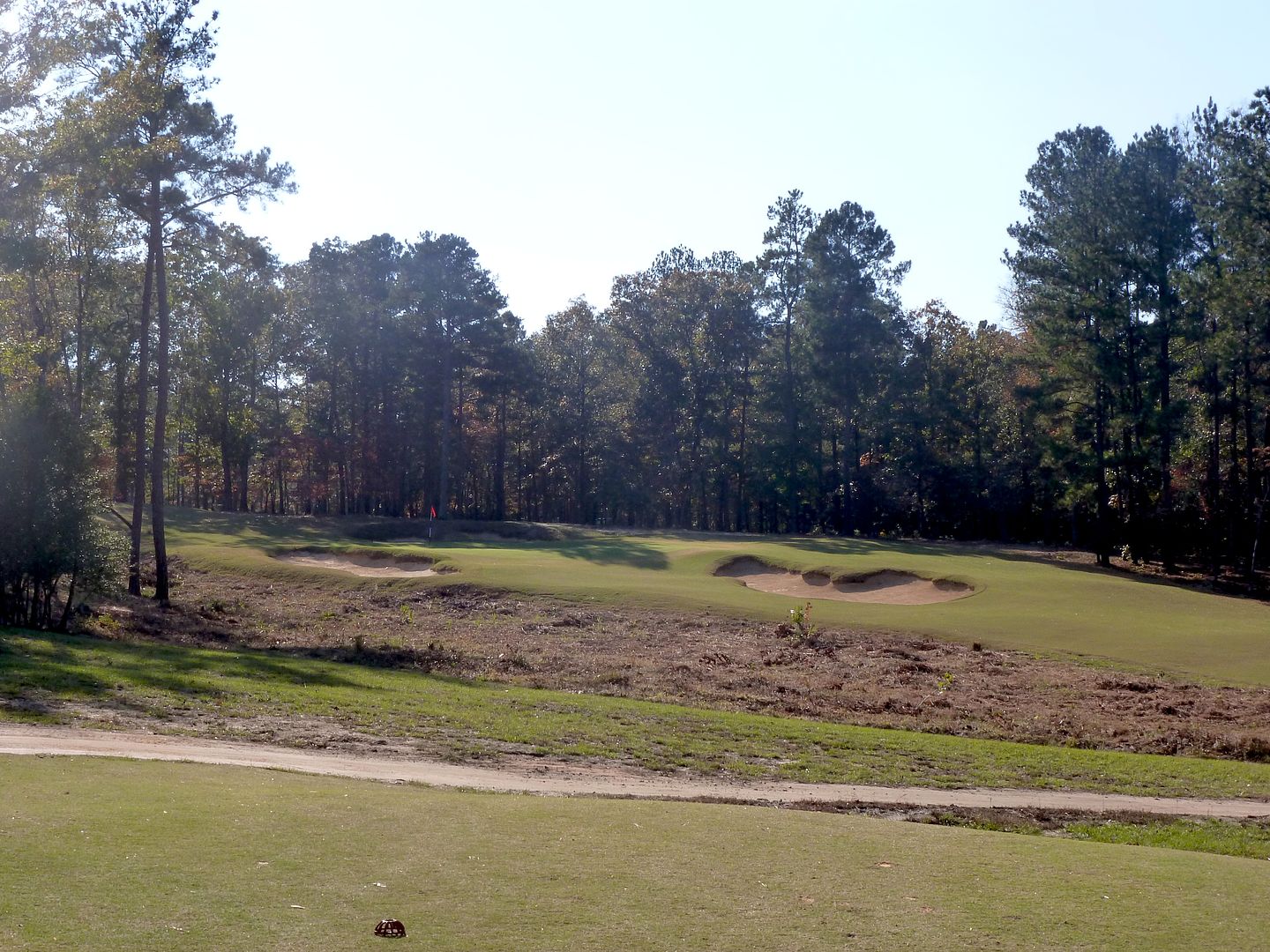
This bunker is probably the best spot to miss.
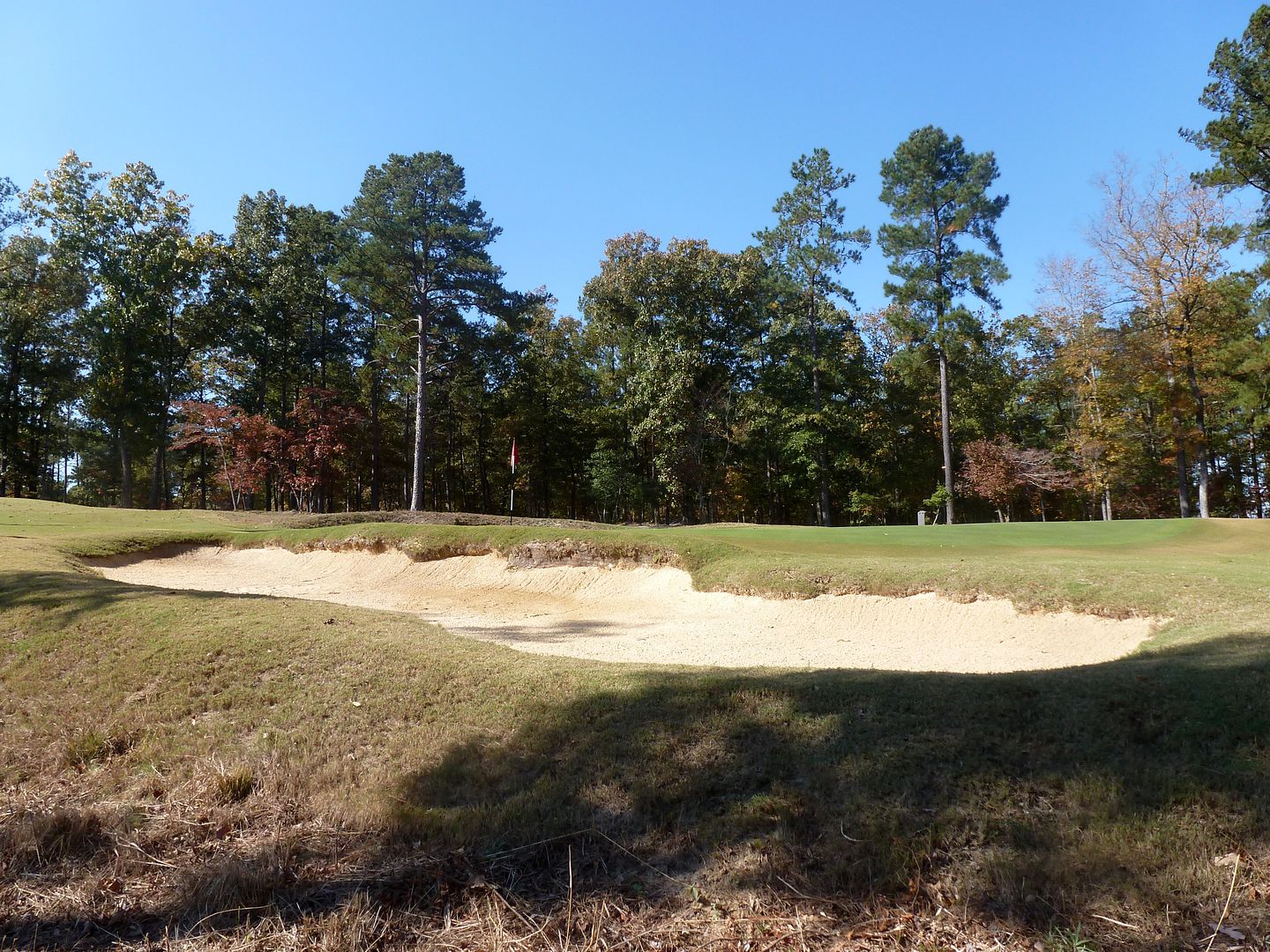
From left of the green. The ridge that is visible runs all the way across the green. Shots landing into that ridge could spin off the green and down the false-front (just ask my playing partner who thought he stiffed it).

The 9th green as seen from the 10th tee.
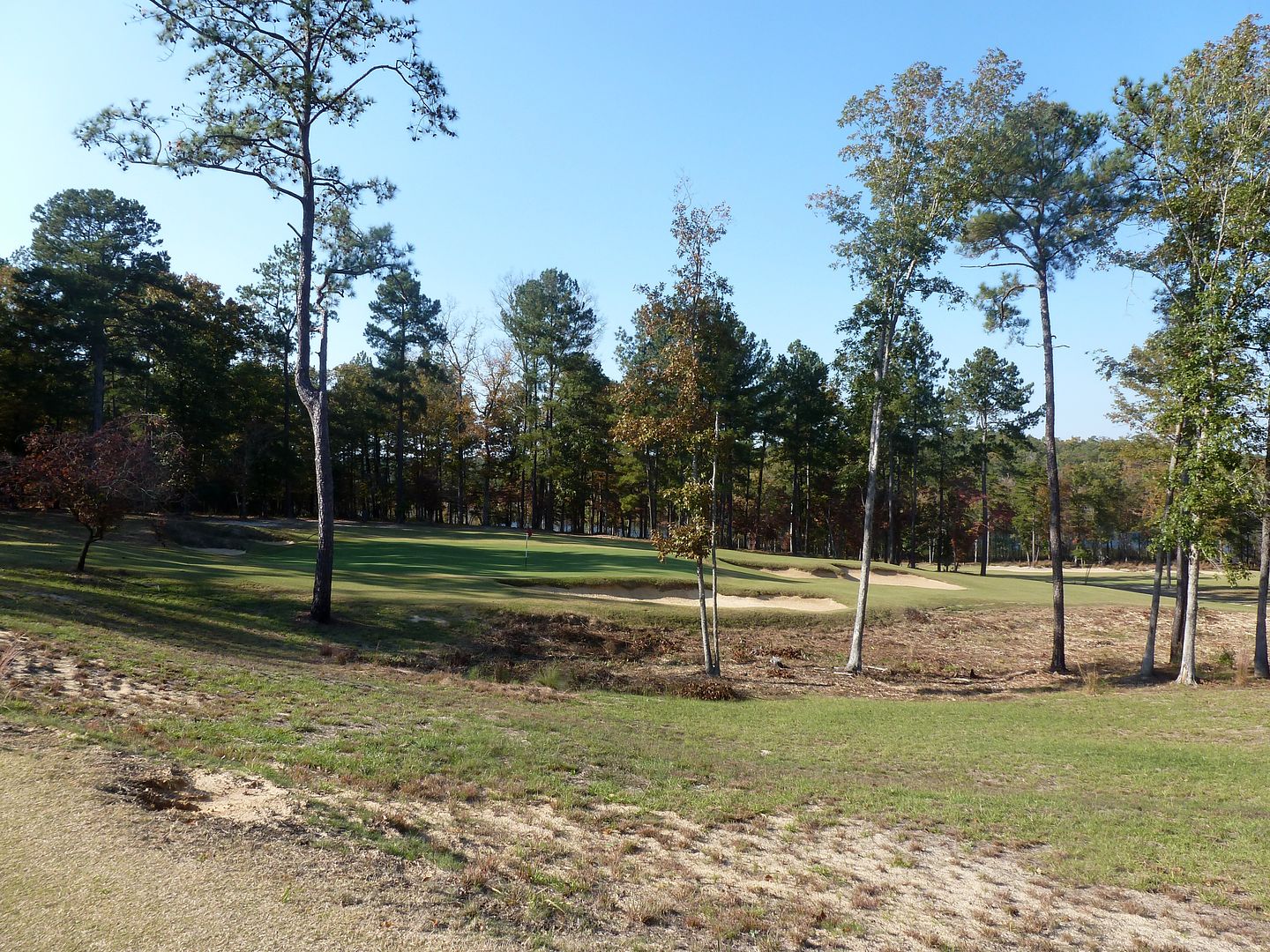
Hole 10: Par 5, 659 Yards
The 10th hole is the beginning of an exceptionally good stretch of holes. The tee shot is largely blind without make in the way of visual clues as to the ideal location for a tee ball. But, knowing that so many of the holes move left at Dormie, one could guess this one might as well (and it does). The ideal tee shot will be played with a draw to find a speed-slot that could actually allow some longer hitters an opporunity to reach the green in two. Anything played too far up the left will find a section of natural area that is cutout from the fairway.
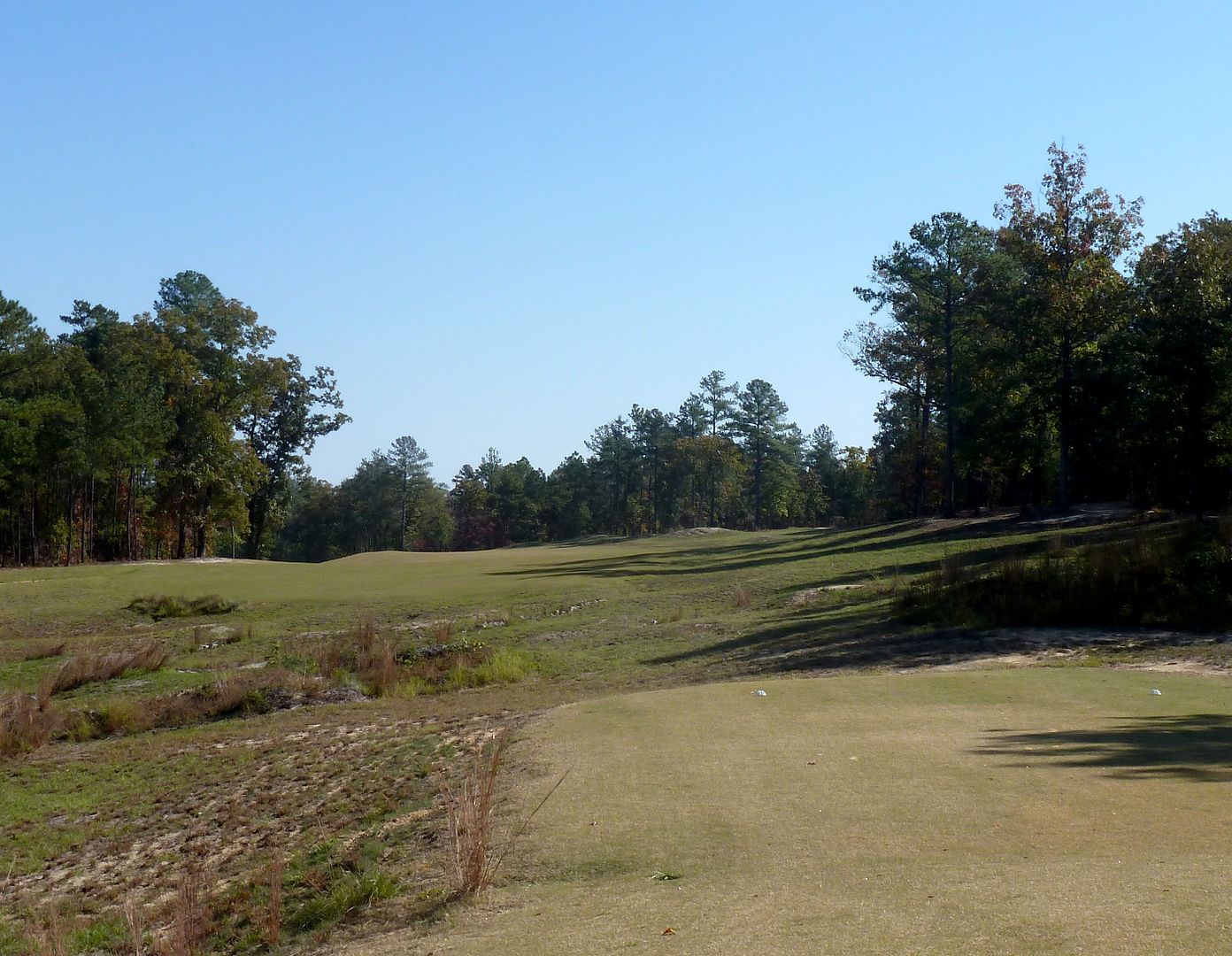
The second shot is a difficult one. Most players will have difficulty carrying the tall grass guarding the second fairway. Fortunately, there is an option to the right that allows the player to play around the tall grass. Making matters much more difficult is a single centreline bunker guarding the second shot landing area.

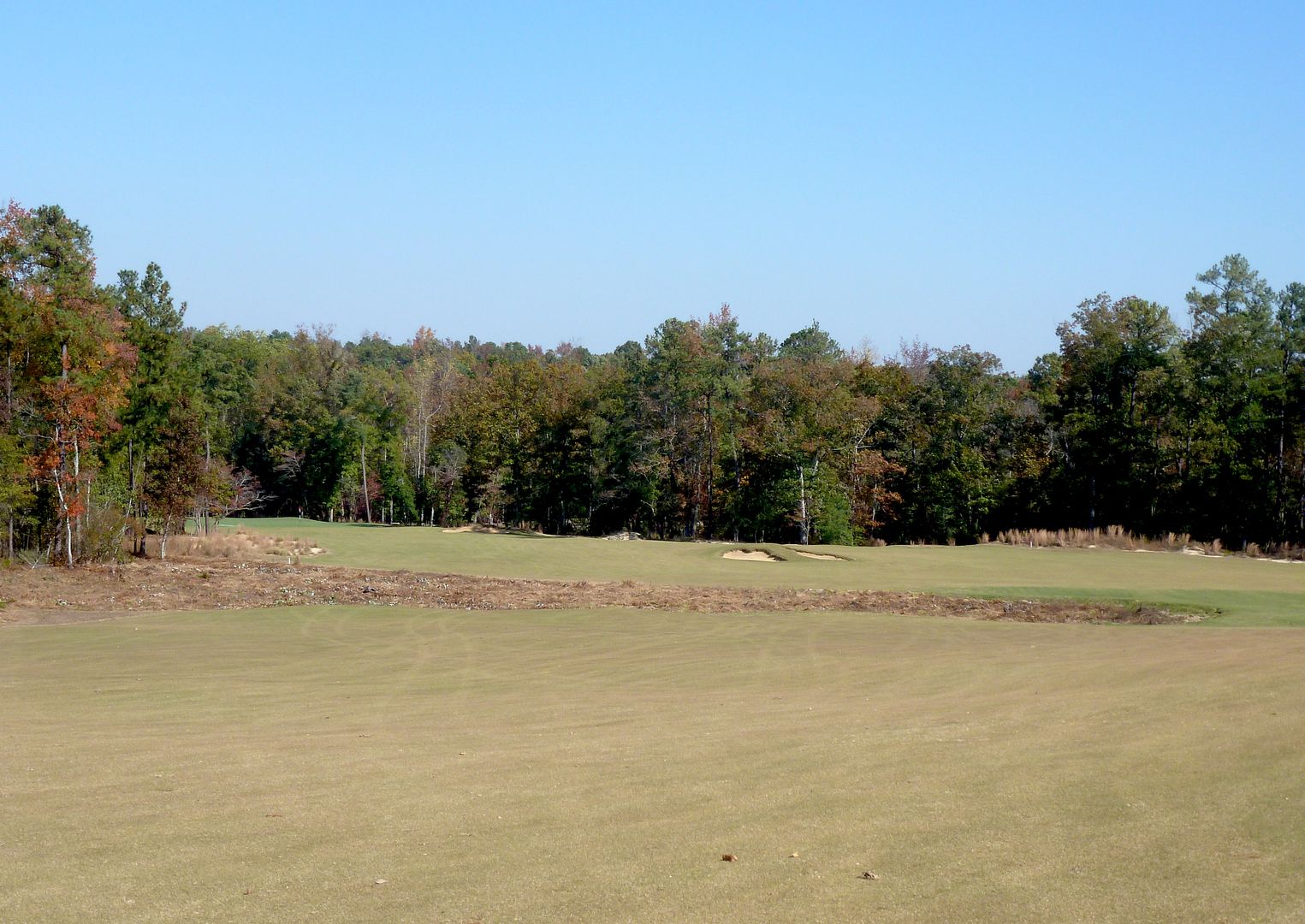
A look from the 2nd shot landing area back to the fairway:
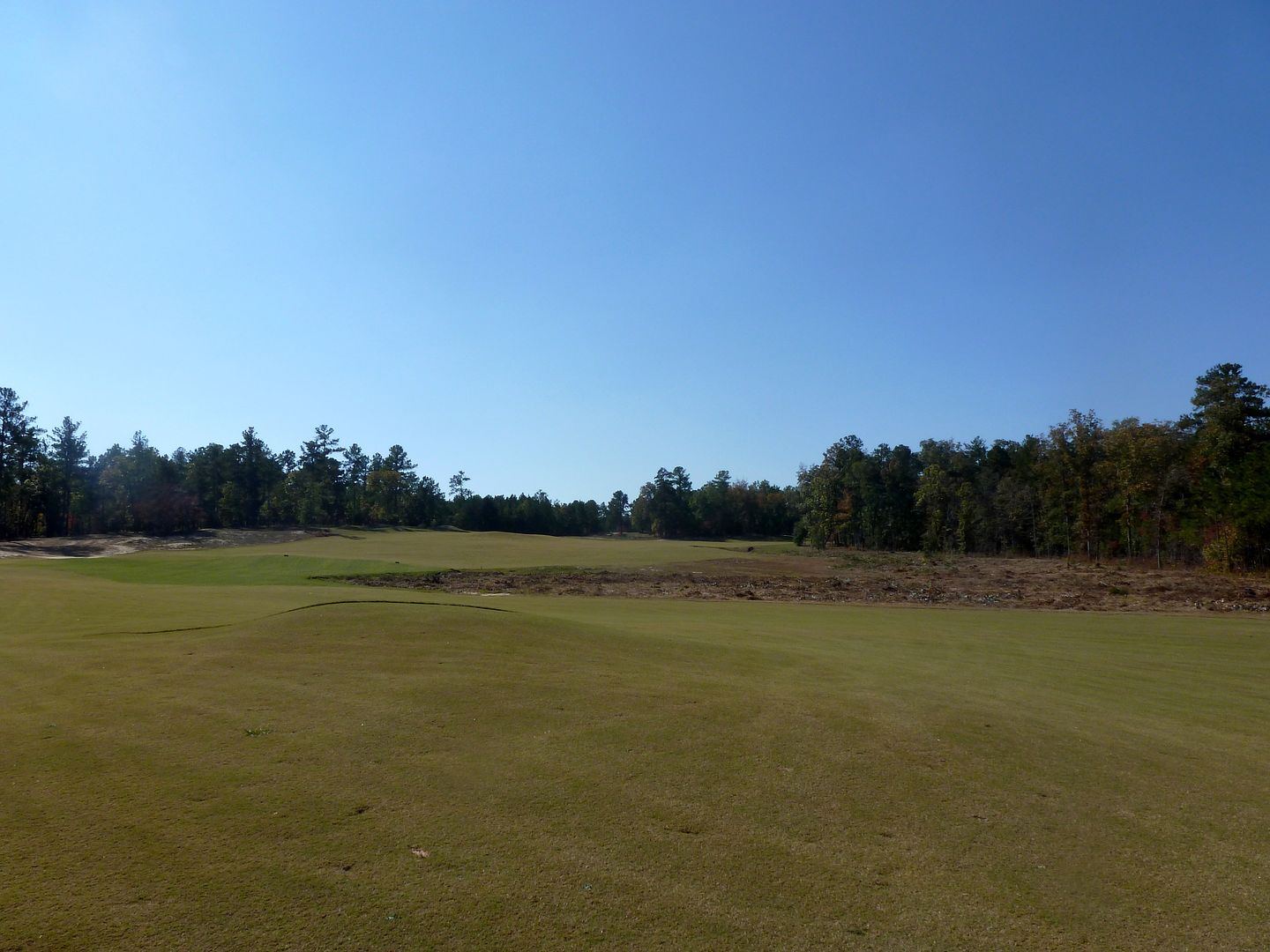
The area short of the green is guarded by bunkers on both sides of the fairway. The landing area gets narrower the closer one gets to the green.
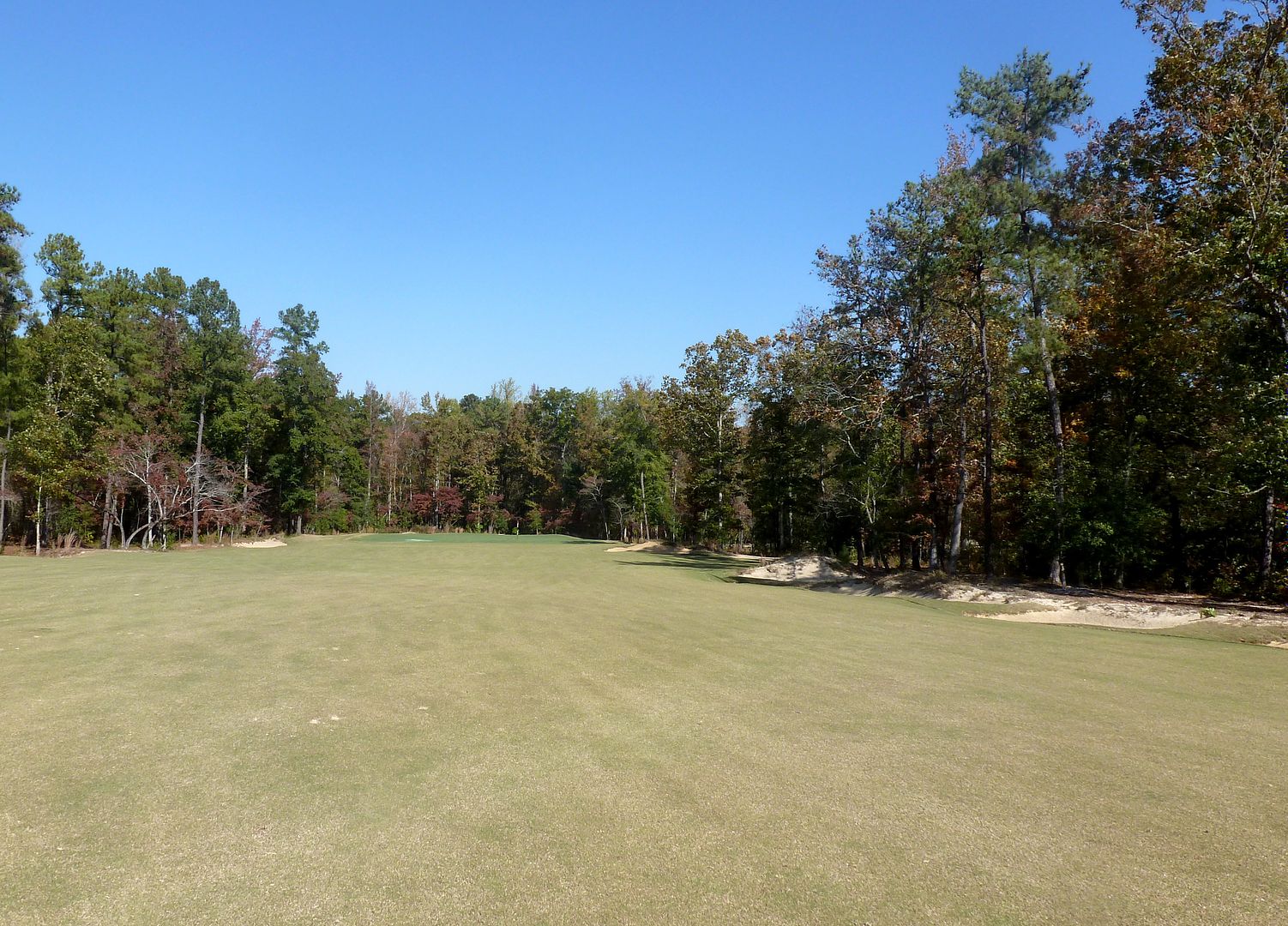

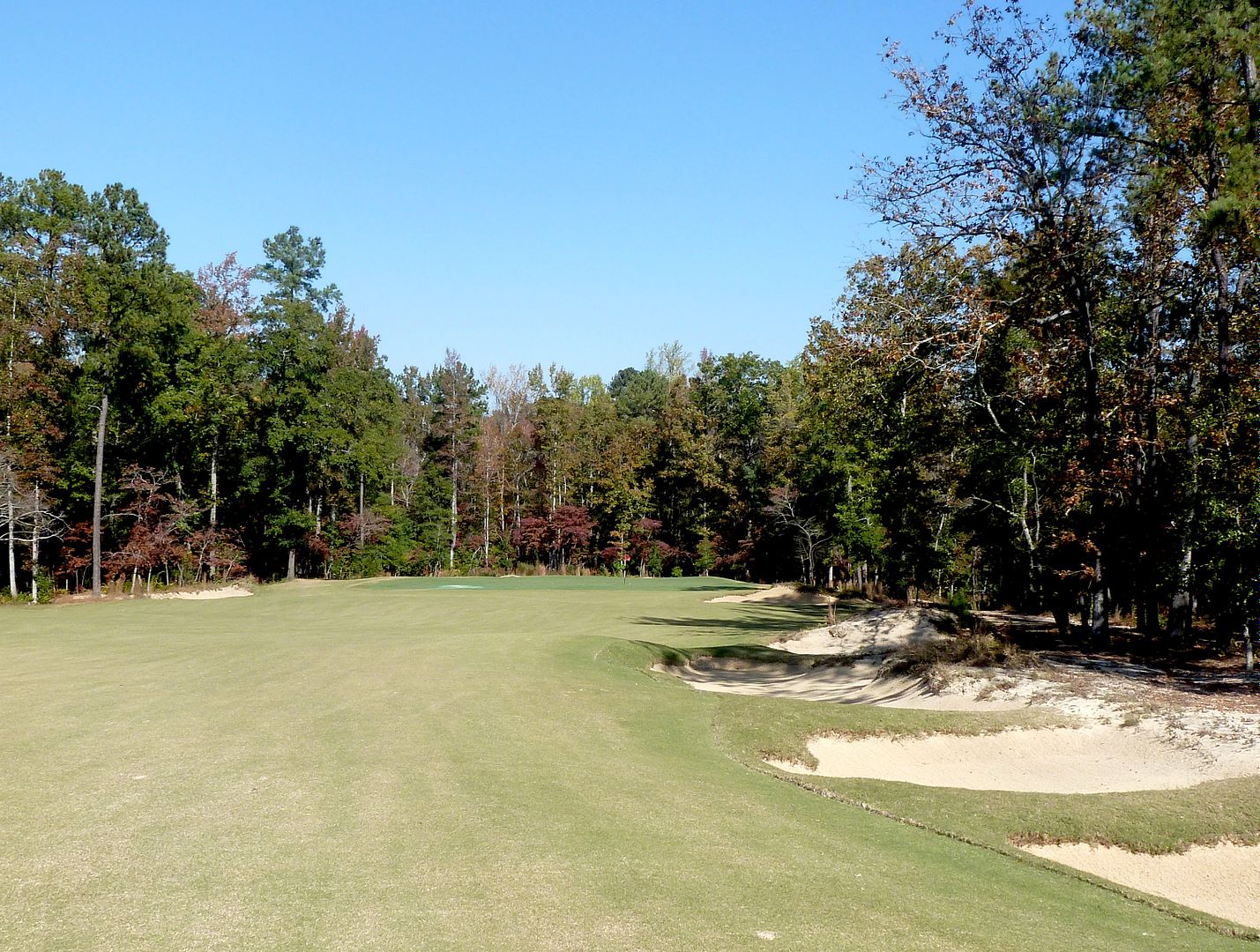
Another difficult green that slopes significantly from front-to-back.
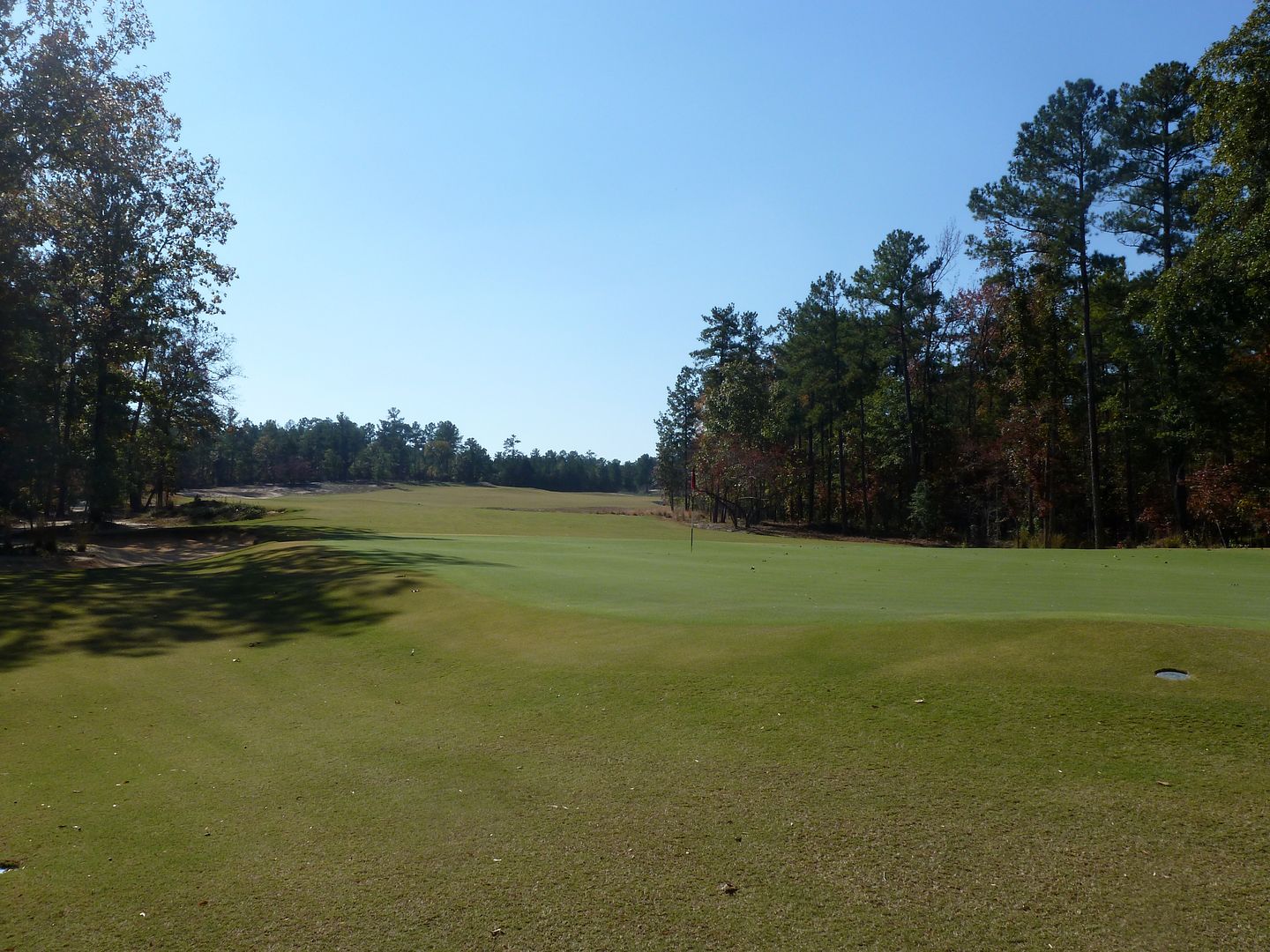
Hole 11: Par 4, 427 Yards
I loved this hole. Though it is hard to see in the pictures, the flag sits in full view over the crest of the hill on the right. It sits there, tempting the player to play farther right than is adviseable. I am sure this is no happy coincidence -- it is this type of detail that makes courses like Dormie special.
The landing area is guarded all the way down the right side by natural bunker area. At about 270 yards from the tee (a very long way uphill and into the wind), the natural area crosses the fairway at the peak of the hill and blocks-out the view of the green.
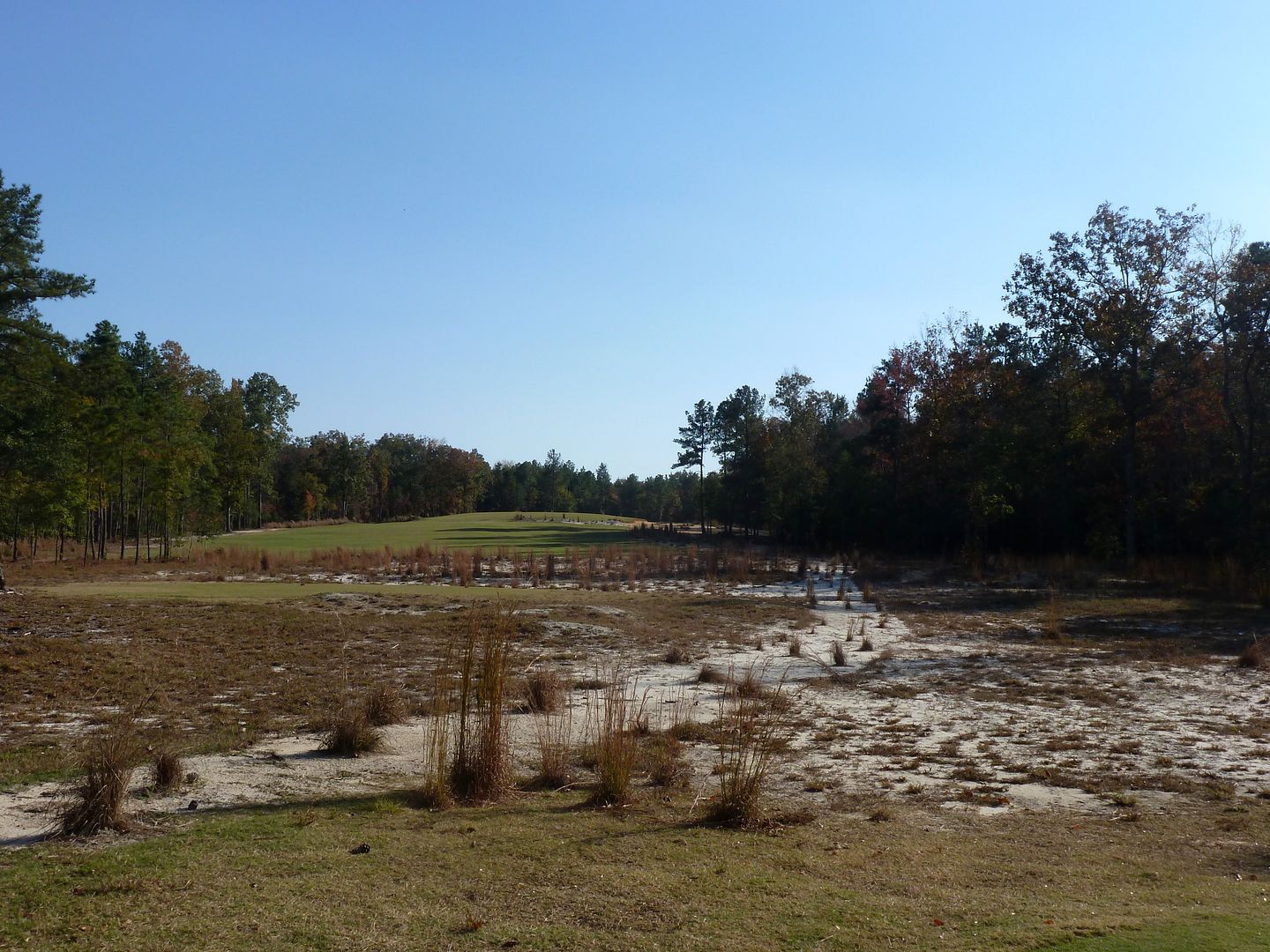
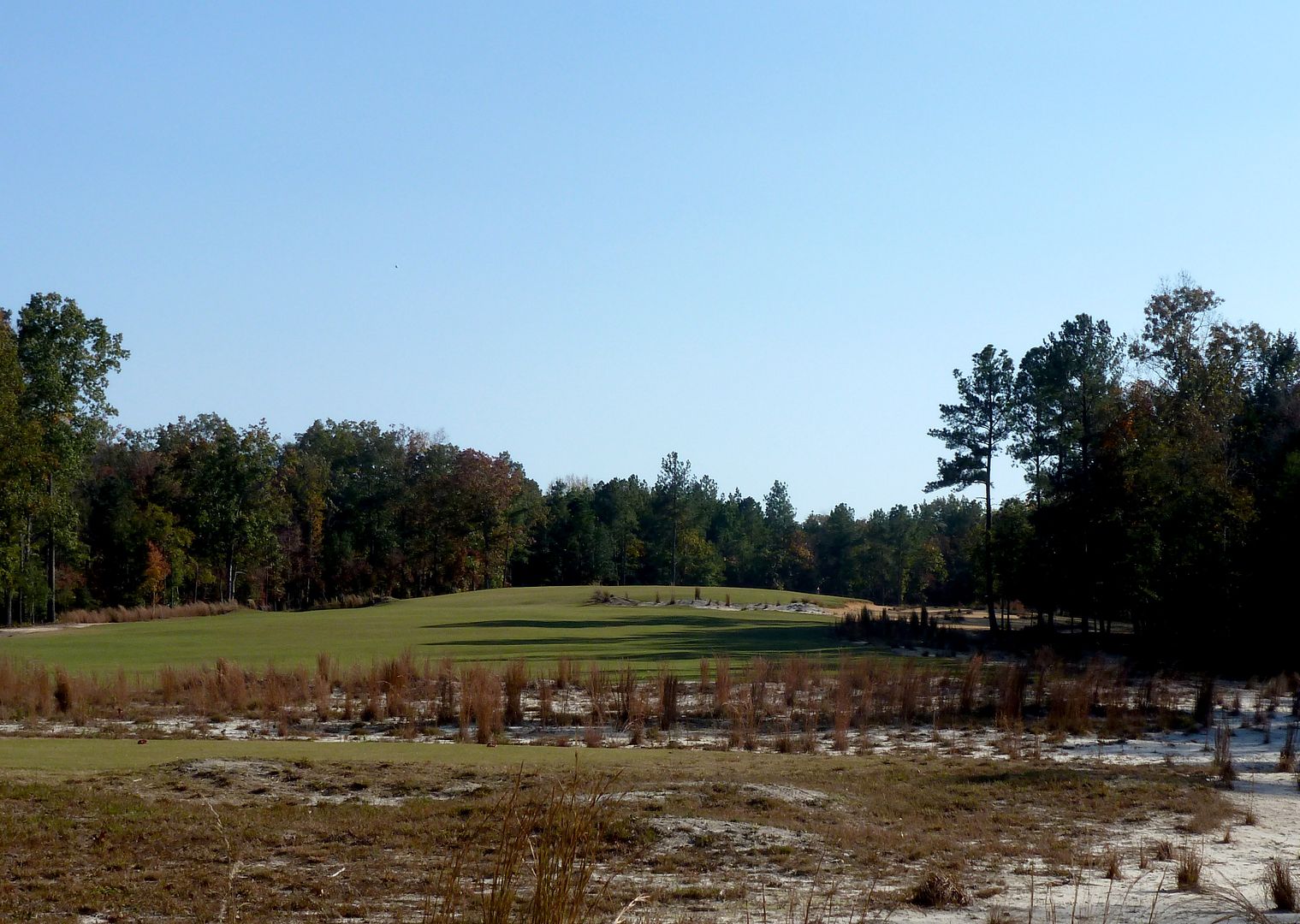
Anything but a tee shot that flirts with the edge of the bunker will have a completely blind view. If you look carefully the blind is just barely in view.

After cresting the hill, the player finds a green that is open in front and guarded by a bunker on the right. The ground short and left of the green will help to collect a ball toward the green's centre, but the player must make sure he has enough forced to get the ball over the false-front on the green.
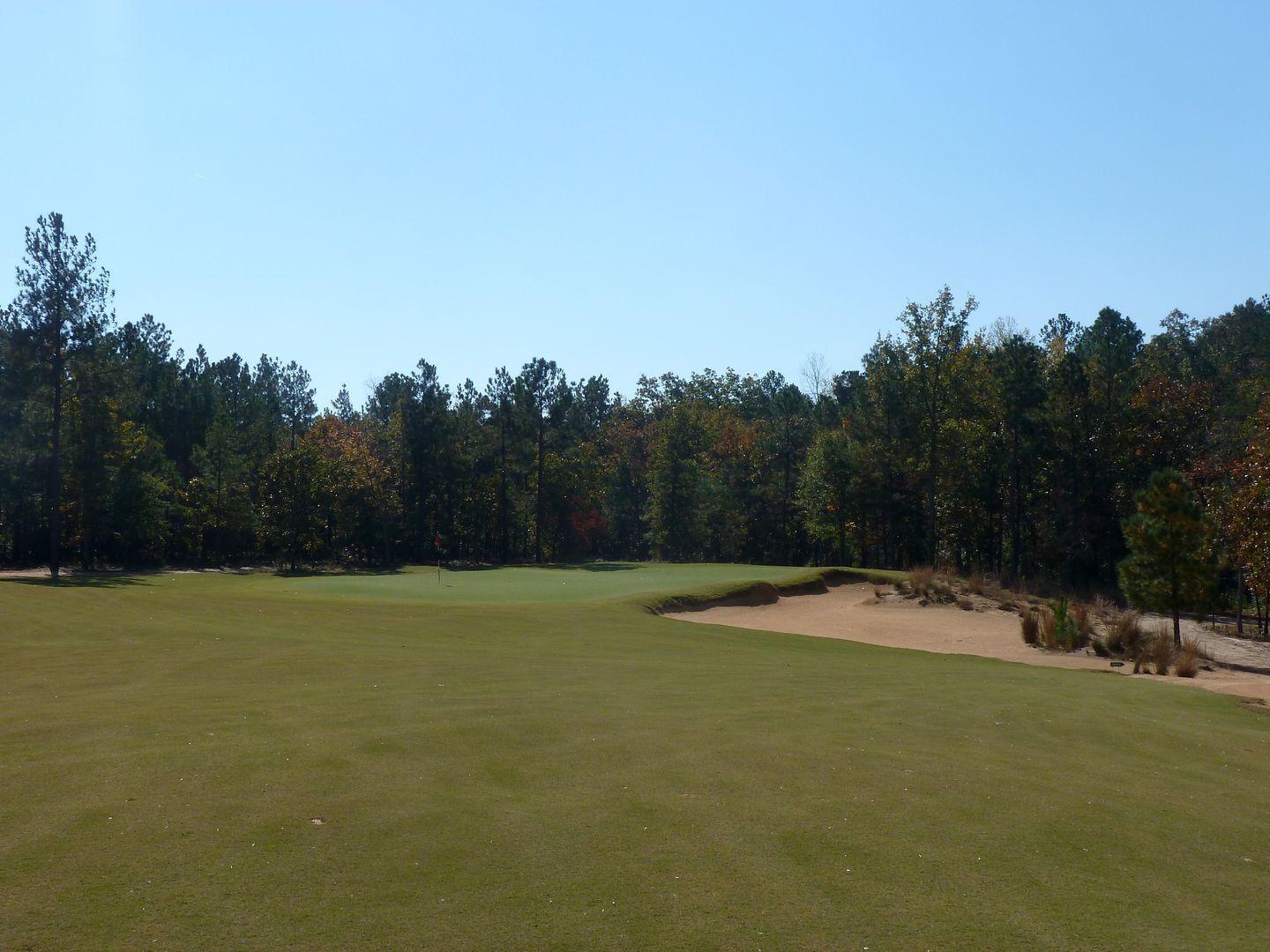
A closer look at the green.
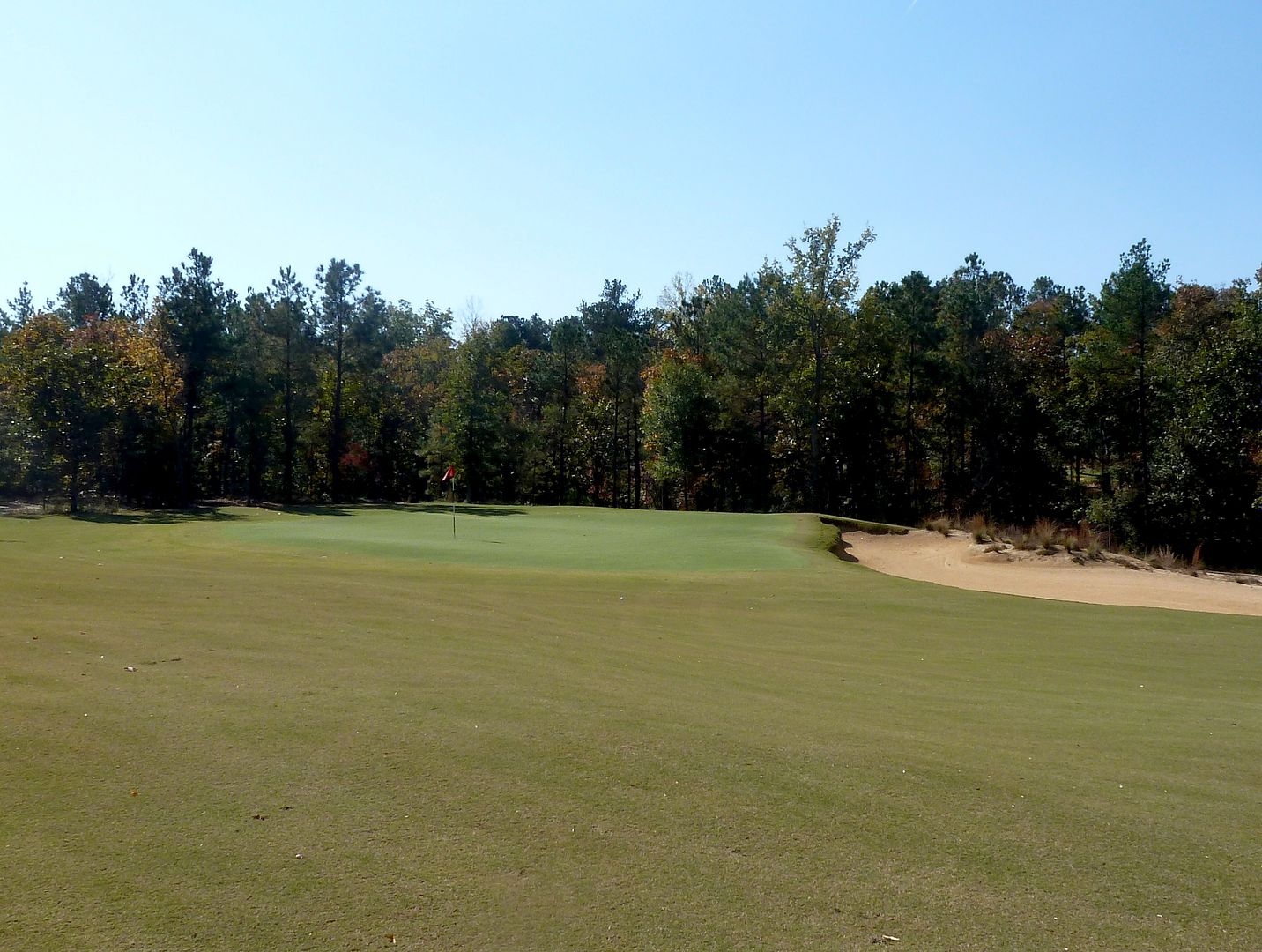
Hole 12: Par 3, 118 Yards
A fantastic short par-3. Despite it's short yardage it is very difficult to make a 2. The green is split into three sections, each of which is reasonably sized, but effectively is very small because of some large slopes on the green and a lot of tilt from back-to-front. Missing your target by a couple of yards could mean a 50 foot putt. Anything long is dead, while missing in the front bunkers is ok.
Perhaps the coolest part of this hole is the tee box. It is free form with lots of humps and bumps, but most importantly, the back tees arelower than the more forward sets. Why don't we see this more???
Of course, the decreased elevation of the back tees makes the hole play slightly longer, but also, the view of the green's surface is more limited. Moving up in sets of tees garners more advantage than mere yardage.
A look at the free-form tee box:
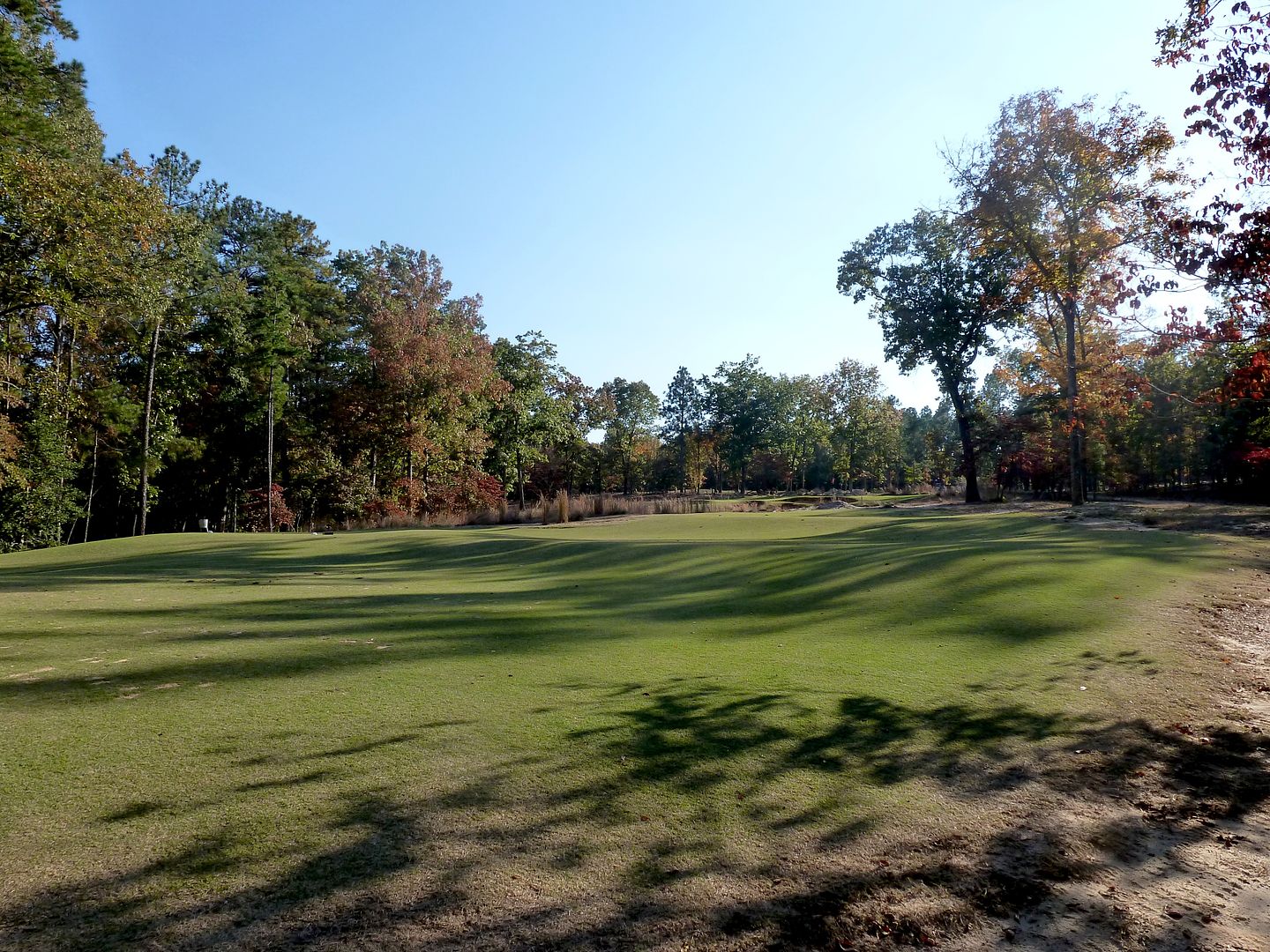
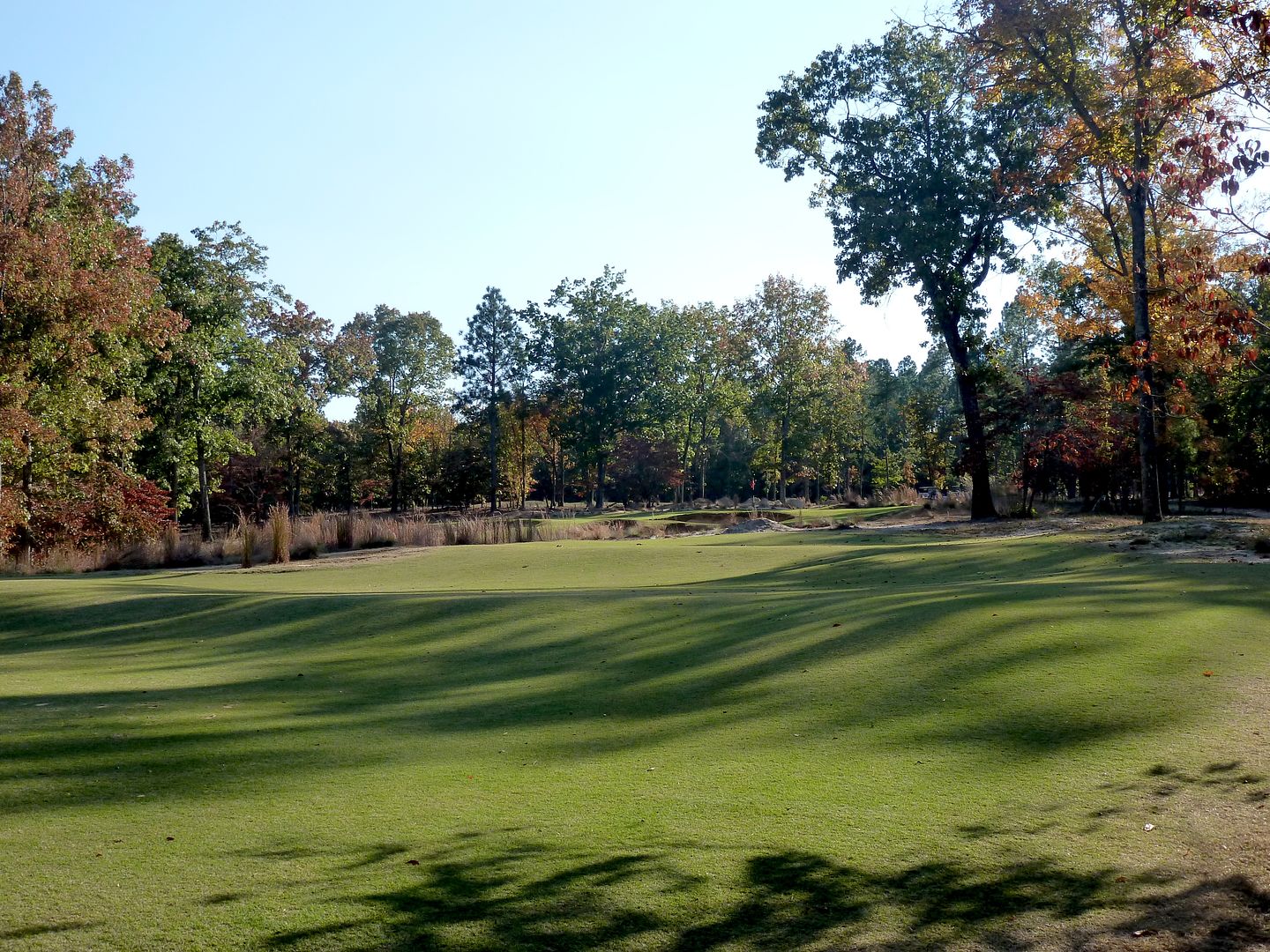
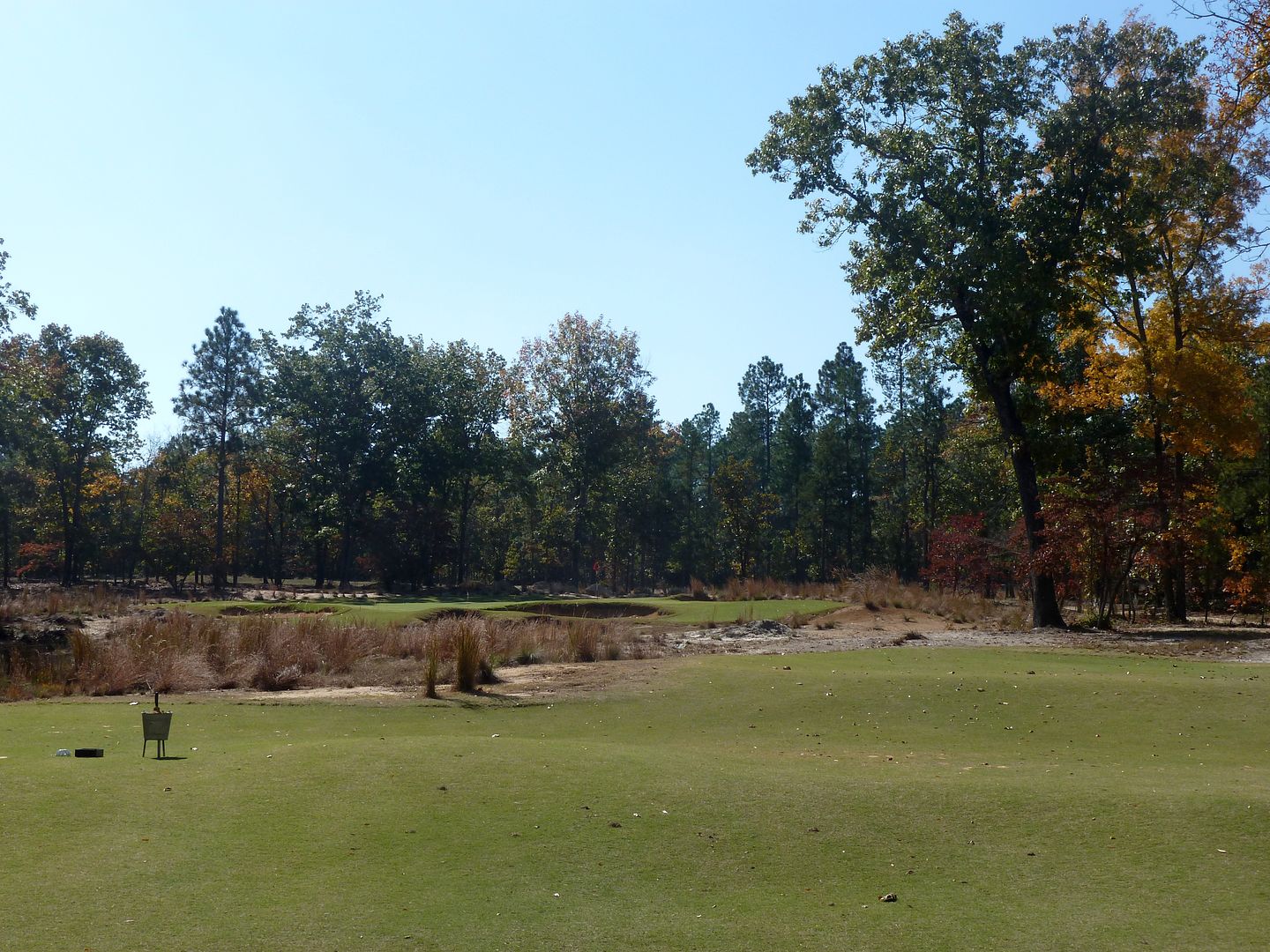
And a view of the hole as seen from the middle tee box:
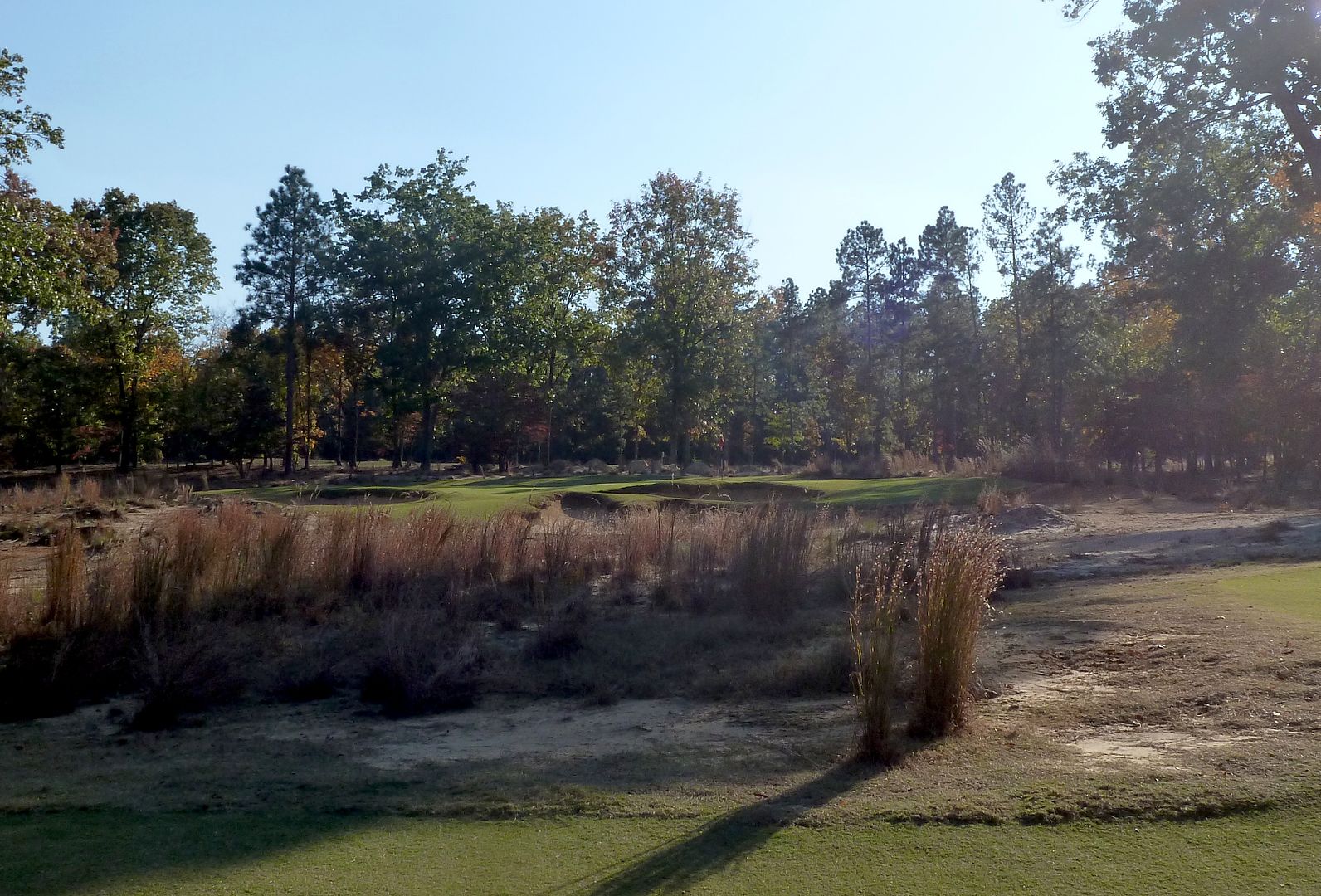
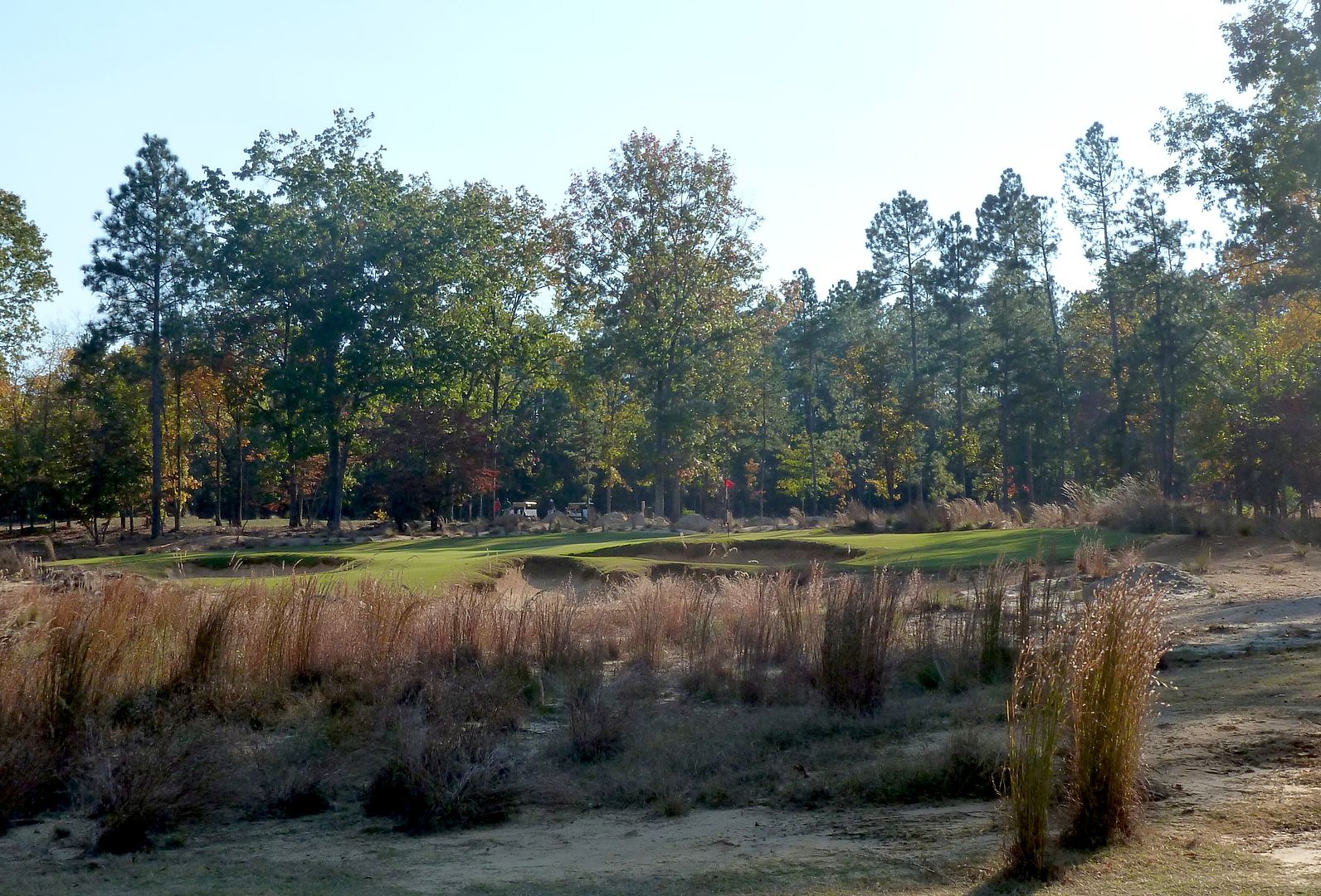
Hole 13: Par 4, 506 Yards
My lack of pictures probably reflects the fact that I think this is the least interesting hole on the course. Playing over 500 yards (470ish from middle tees) and into the wind, this hole is not reachable in regulation for the majority of golfers.
The tee shot is perhaps the widest on the course, with a single tree guarding the right side of the fairway.
The approach to the green is wide open, but the green is among the most difficult on the course, sloping very significantly from left-to-right.
The picture is taken from short-right of the green and shows some mounding that protects the green from that angle.
Note the bunker that is visible past the trees on the right -- it is the only bunker on this hole. It is long and right of the green and very difficult to find, but could come into play if a shot is played with too much strength toward the centre of the green and catches the significant left-to-right slope. When I saw that bunker I said to my caddie, "if I hit a great 3-wood at the green and run through into that bunker, I'm pretty sure when I saw where my ball ended up I'd say 'are you f*$%ing kidding me?'" He said, "the one guy I've ever seen in that bunker said exactly that."

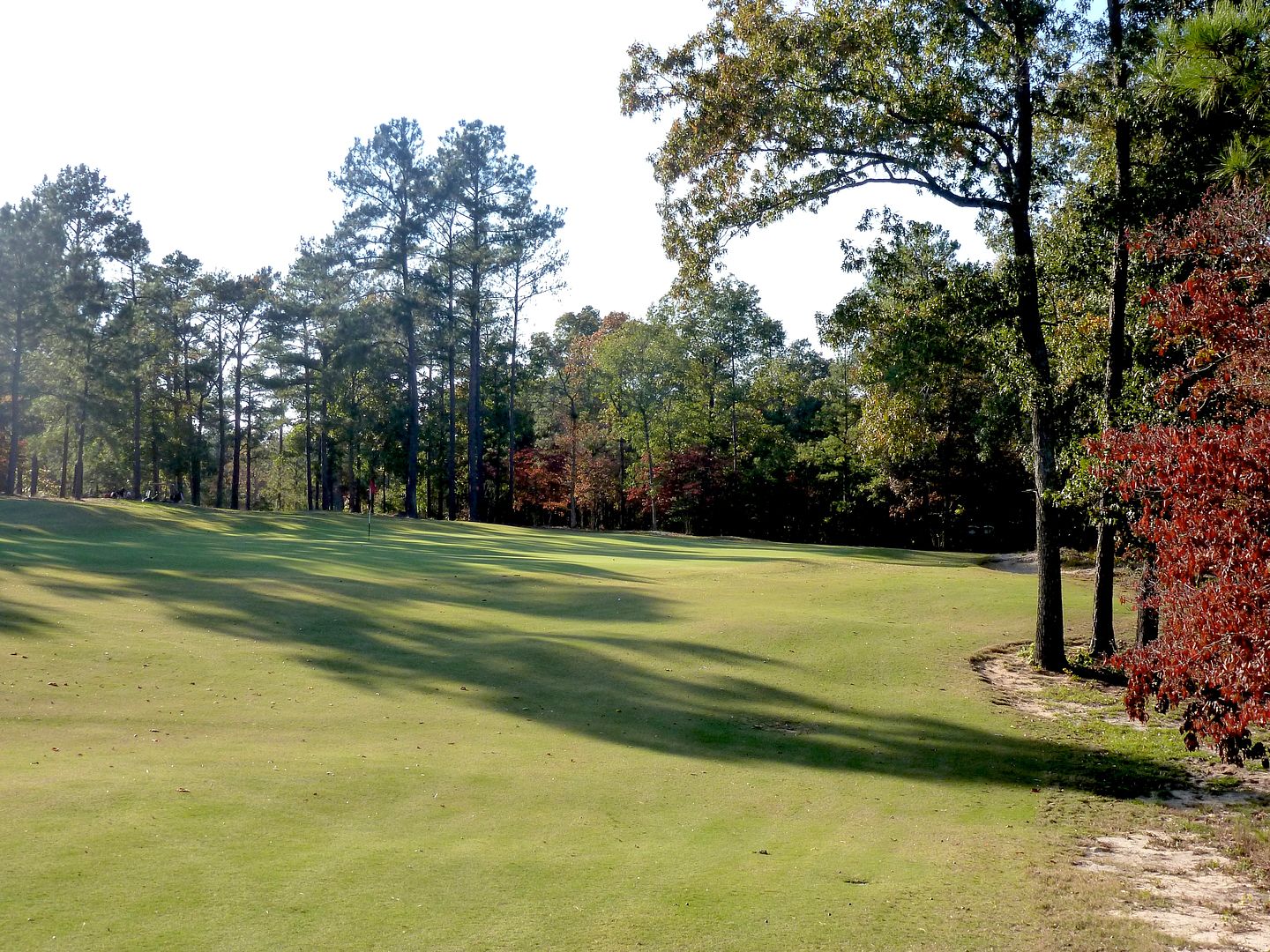
Hole 14: Par 4, 307 Yards
In another thread (http://www.golfclubatlas.com/forum/index.php/topic,48133.0.html) Matt Ward extolled the virtues of the 14th and 15th holes at Dormie Club in Pinehurst, NC. It seems that almost everyone agreed, but for a single dissenting opinion. I am the second to disagree. N.B. I loved the golf course as a whole.
I am not saying the holes are bad, just that something seems off with them. They are holes that should provide many strategic options/decisions, but I believe for any given player, there will be only a single way to play the hole and this is because of an unbalanced risk/reward equation. On 14 there is too little reward to justify any risk, and on 15 there is too significant a risk to justify the reward.
Let's begin with the 14th. A nice respite after the 500+ yard, into the wind, par 4 13th, no doubt. But, in my mind, it is a very mediocre short par-4.
At 307 yards, uphill, there are only a handful of players who can reach the green from the tee. For this select group, the hole is probably very interesting. I'm not part of this group and could care less how the hole plays for them.
Much like the 14th at Bandon Trails, the ideal tee shot will hug the left side of this fairway, which cants severely from left-to-right. Aside from a steep run-off on the right side of the green, that seems to be where the similarity ends. There will be no debate about whether or not this hole is fair. There is zero reason not to make 4 (or 3). The green is protected by a solitary bunker at the front-right portion of the green (up-and-down from here is not a problem).
Ostensibly (and perhaps in practice) the ideal approach is from the left, where one has a choice between a lofted approach and a ground -game option (though, let's be honest, how many even in this group will opt for anything but the LW from 75 yards). The approach from the right is visually intimidating because of the bunker, but simple in practice. The green slopes somewhat severely from back-left to front-right, making approaches from the right side of the fairway very easy to control once they land on the green (ie they will stop quickly).
A somewhat bad spot (though certainly recoverable - my playing partner made 3 from there) is just short of the bunker leaving a delicate chip.
The only really bad spot off the tee is missing in the left woods.
So here's my question: with woods left and trouble right, it being impossible to reach the green for most players, and an approach from short-right being one of the toughest spots, does this hole not become a bore with the prudent player always hitting hybrid(ish) to the centre/right part of the fairway, and SW into the slope of the green? I understand that in matchplay, things change, but there is no way a thinking player will ever hit driver here. Just so little reward for the added risk.
From the Tee
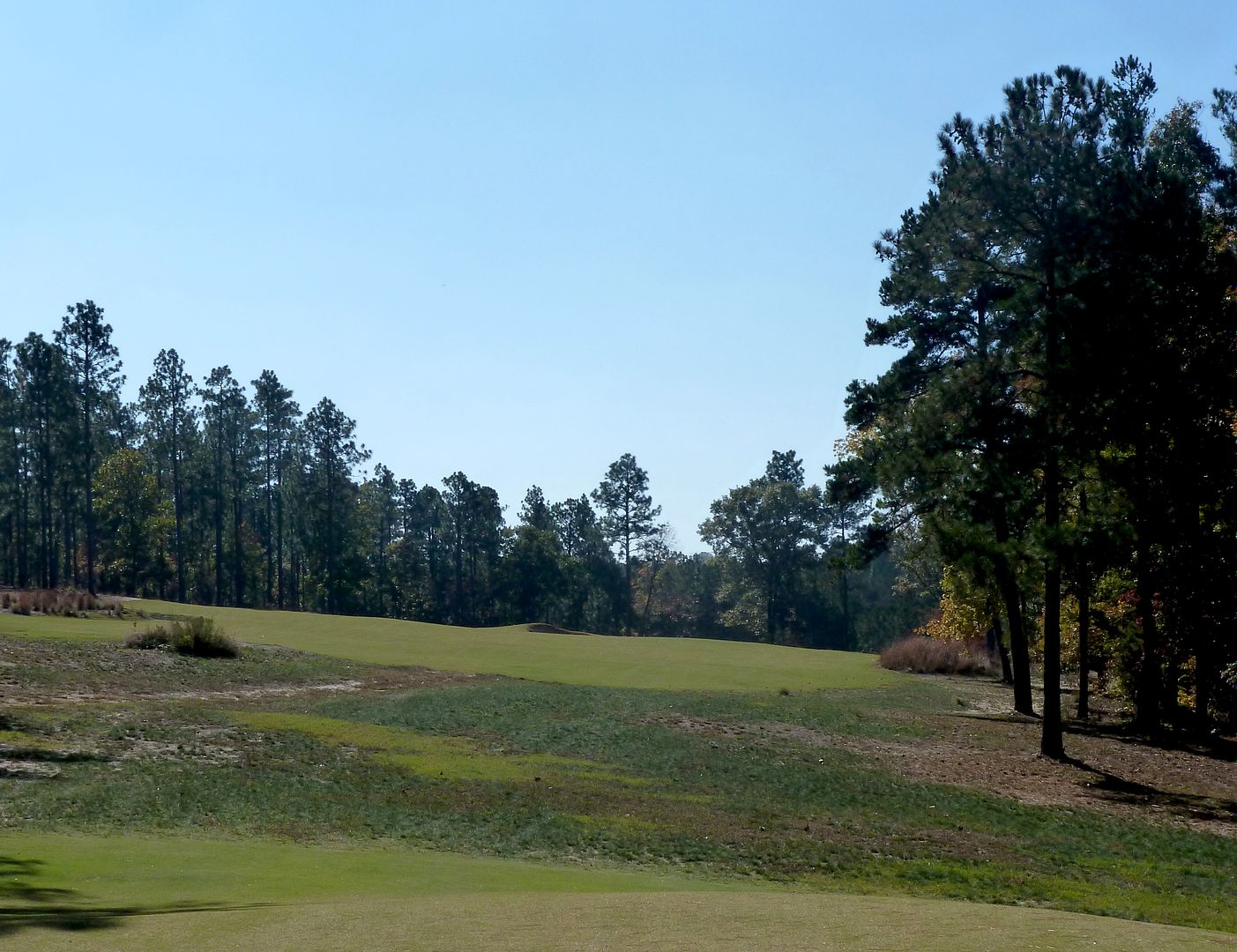
Approach from the Left
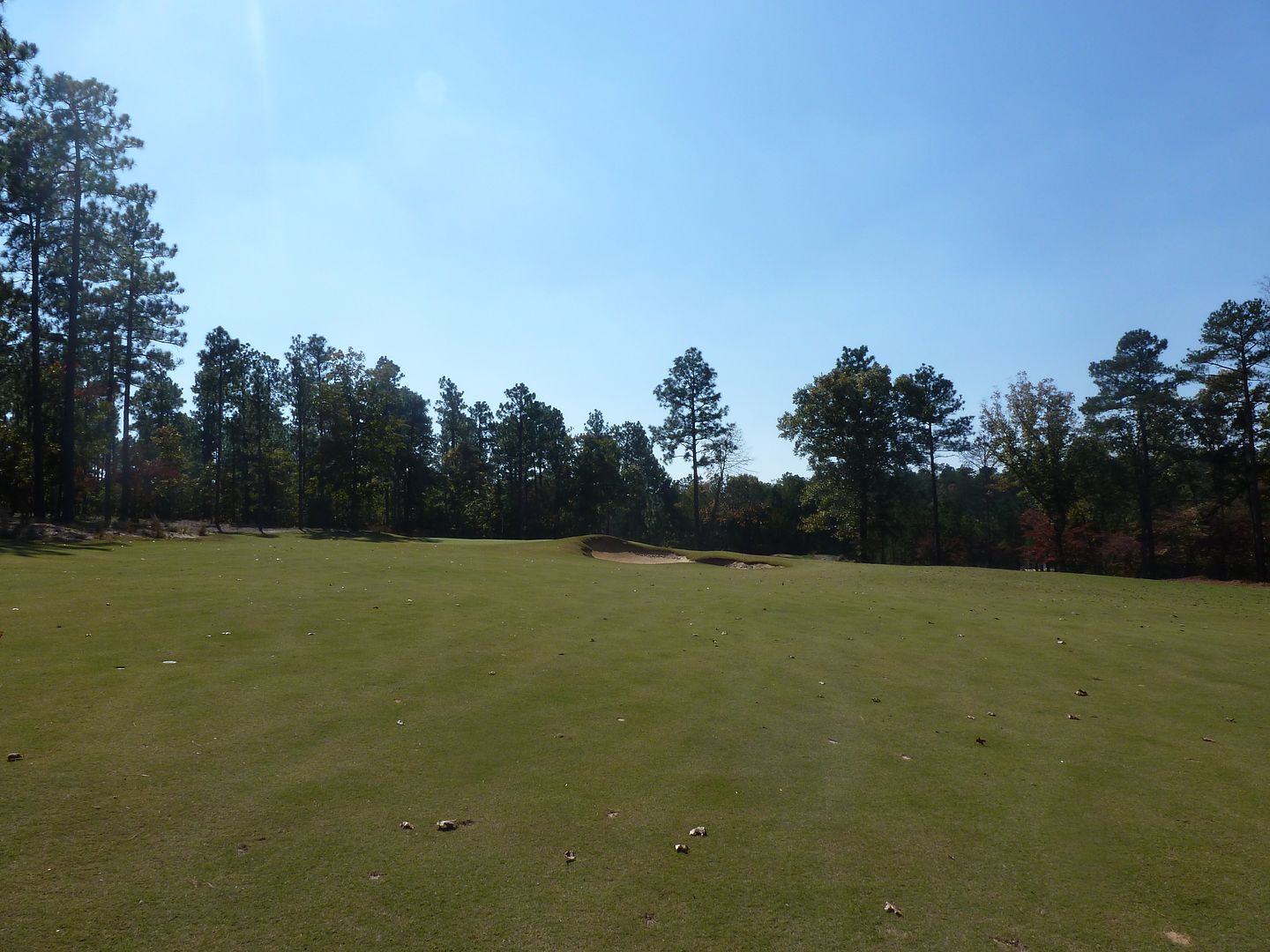

Approach from the Right
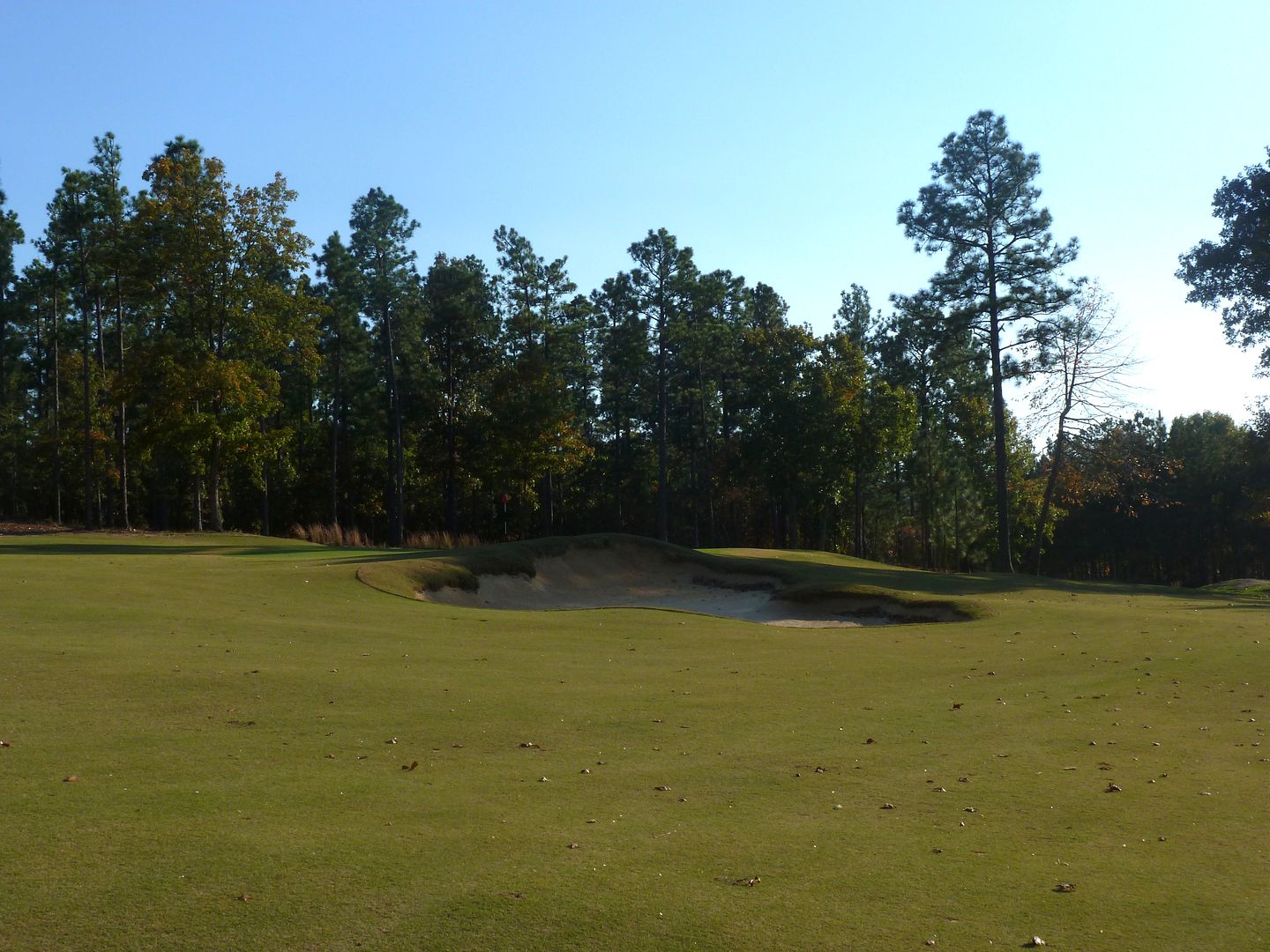
Hole 15: Par 4, 387 Yards
A tee shot we've all seen many times before, a forced carry over a diagonal hazard. After the tee shot, however, this is no ordinary hole. An interesting aspect discussed by Ed Oden here (http://www.golfclubatlas.com/forum/index.php/topic,46385.0.html) is that the green is in view from the tee but is blind from the fairway (also note, the 11th at The Dormie Club also has this feature).
From the tees I played, it is a 215 yard carry over the hazard at the left side of the fairway bunkers. Given the severe angle of the crossing hazard, the carry gets much longer on more aggressive lines. The fairway bunkers (which are a terrible spot to approach from) mean that even for bombers, there is no option to just 'kill it and find it.' The green is probably 340 yards on a straight line and I suppose is reachable for a select few, but again, I don't worry about them.
Off the tee, anything missed just a bit right, to quote Mr. Ward, is "reload city." There is no way anyone will purposely challenge the right side. Given the long carry off the tee, most players will not hit anything but driver. Longer players could challenge the right side by tying to be more precise with hybrid (or similar), but our caddies said that "no one ever, ever tries that. If you can carry with hybrid, great. Hit hybrid just left of the bunkers." So much for options.


Now the hole gets interesting. This picture is taken from the centre of the fairway and on a line that very few players would ever be purposely right of. Clearly, the approach is completely blind, hitting over the hill. Unfortunately, I don't have a picture, but from the right 1/3 of the fairway, one has a clear view of the green.
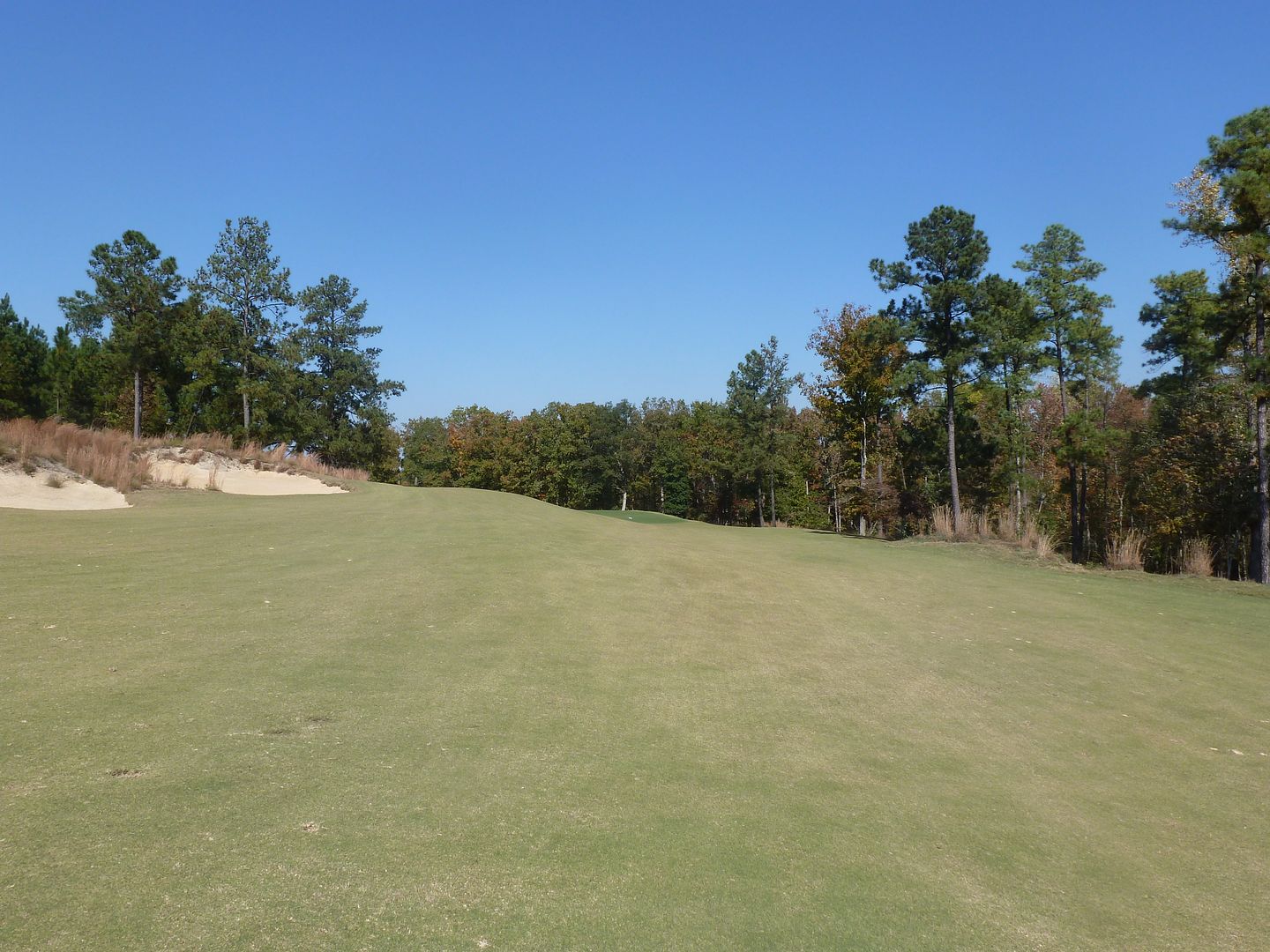
Over the hill is a very unique green, playing at almost a 45 degree angle to the left side of the fairway. There is a signficant downslope short of the green and a huge back ridge the helps stop balls from going over the green (both are very flattened by the camera). The problem is that the target is so narrow that almost no one can aim for it. Our caddies said you just hit the ball up on the hill short of the green and hope it rolls onto the green. Usually it does, but sometimes it doesn't, and then you're screwed. OK, fine, rub of the green and all that, but when approaching from the right you don't have this issue. You have a clearer look up the throat of the green with sideboards. A great opportunity for 3.
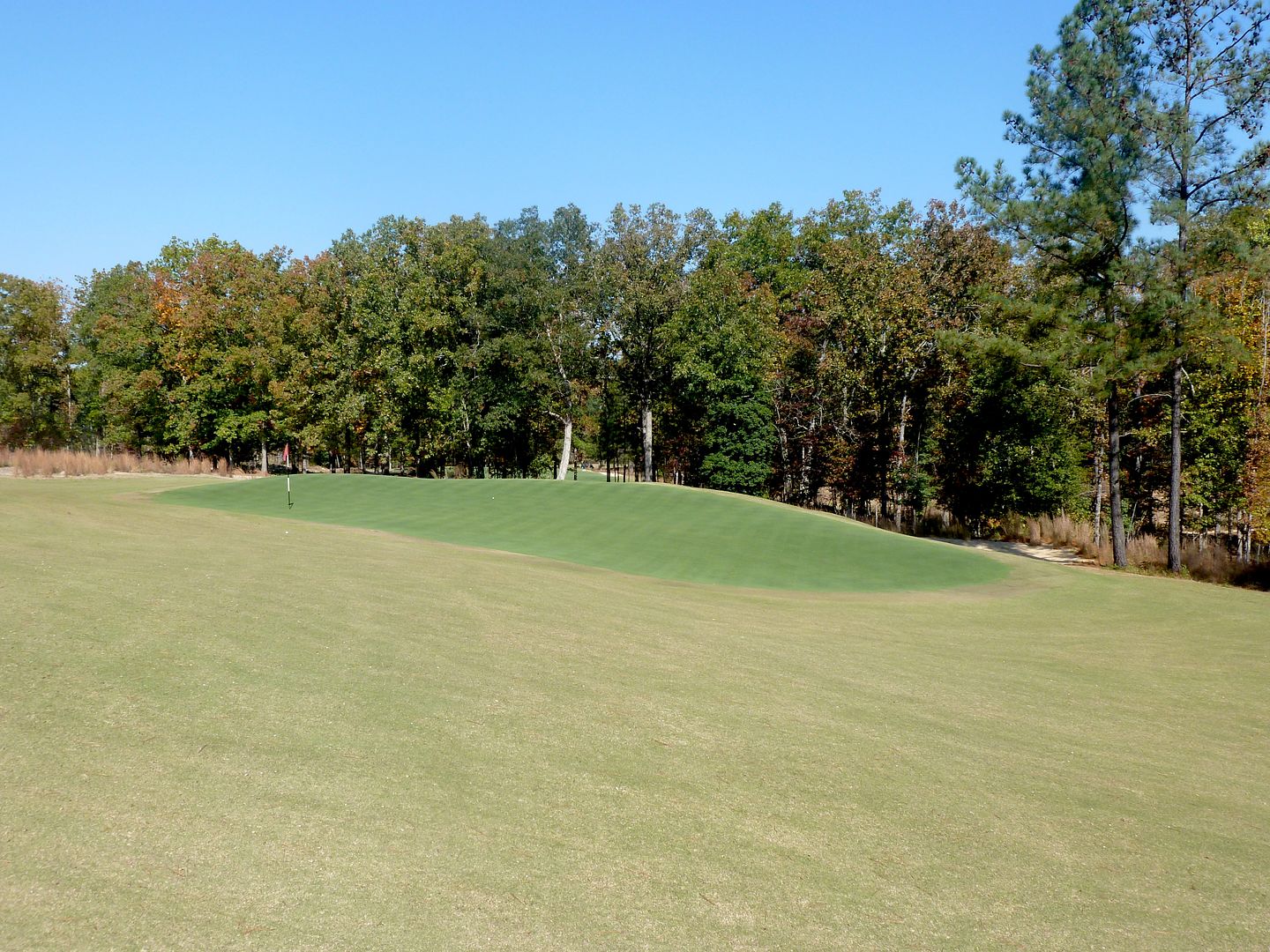
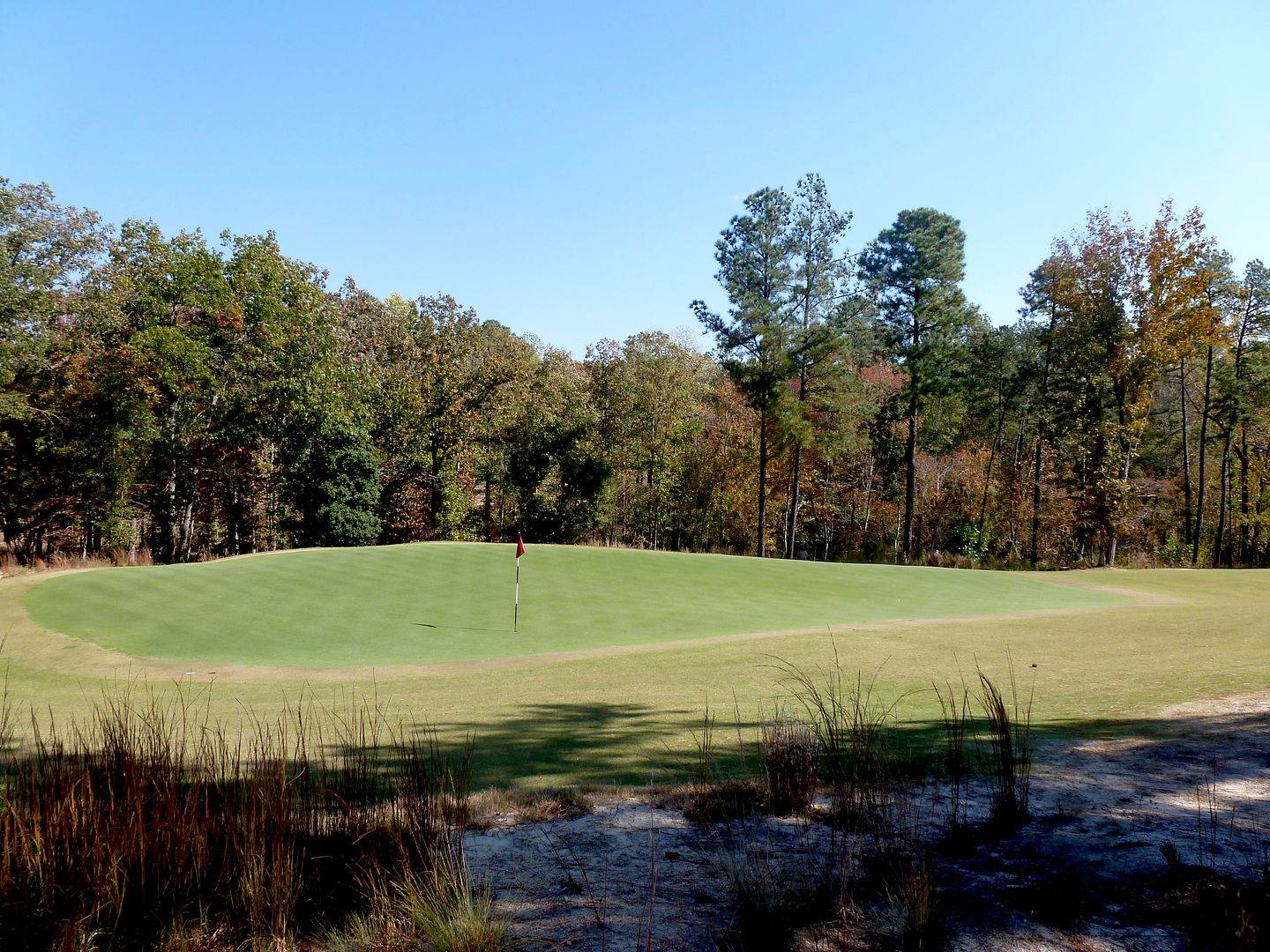
And a look at the severe penalty for missing long/right
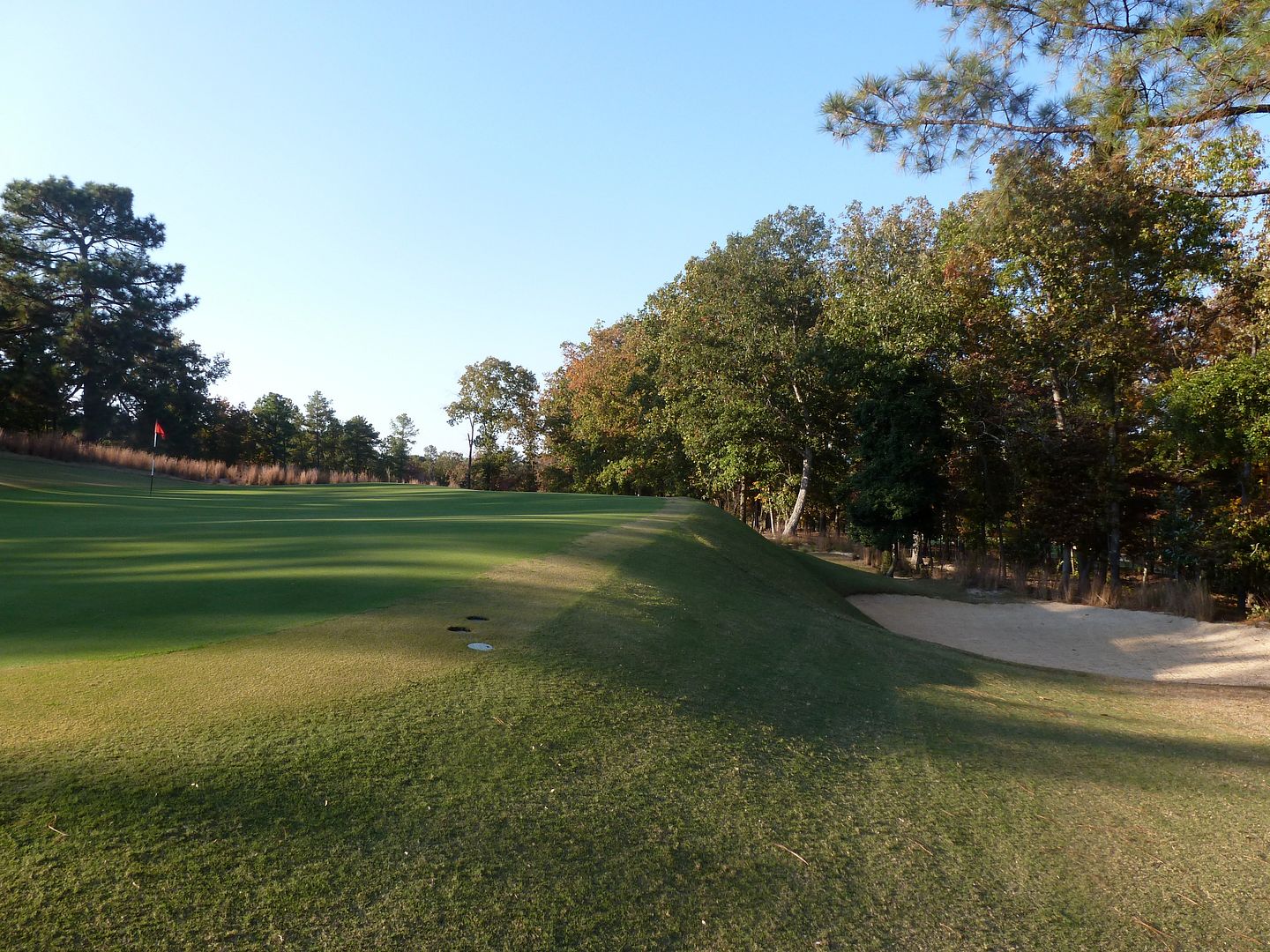
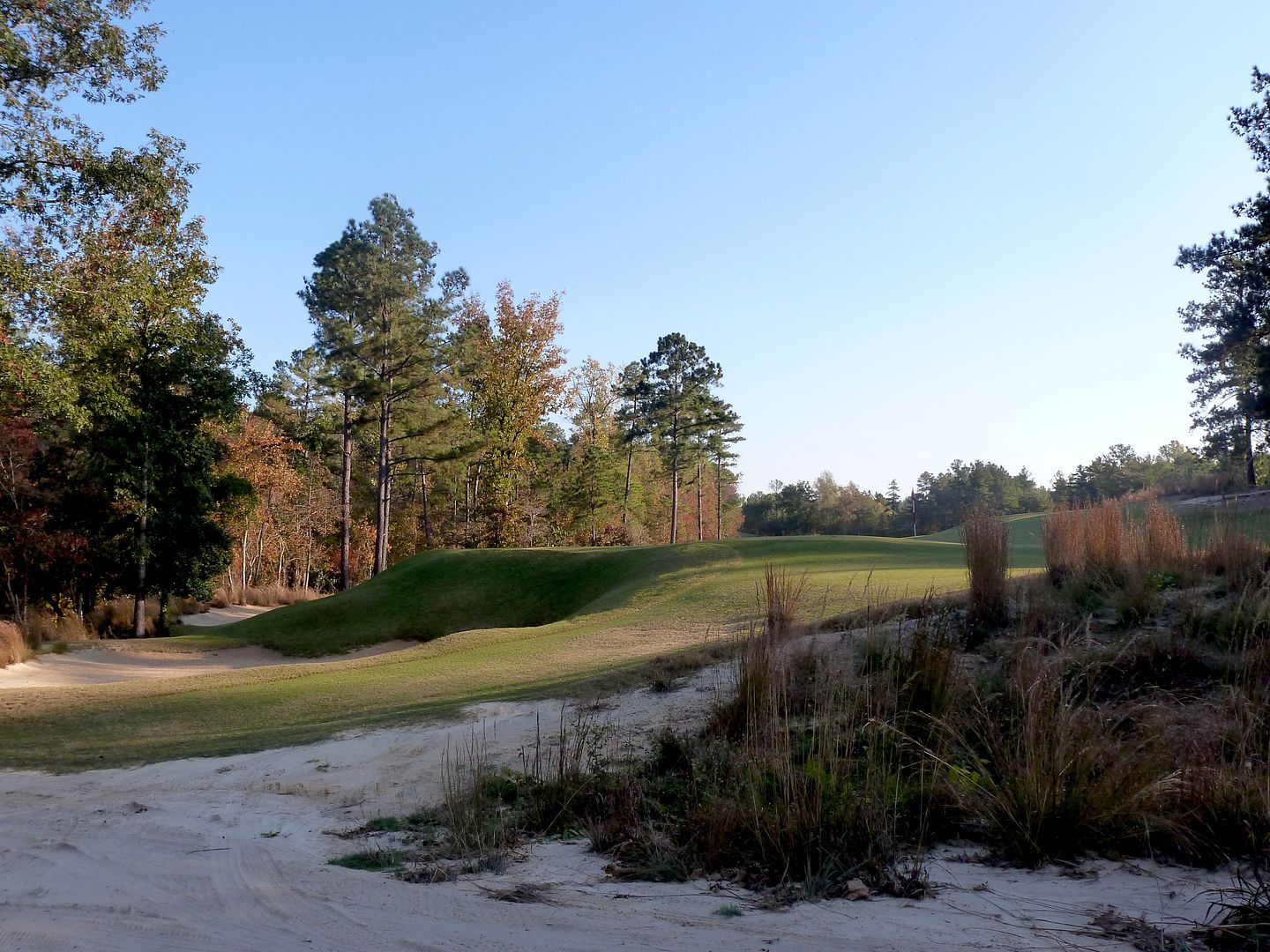
So here's my problem: This is such a cool approach, but I feel for almost all who play it, too much of it will come down to luck. There is definitely a benefit to being on the right side of the fairway, a big one, but not one big enough to justify a stroke and distance penalty. I think C&C just barely missed the mark here. If the hole was shorter (and the forced carry shorter), it would be exceptional. If the angle of the hazard were not quite as severe, it could be exceptional. As is, it is lay-up tee shot, luck approach, but it could be so much more.
Hole 16: Par 3, 202 Yards
Just an OK par-3 in my mind. Mid-length and downhill to a square-shaped green. Not really a lot happening here.
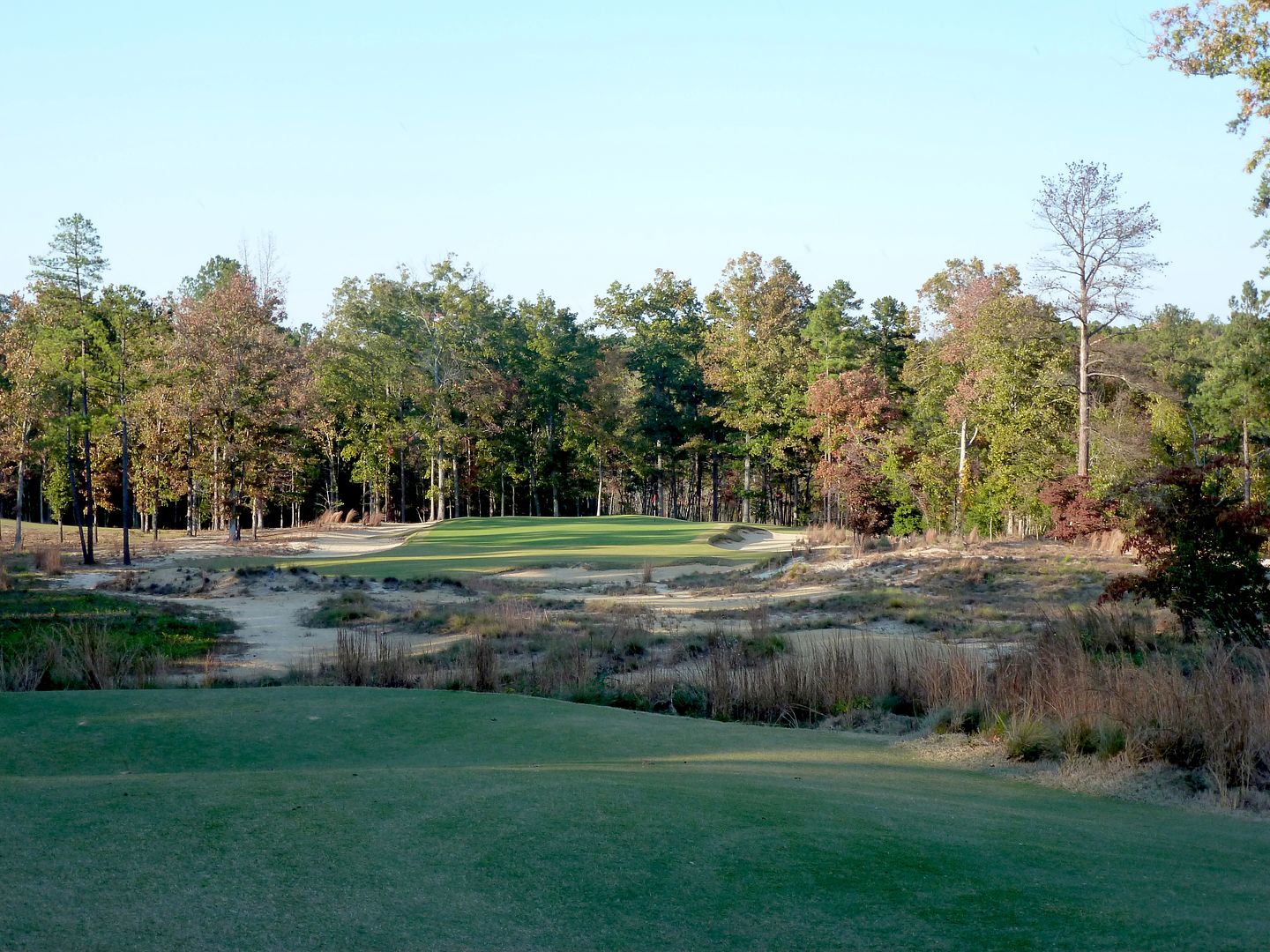
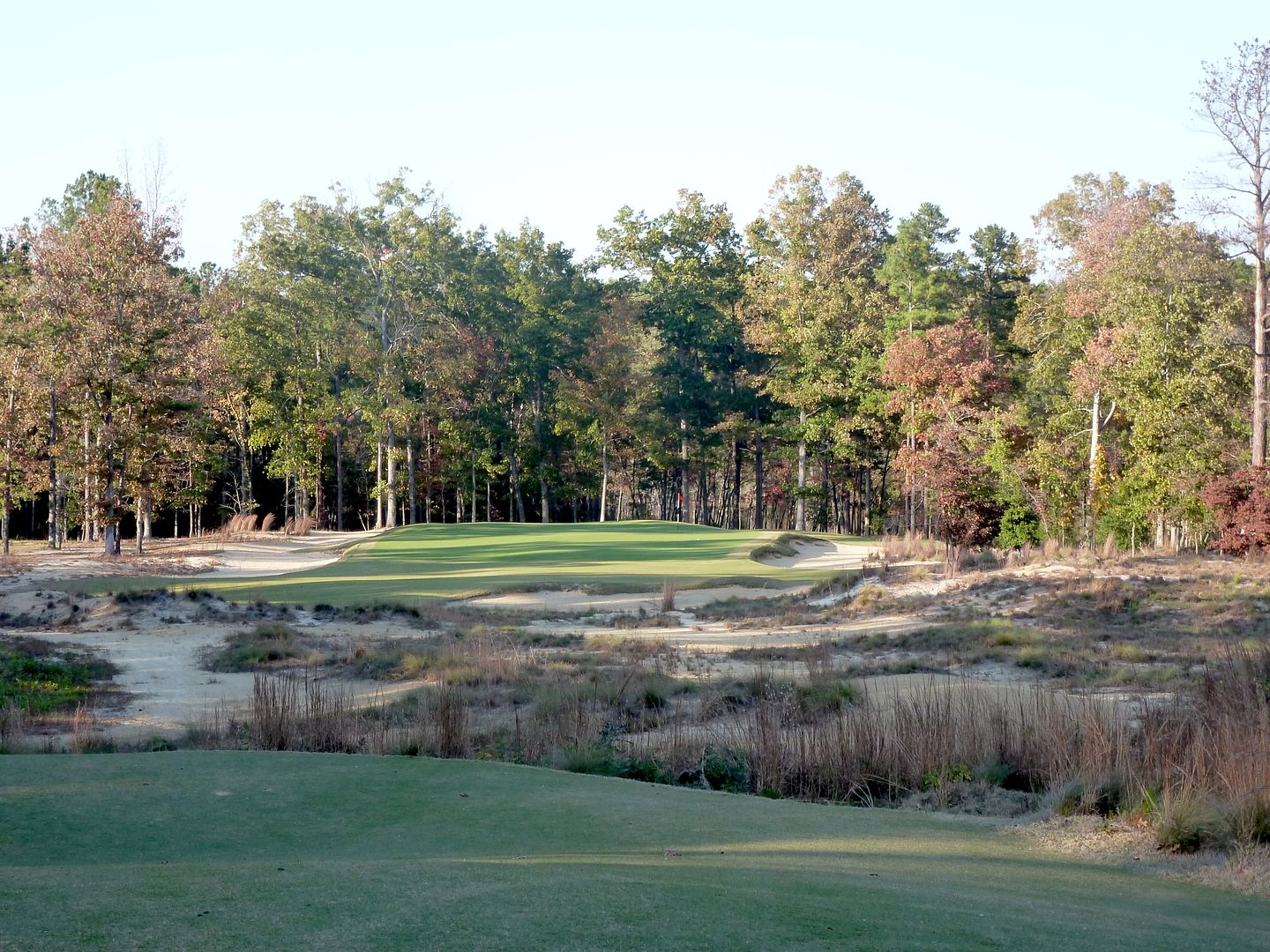

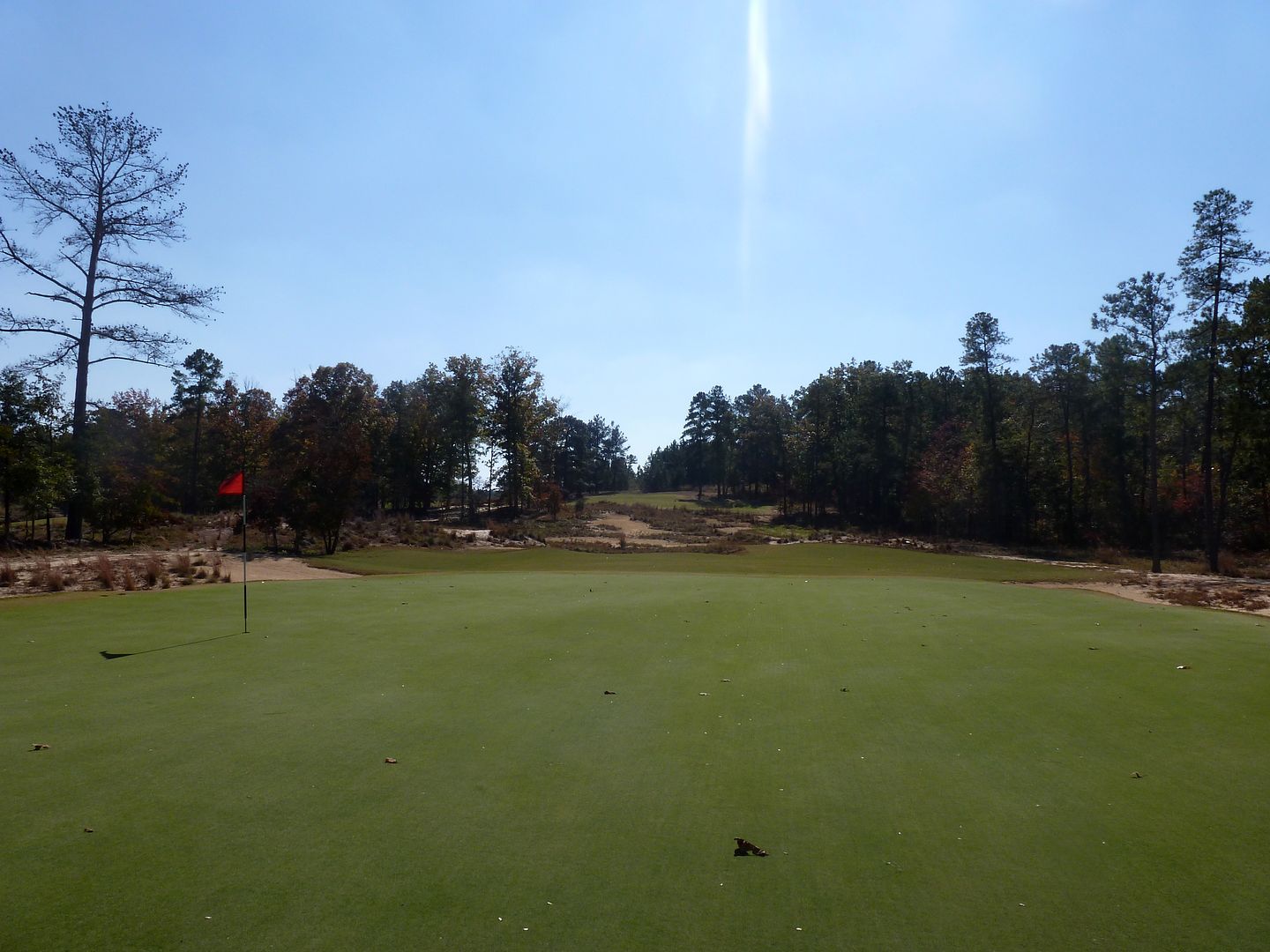
Hole 17: Par 5, 506 Yards
The 17th caps a phenomenal set of par-5s. The tee shot is played into the wind and the ideal tee shot will skirt the bunker on the inside corner of the dogleg. Players not thinking of going for the green in two have plenty of room to play to the right with less than driver -- but don't push a driver as two of the deepest bunkers on the course guard the right side of the fairway about 250-280 yards from the tee.
Back tee view.
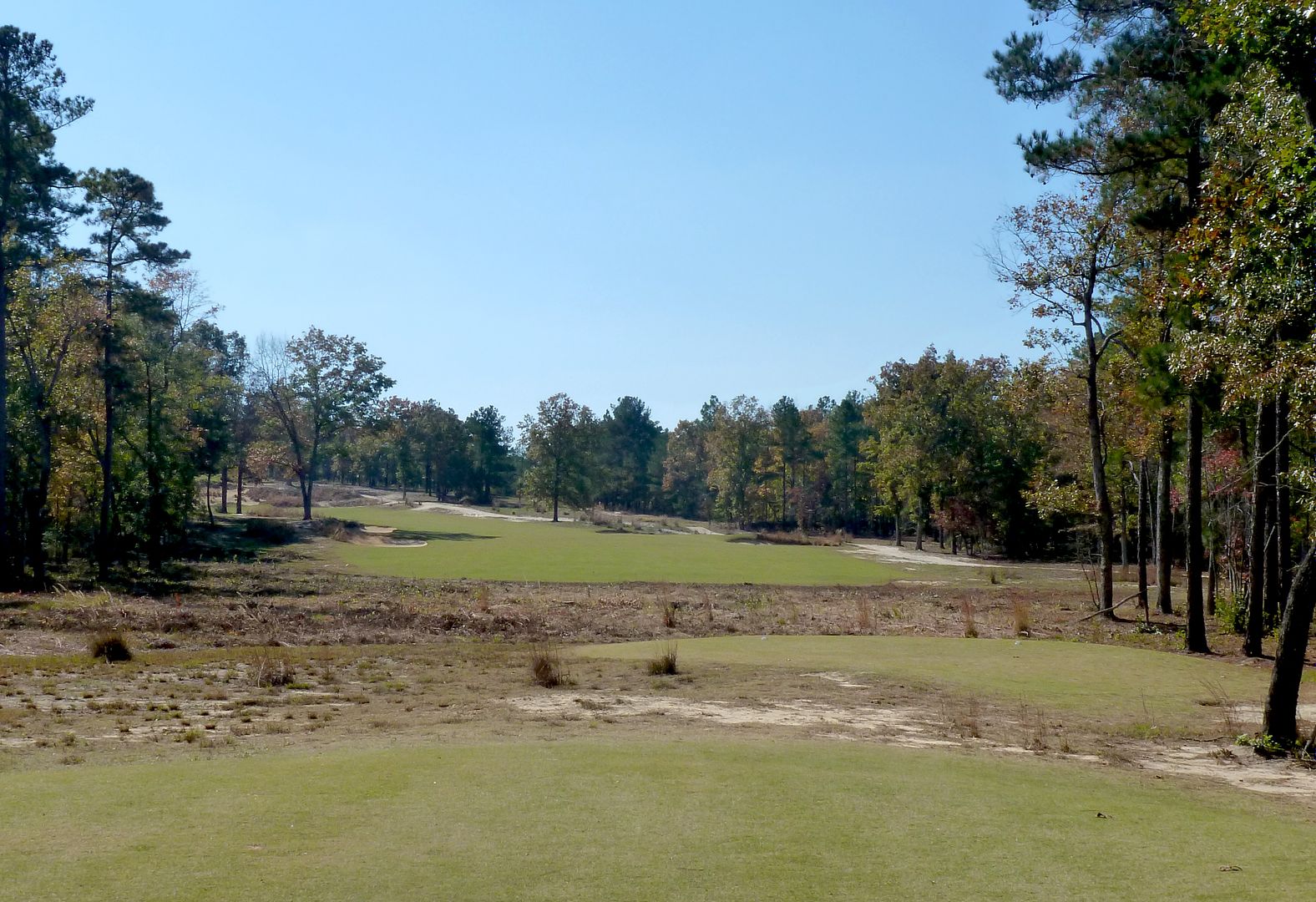
Middle tee view. A much better angle.

About 265 yards from the green. Up the hill and into the wind there is no chance of getting home from here. But, the question is whether or not to try to carry the 'hell's half acre' bunker in the centre of the fairway -- it's about a 185 yard carry.
The lay-up is simple, provided one is willing to lay back. The fairway gets narrower and narrower the closer the player gets to the centre bunker. Lay-up to 140 yards and the fairway is wide... 110 yards, not so much.
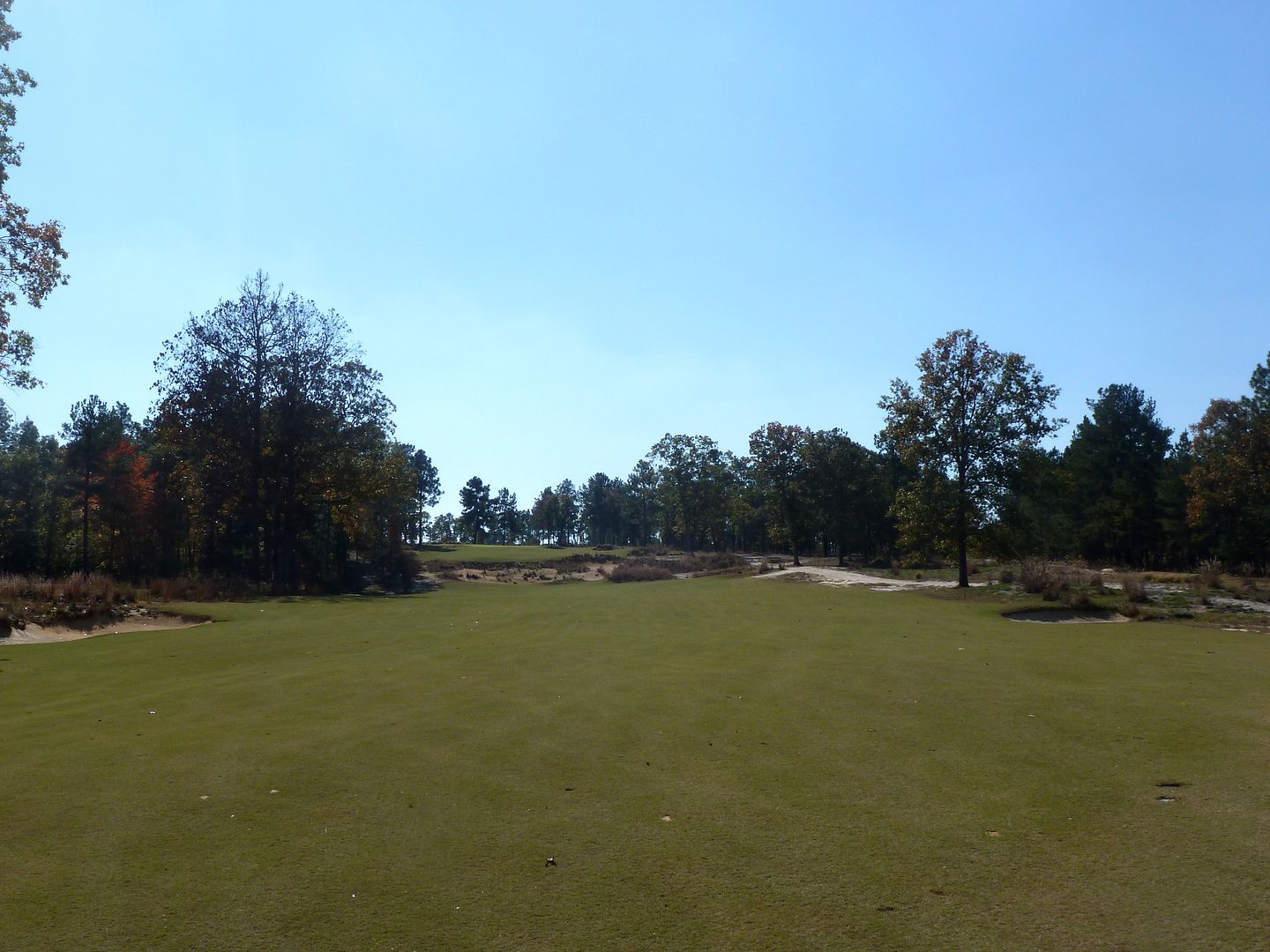
From the left side of the fairway, 240 yards out. Still tough to reach the green, but now only about 160 yards to get over the bunker. You have to go for it from here. Or do you?
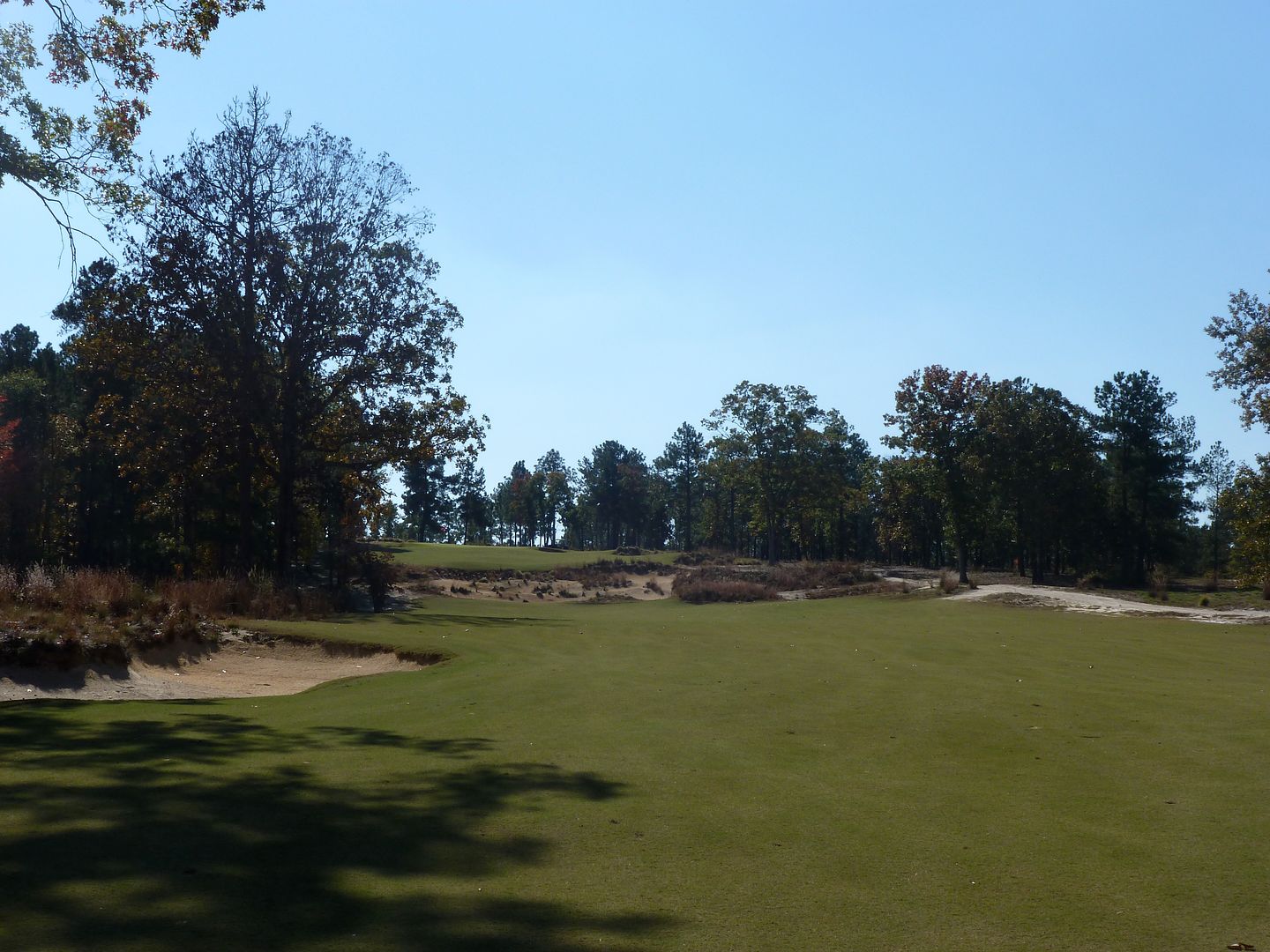
The fairway narrows the closer one gets to the bunker on the lay-up.
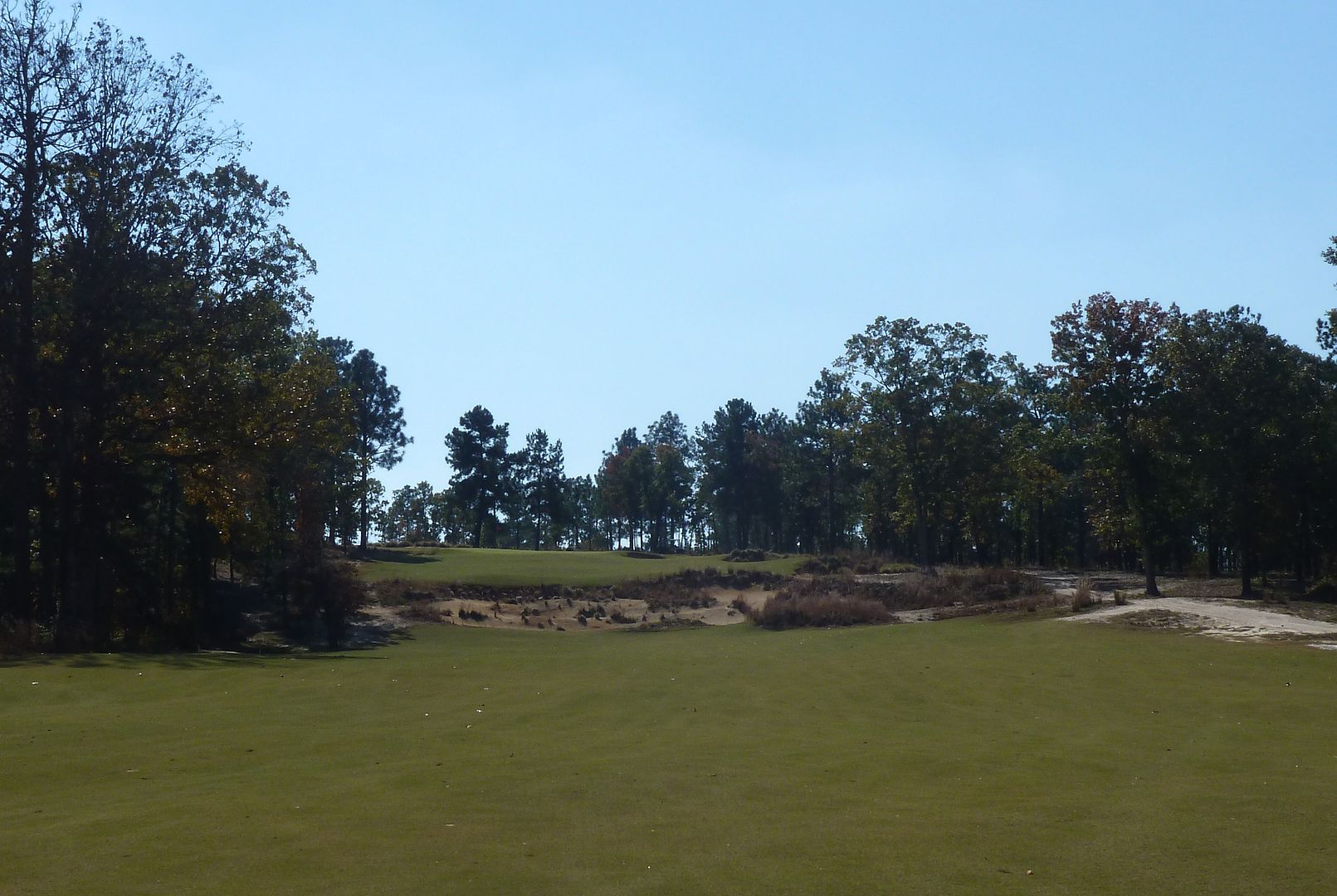
From 125 yards out -- not pretty. A lay-up closer to the green than this and the approach is completely blind.
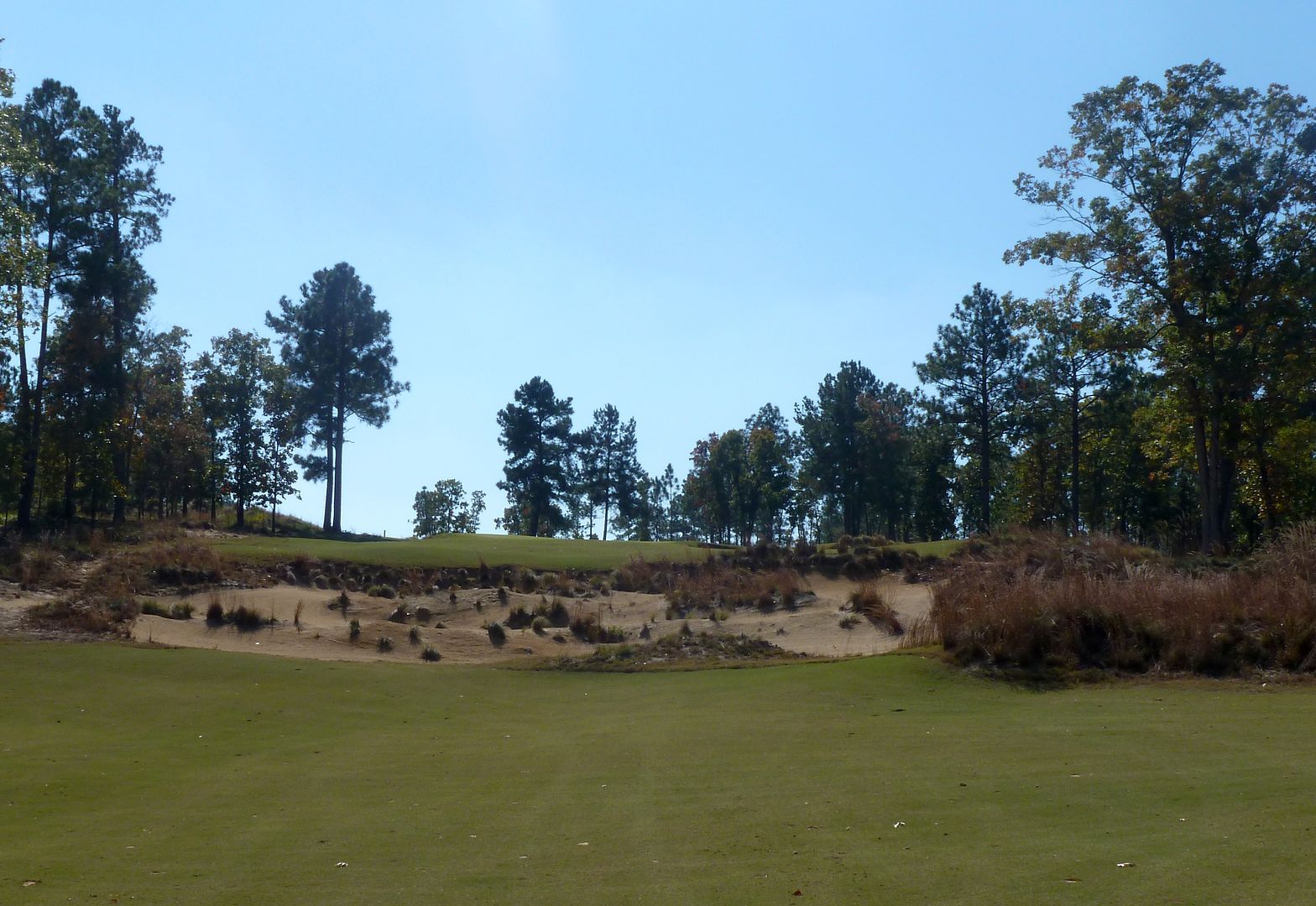
The hell's half acre bunker.
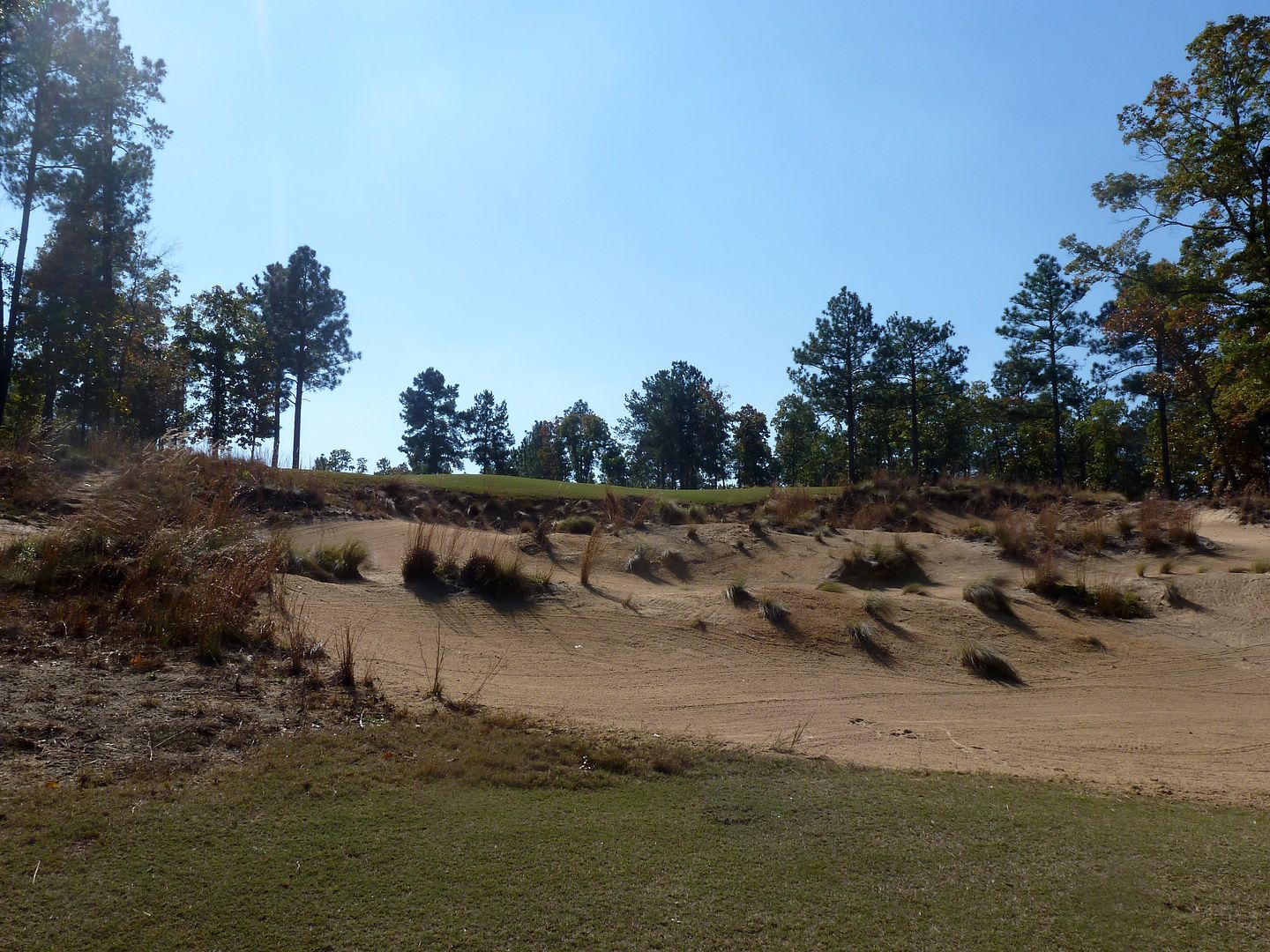
Two-tiered green sloping severely back-to-front and with a false-front.

From 18 tee.

Hole 18: Par 4, 428 Yards
18 plays in the same direction as 17 and 1 and is straight into the wind. There is not a lot of definition from the tee, but the line is just left of the fairway bunker. Tee shots played up the left wil have a shorter approach and perhaps a slightly preferred angle into the green. A bunker / waste area crosses the fairway about 280 yards from the tee.
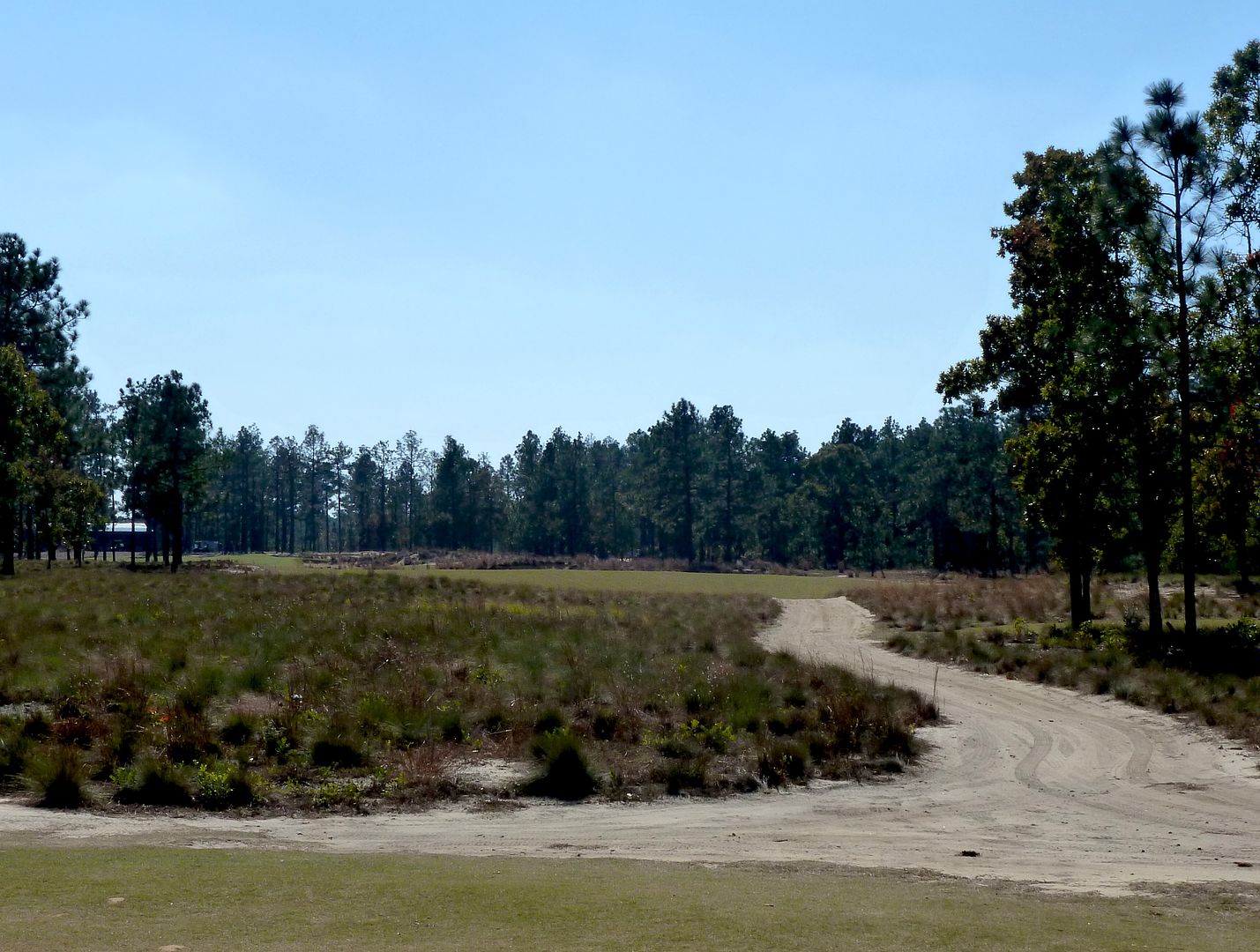
The approach is one of the most demanding on the course. The green (which may be the wildest on the course, other than 3) is open in front but is flanked by deep bunkers / waste areas.
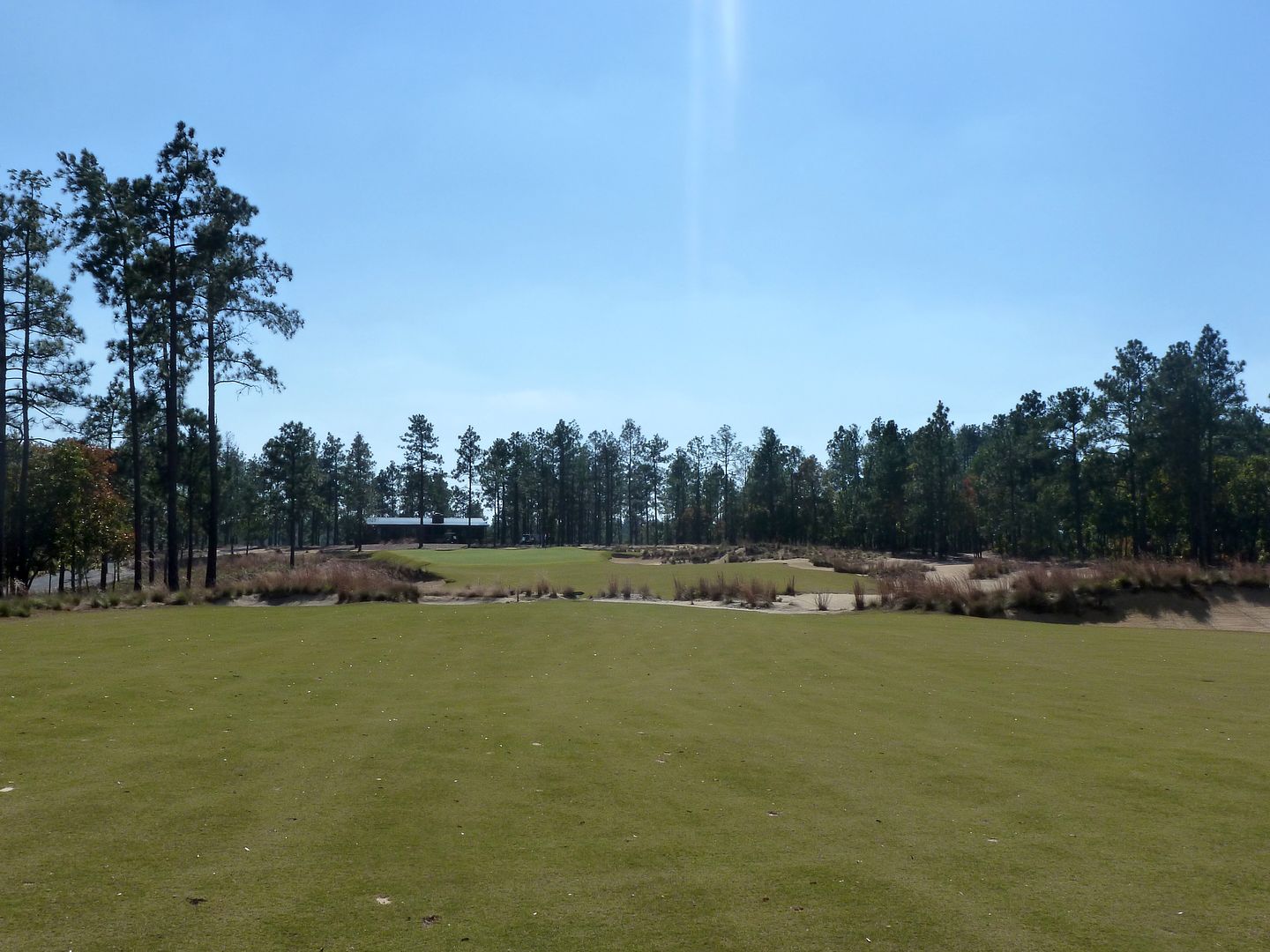

From 50 yards short of the green.
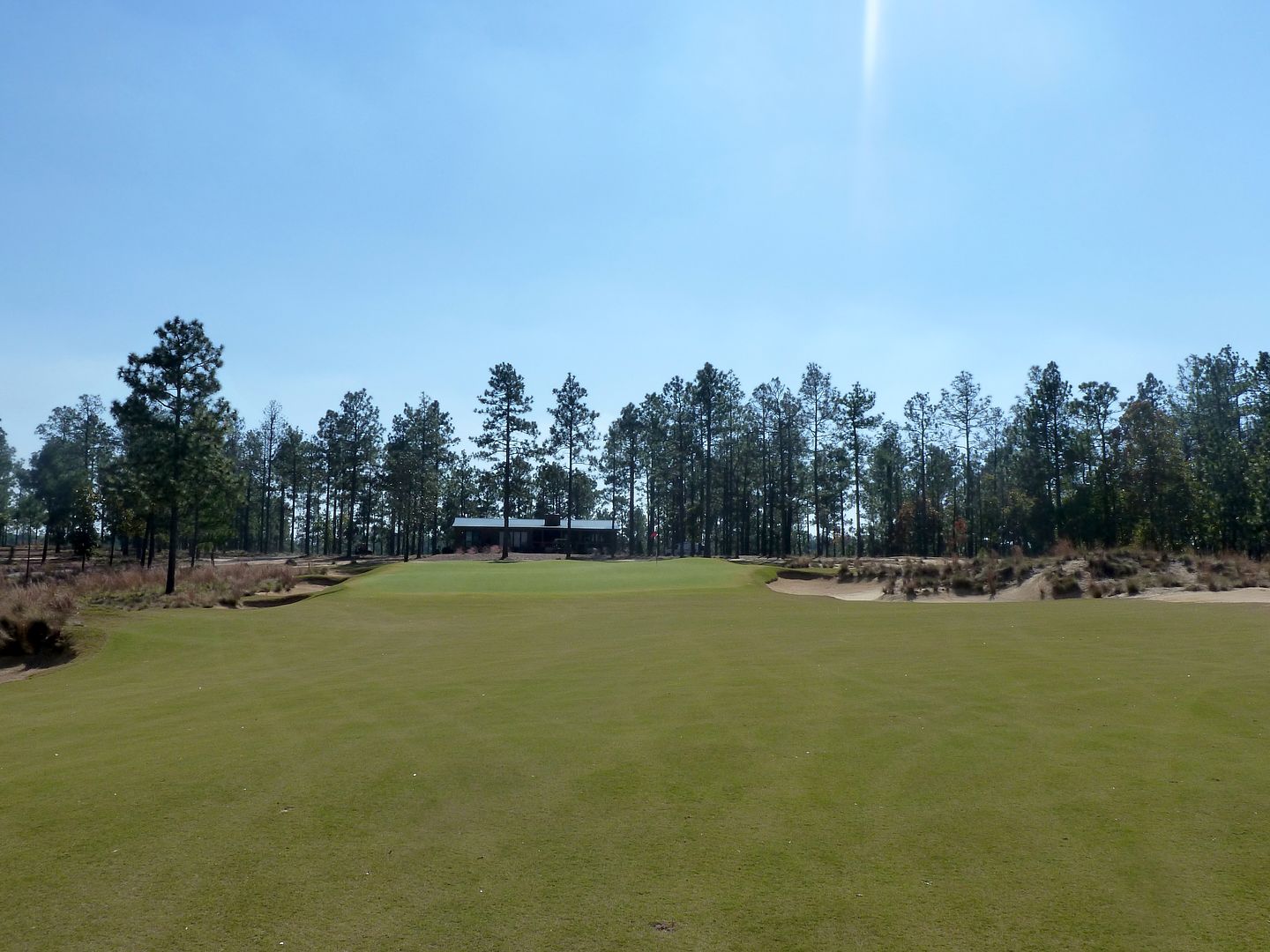
With increased contrast some of the wild slopes of the 18th green are seen.
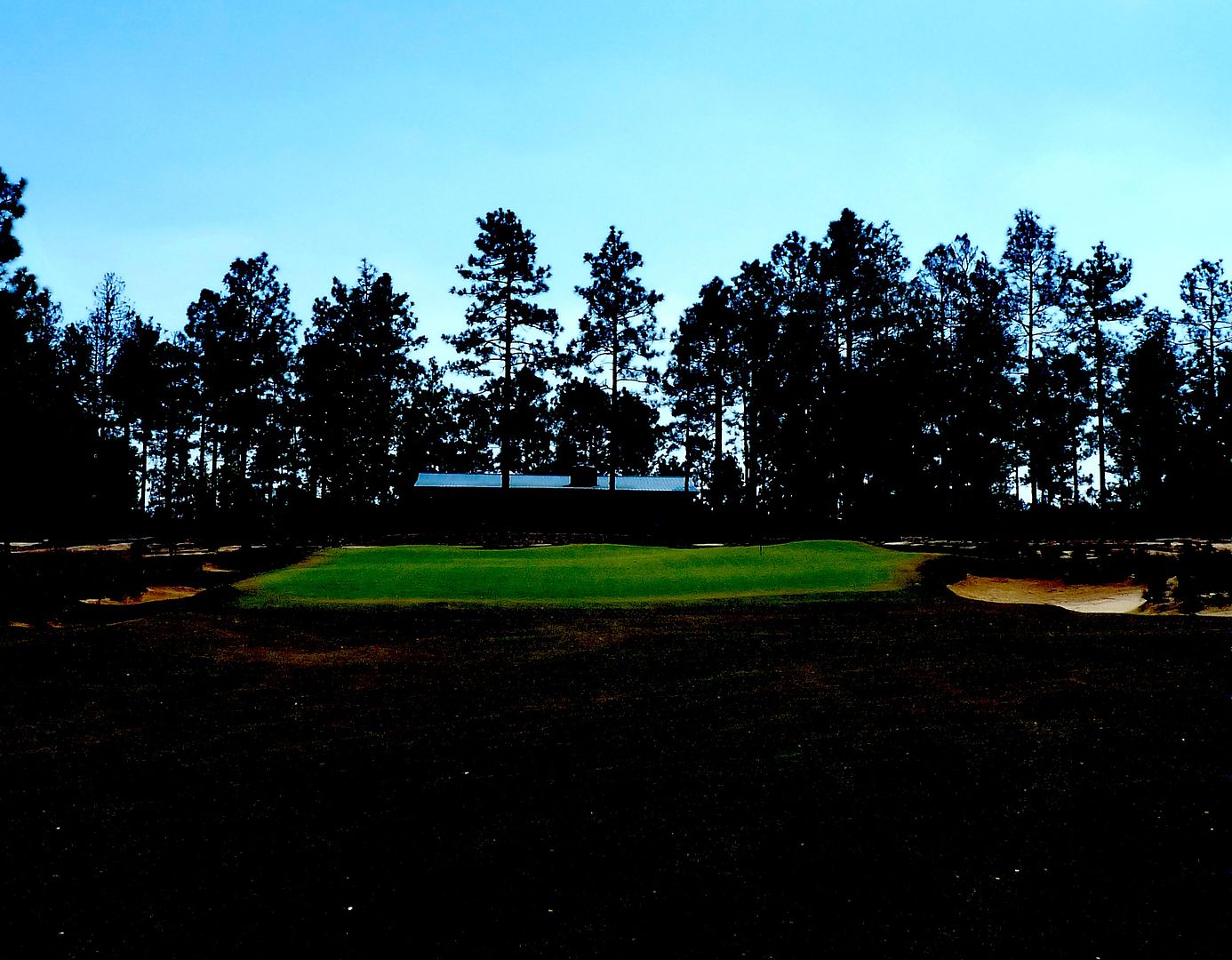
Missing the green to the right can be really bad news.
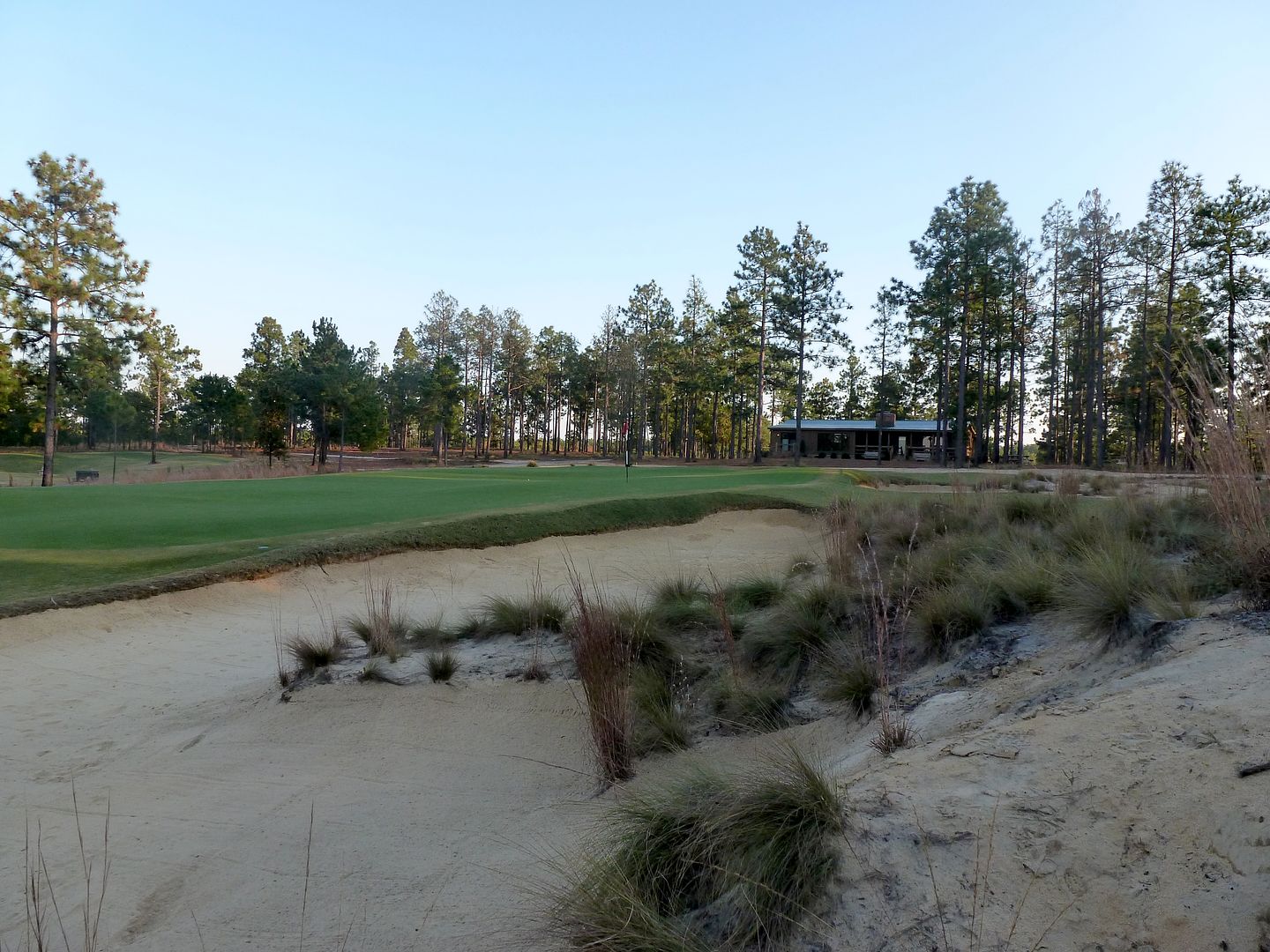
Looking back down 18. Good news is that the 1st tee is only about 100 feet away!
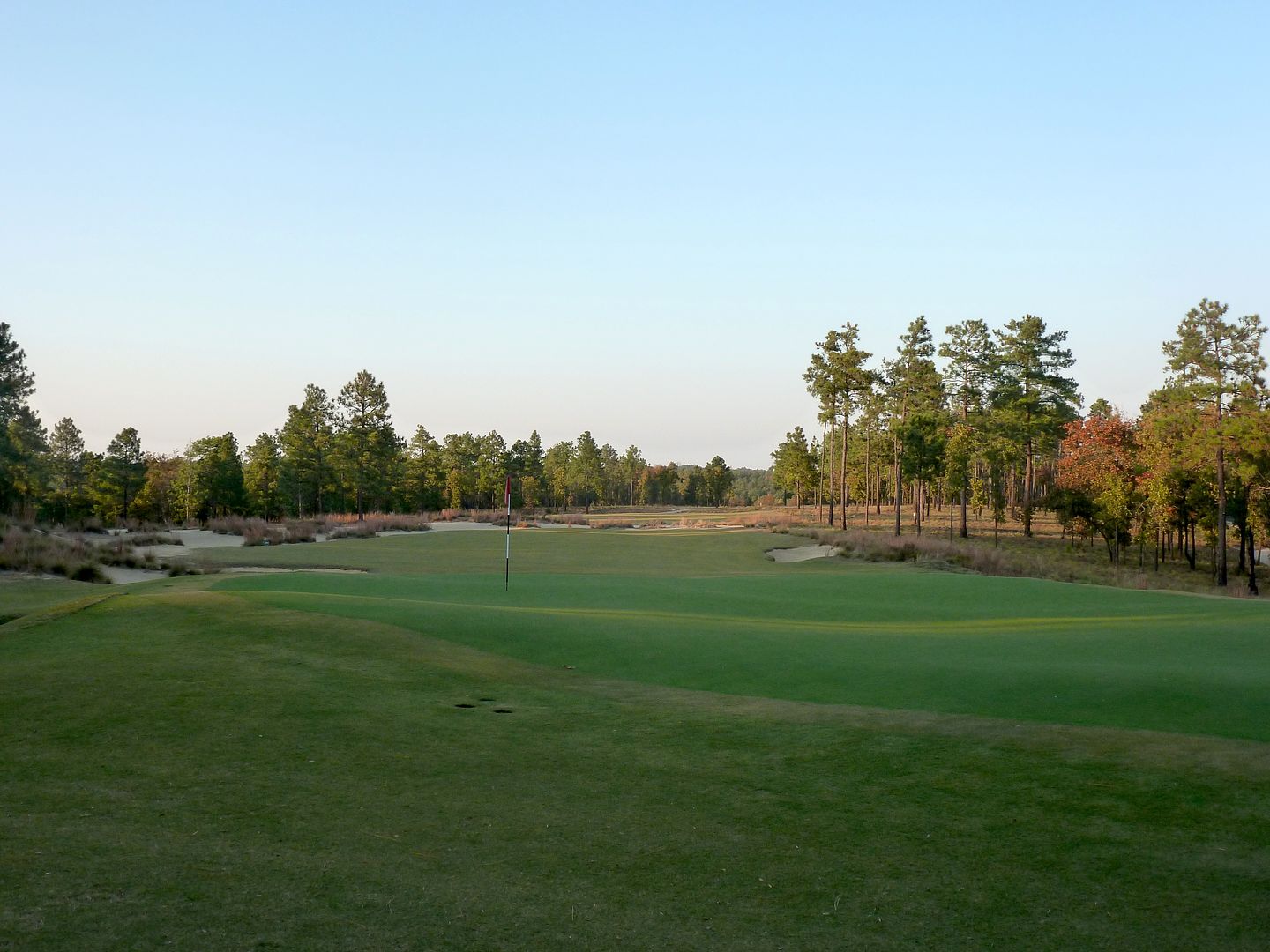

Thank you for a thoughtful review of this fine golf course.
ReplyDeleteIt seems a stiff test by your account.
Not good. Pompous staff.
ReplyDeleteOnly fairway yardages are the 150yd posts on the left/right of the fairway. No pin sheet. No flag color differentiation for pin placement. No SkyCaddie usage. My opinion, based on the staff's attitude when we asked, is that they try to push the caddie option. What course doesn't have a yardage book?
We always use caddie's for #2 and the Blue Monster and we are very glad we didn't for Dormie - another $400 bucks for the group for a course that isn't very different from Tobacco Road.
I've played at top ranked facilities all around the country and the staff at Dormie are among the worst I've ever encountered.
Save your money. There are a ton of other wonderful golf courses in the area that cost less and the staff is hands MUCH KINDER and overall appreciative of your patronage. Not even a thank you for coming out and spending $460 - when 1/3 of the greens were sand covered.
Thanks!
Amendment: The staff at the turn house was very nice.
ReplyDelete